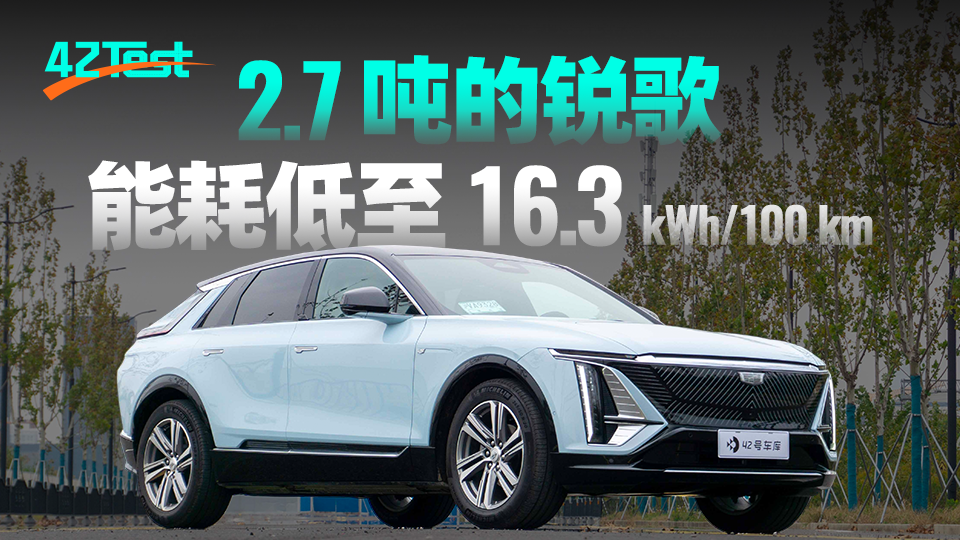On November 7th, the four-wheel-drive high-performance and luxury version of the Cadillac LYRIQ, the Rege, was finally unveiled. With this, all versions of the domestically produced Cadillac LYRIQ Rege have been released. Can Cadillac summon the “pure electric” dragon?
However, the four-wheel-drive high-performance and luxury version won’t be available for delivery until this month, and it costs 40,000 yuan more than the entry-level version. It is more attractive to users who pursue extreme performance.
Among all versions of the Cadillac LYRIQ, the 439,700 yuan rear-wheel-drive long-range luxury version is the highest-selling product. Although it is an entry-level model, it is already sufficient to meet the needs of most consumers in terms of configuration. In the LYRIQ’s previous press conference, we had a detailed analysis. Interested friends can click on this article: “Under the trend of rising prices for new energy, let’s take a look at those that don’t increase in price“.
Today, we are testing the Cadillac LYRIQ’s rear-wheel-drive long-range luxury version in 42Test. Let’s see how the first domestically produced electric SUV based on the Ultium platform performs. At the same time, as a joint venture luxury brand pure electric SUV costing over 400,000 yuan, what are the highlights in terms of endurance, performance, and handling?
Appearance: A Concept Car in Production
The Cadillac LYRIQ made its debut as a concept car at the 2021 Shanghai Auto Show in April. The LYRIQ was also the first to introduce a new generation of family-style front face.
On the production car, the design of the Cadillac LYRIQ is almost 1:1 with the design of the concept car, except for the media backflow mirror design on the concept car. Other than that, the front face design and side design are almost indistinguishable from the concept car.
The length, width, and height of the Cadillac LYRIQ are 5,003 x 1,977 x 1,637 mm, and the overall size of the car is quite similar to that of mid-to-large SUVs like the BMW X5L, making it appear very large. At first glance, the LYRIQ gives off a very imposing feel, and the combination with the dusk blue paint adds a sense of technology.
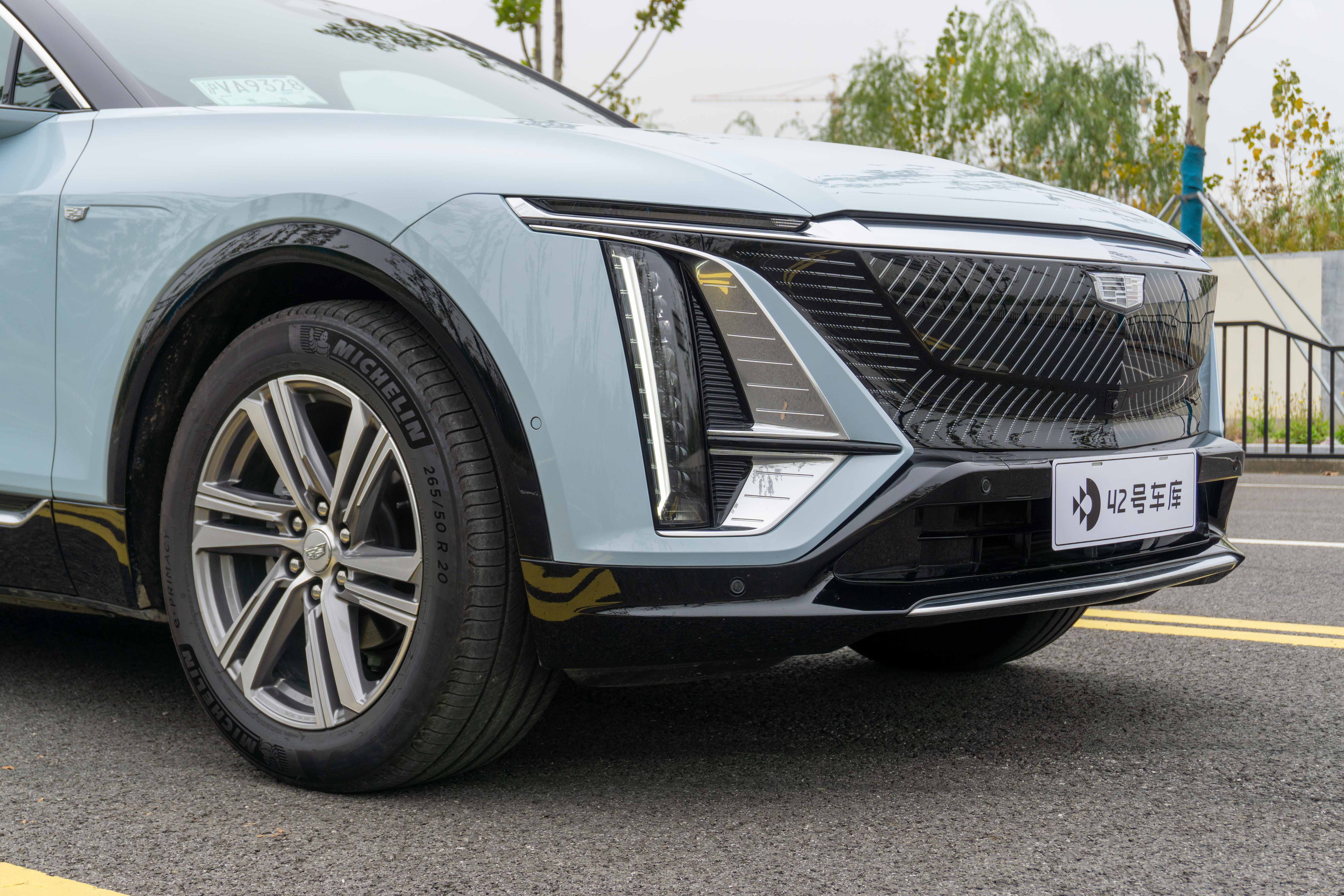
In terms of the front design, the new generation of Cadillac’s exterior design also incorporates a split headlight design, as well as a closed front face design. Unlike other cars, the horizontal light strip above the LYRIQ is only set as the turn signal and does not light up together with the daytime running lights below.
The vertical daytime running lights inherit the classic lightning-shaped design. To the right of the daytime running lights are 9 LED high and low beam lens lamp groups. After the vehicle is unlocked, the front lights have a very eye-catching effect.
First, the middle emblem is lit up, followed by the grille gradually lighting up from the middle to both sides, and then the 9 LED lamp groups are lit up from bottom to top. During the process of the headlights turning on, the LYRIQ attracted many onlookers, adding to the overall sense of ceremony. At that moment, I even felt that the Audi headlight factory’s reputation was eclipsed.
Unfortunately, due to reasons related to Chinese laws, the mesh grille that can emit light cannot be lit while driving the vehicle. It only has a dynamic light effect after the vehicle is unlocked.
In addition, the front face of Cadillac LYRIQ has two versions. The rear-wheel drive long-range luxury version and the rear-wheel drive long-range distinguished version come standard with the Guangyao package, which uses a large number of chrome-plated decorations on the vehicle’s appearance. The Guangyao package can be selected for the top-of-the-line sports version, as well as the Sports package.
Under the Sports package, the chrome trim strips on the vehicle are replaced with smoke-black designs, making the front face more aggressive. And the luminous light strip of the mesh grille has also changed, replacing the stripe pattern with a flying-wing pattern, however, the luminous area has decreased compared to the Guangyao package.
On the side of the body, the Cadillac LYRIQ is 5,003 mm long and has a wheelbase of 3,094 mm, plus no roof rack, so the entire side of the vehicle looks very slender and different from the traditional SUV styling.
As an electric vehicle, the Cadillac LYRIQ also has a front trunk design with a volume of 35 L. After opening the front hood, there is a cover on the front trunk, which ensures good privacy after placing items.
In daily use, the front trunk space can hold two standard-sized backpacks. If not carrying backpacks, it is also suitable for carrying a portable charging gun in daily use.
Although LYRIQ is an SUV, it does not come with a conventional luggage rack on the roof. In addition, the sleek design gives LYRIQ a feeling of a larger wagon.
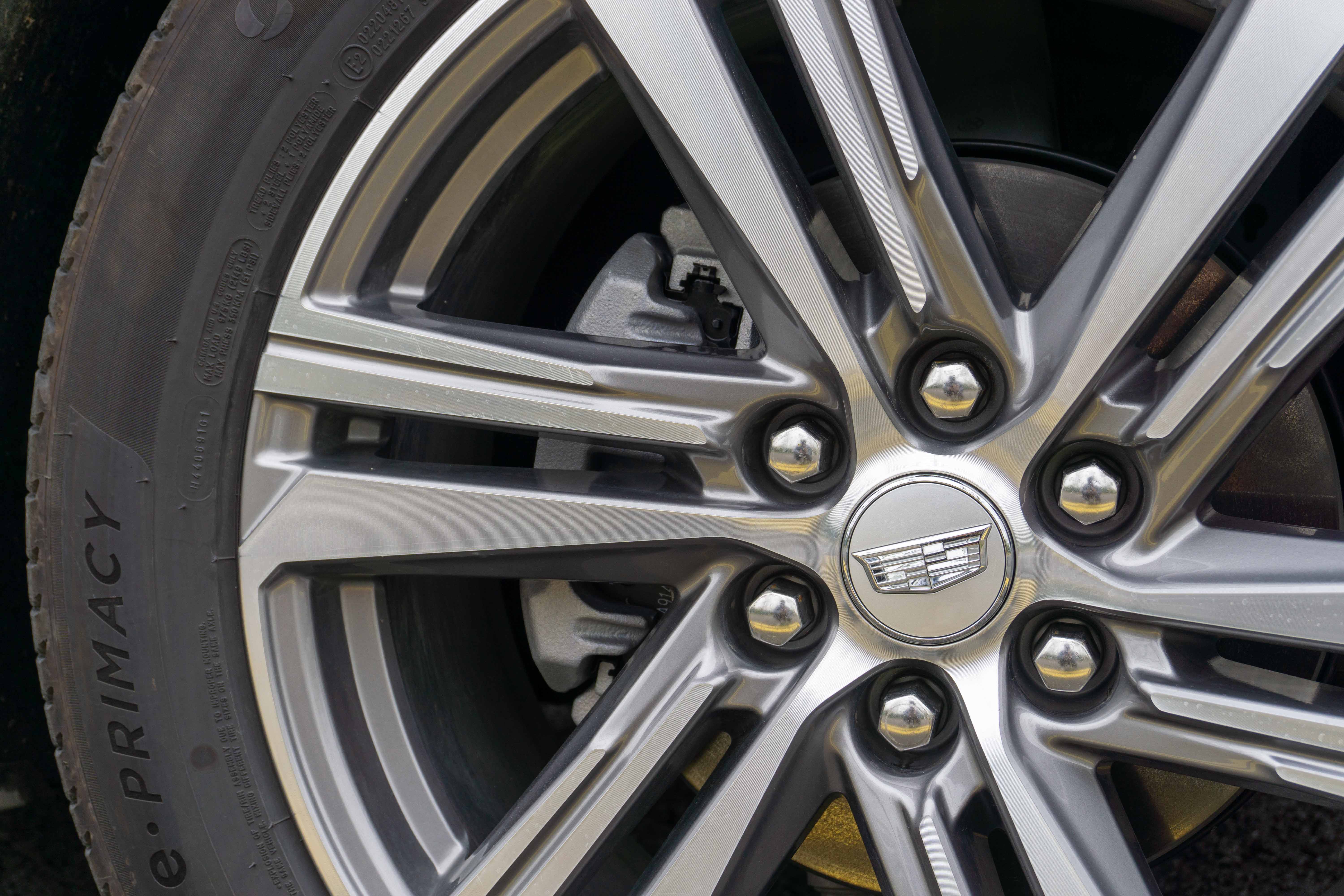
As for tire specifications, LYRIQ uses Michelin 265/50 R20 self-sealing tires, with a 6-spoke wheel design, but whether it’s the luxury version, the premium version, or the four-wheel-drive high performance version, none of them are equipped with the 22-inch Dynamic Split-Spoke Reverse Rim wheel design available in the US market.
The visual effect is not so extreme, but the advantage is that a larger aspect ratio can bring a more comfortable ride experience, and at the same time, it can reduce the occurrence of tire bulges on Chinese roads.
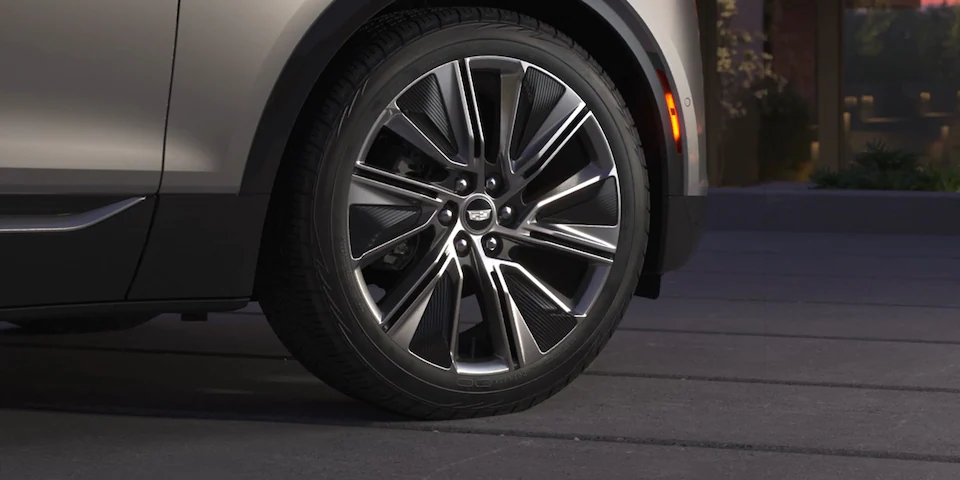
LYRIQ’s doors are all push-open design, pressing the door handle will automatically open the door leaving a gap.
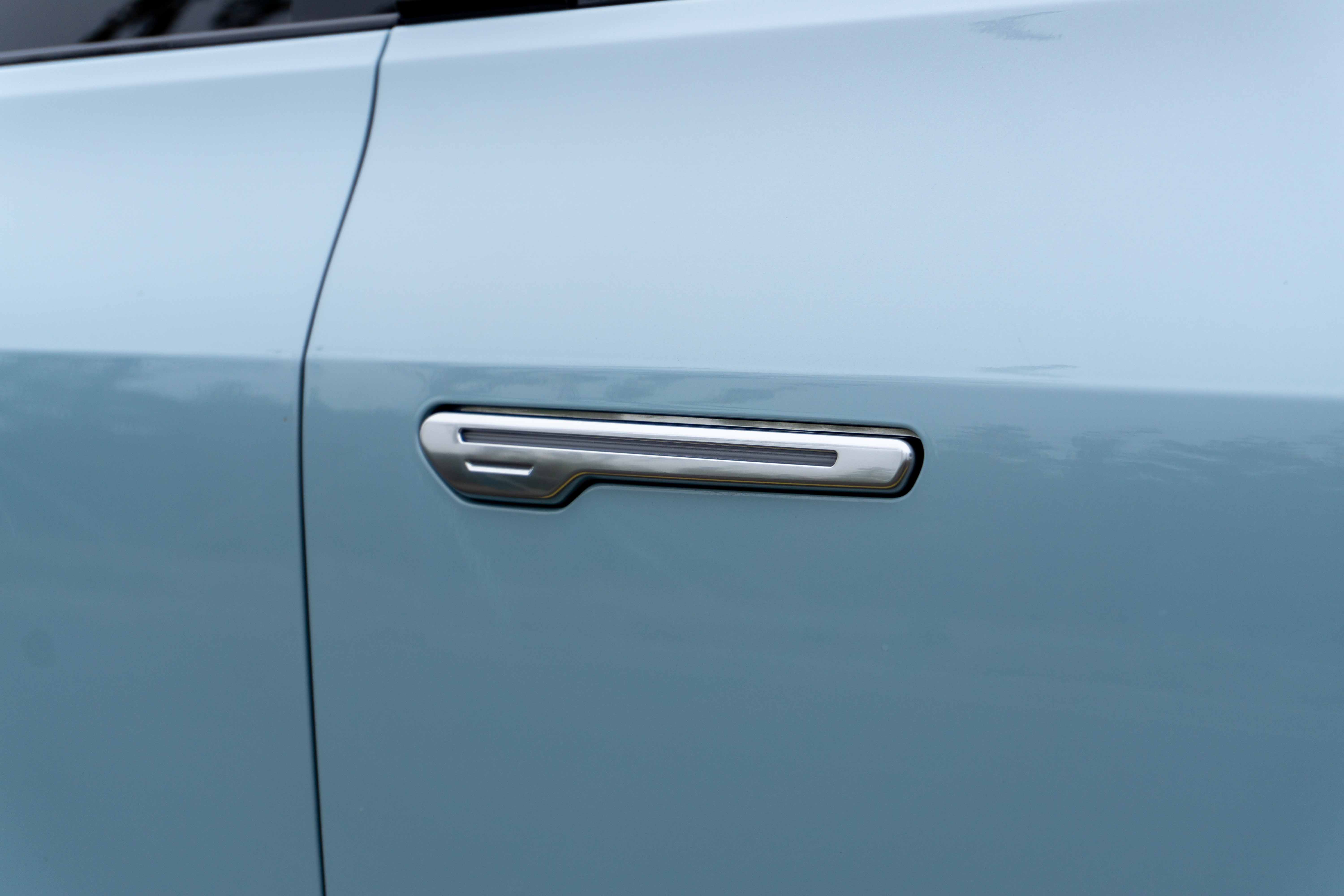
For passengers to open and close the door, LYRIQ has a small blade-like design under the B-pillar of the vehicle. This design is exactly the same as that on the Ford Mustang Mach-E.
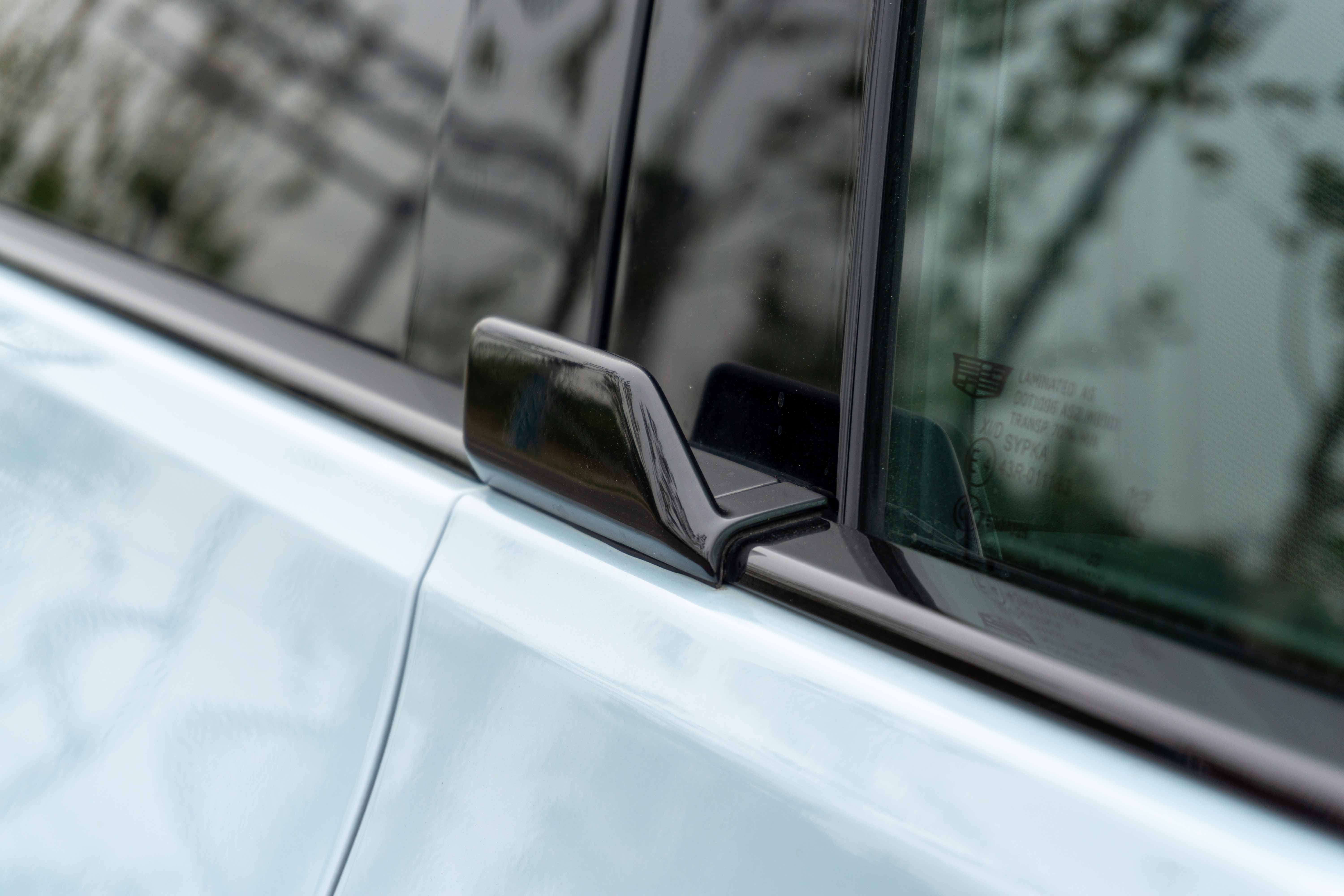
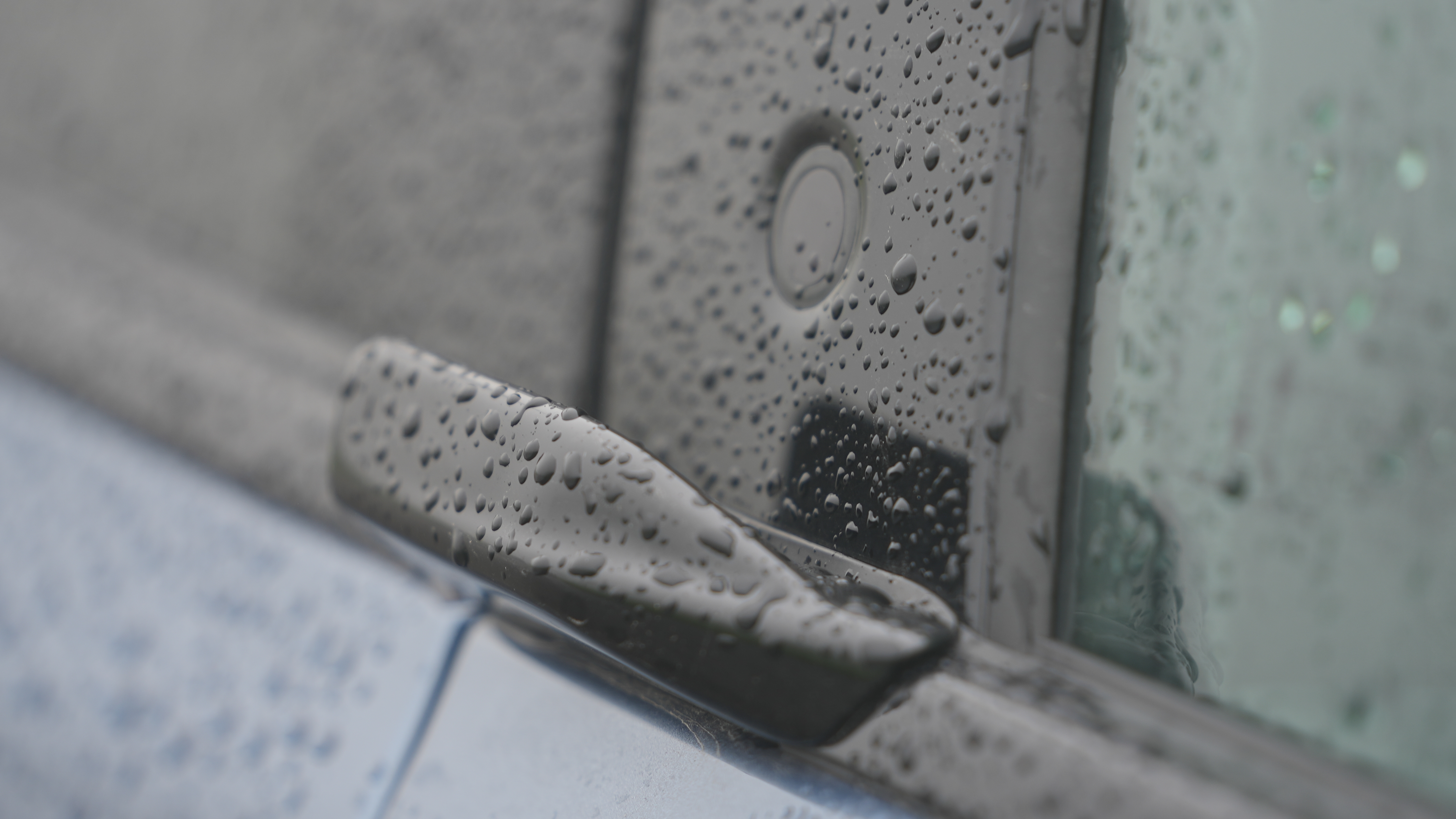
The main reason for using the small blade-like design is because the vehicle is equipped with a hidden door handle design, allowing users to have a suitable position to open the door and prevent the hand from being caught in the door panel due to accidents.
To completely eliminate the hidden danger of getting hands caught in the door, LYRIQ, like Mach-E, has an electric pop-out pin on the inner side of the lower part of the door panel which only retracts after the door is open to a certain angle.

The most eye-catching part of LYRIQ’s side design is the taillight strip extending to the D-pillar. This taillight strip is a rear turn signal light for LYRIQ, and the design is exactly the same as that of a concept car, inheriting the classic wing-shaped design of Cadillac.
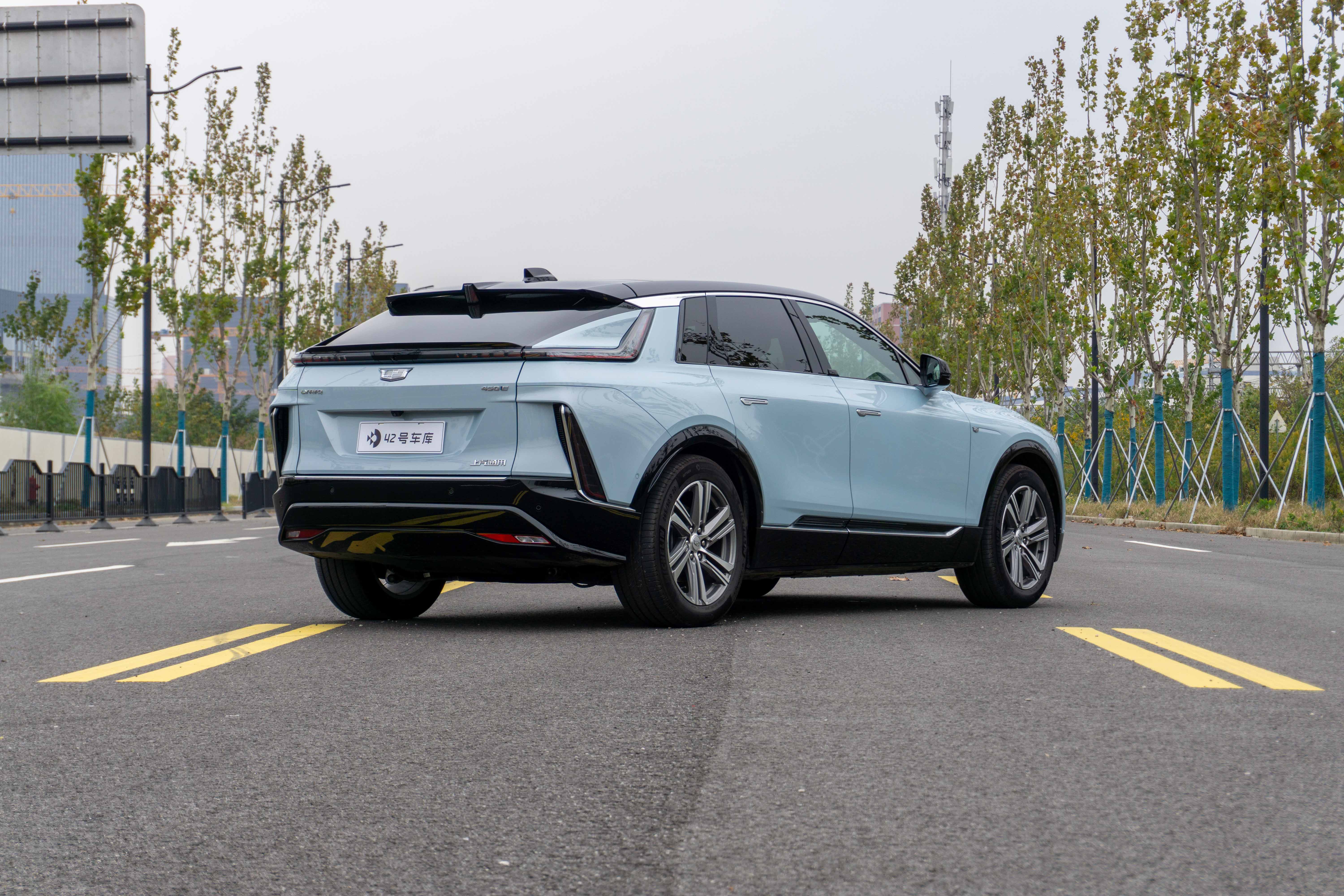
LYRIQ’s tail design is also very powerful and hierarchical. The power of LYRIQ lies in the use of a lot of straight lines in the tail, especially the collision of horizontal and vertical lines can better highlight the vehicle’s power.
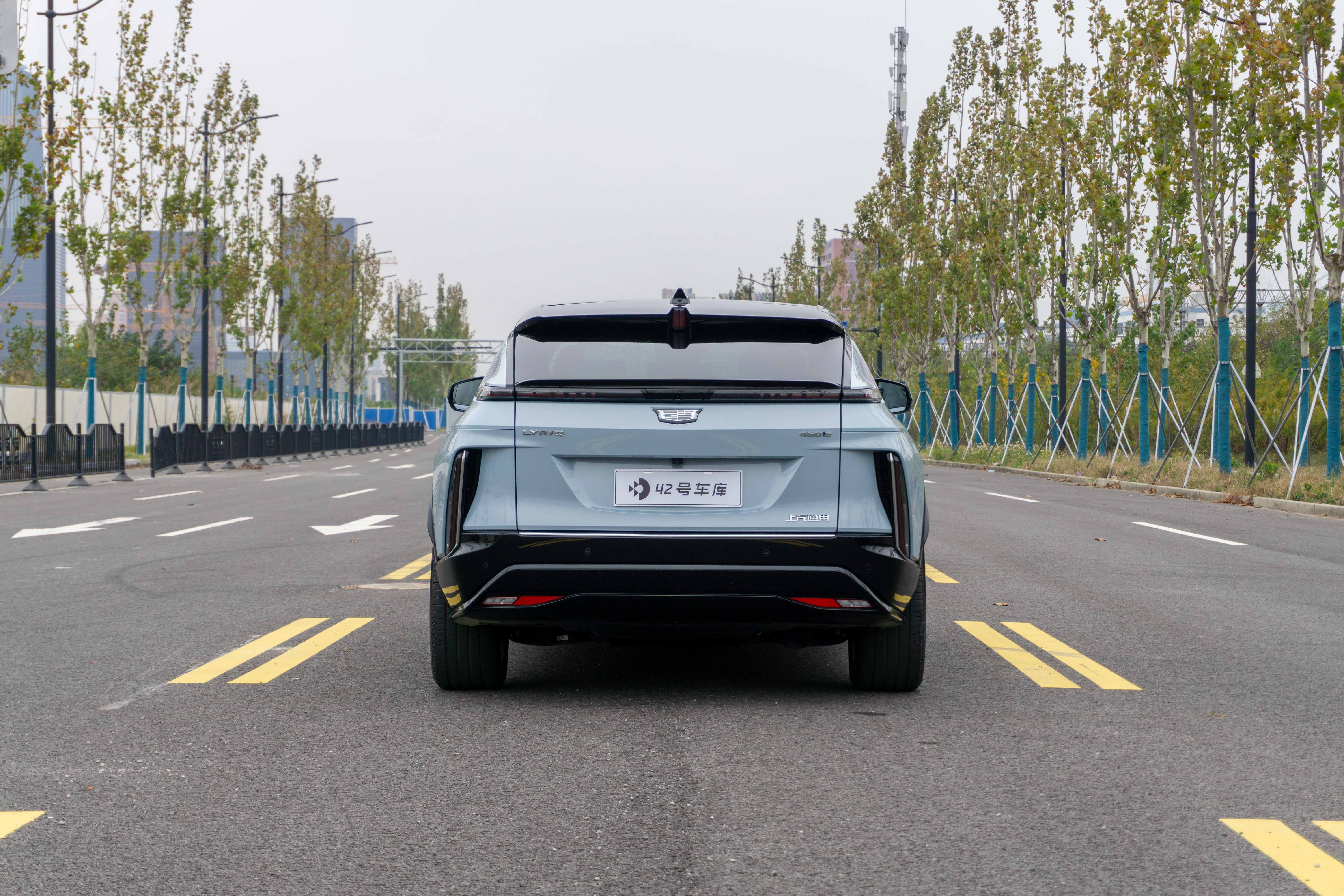
Secondly, there is a sense of hierarchy in LYRIQ’s tail design. LYRIQ has a double tail wing design at the rear, which is very popular in sloping-back SUVs lately, such as Porsche Cayenne Coupe and Aston Martin DBX, which looks very dynamic.
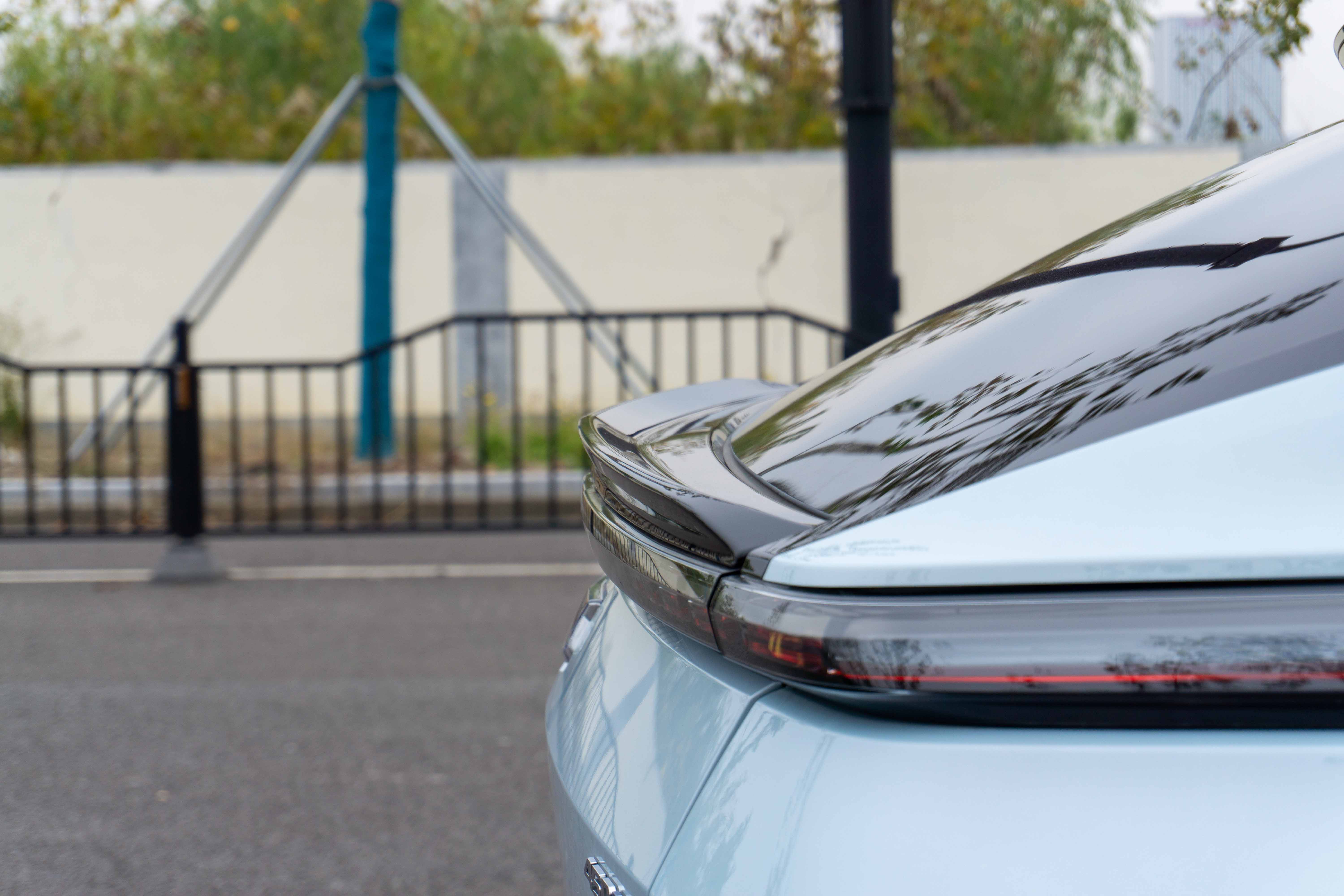
The place where the tail emphasizes hierarchy is also the high-level brake light design that corresponds to the car’s roof shark fin antenna. While having a warning effect, it can cleverly embed the function into the body design.
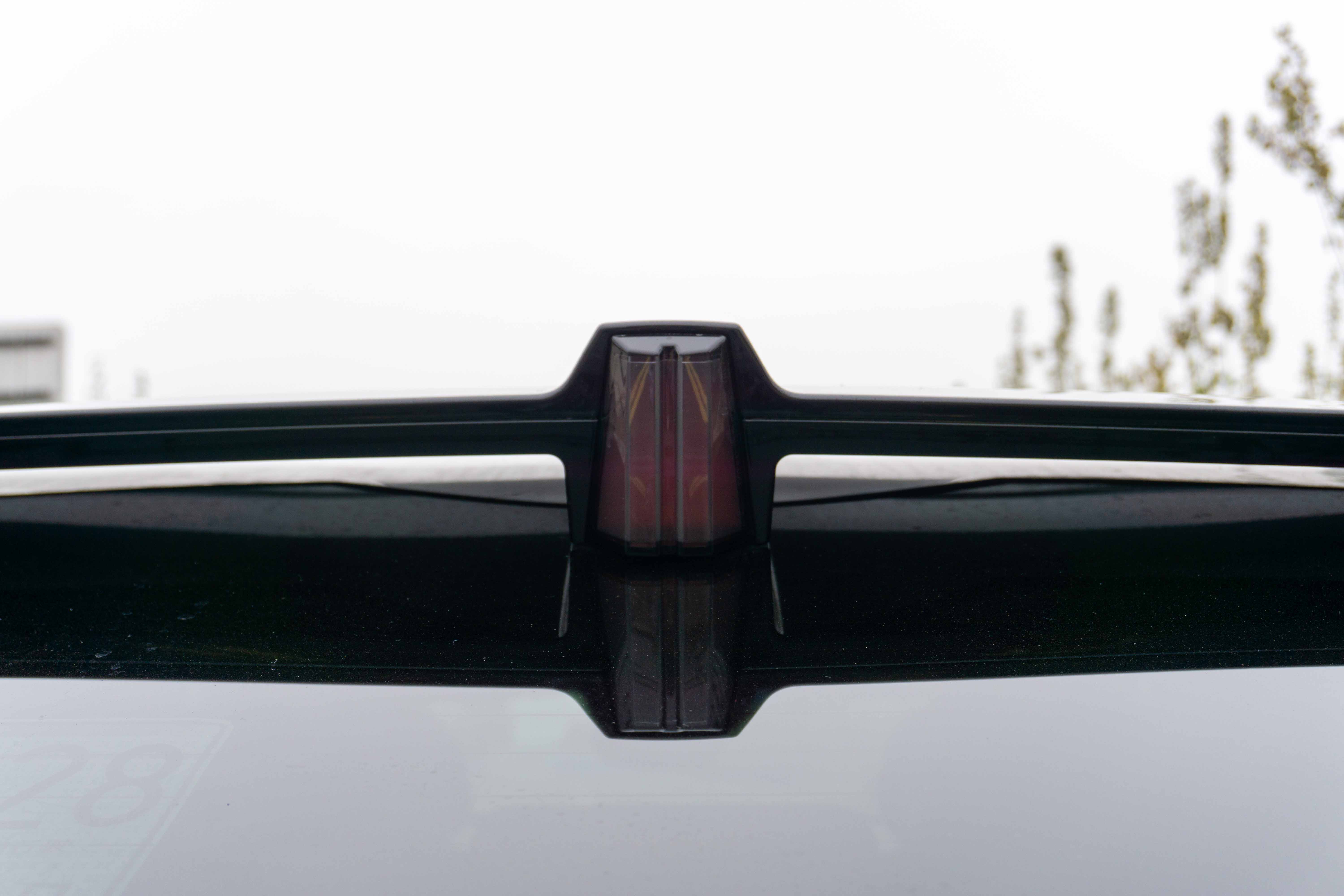
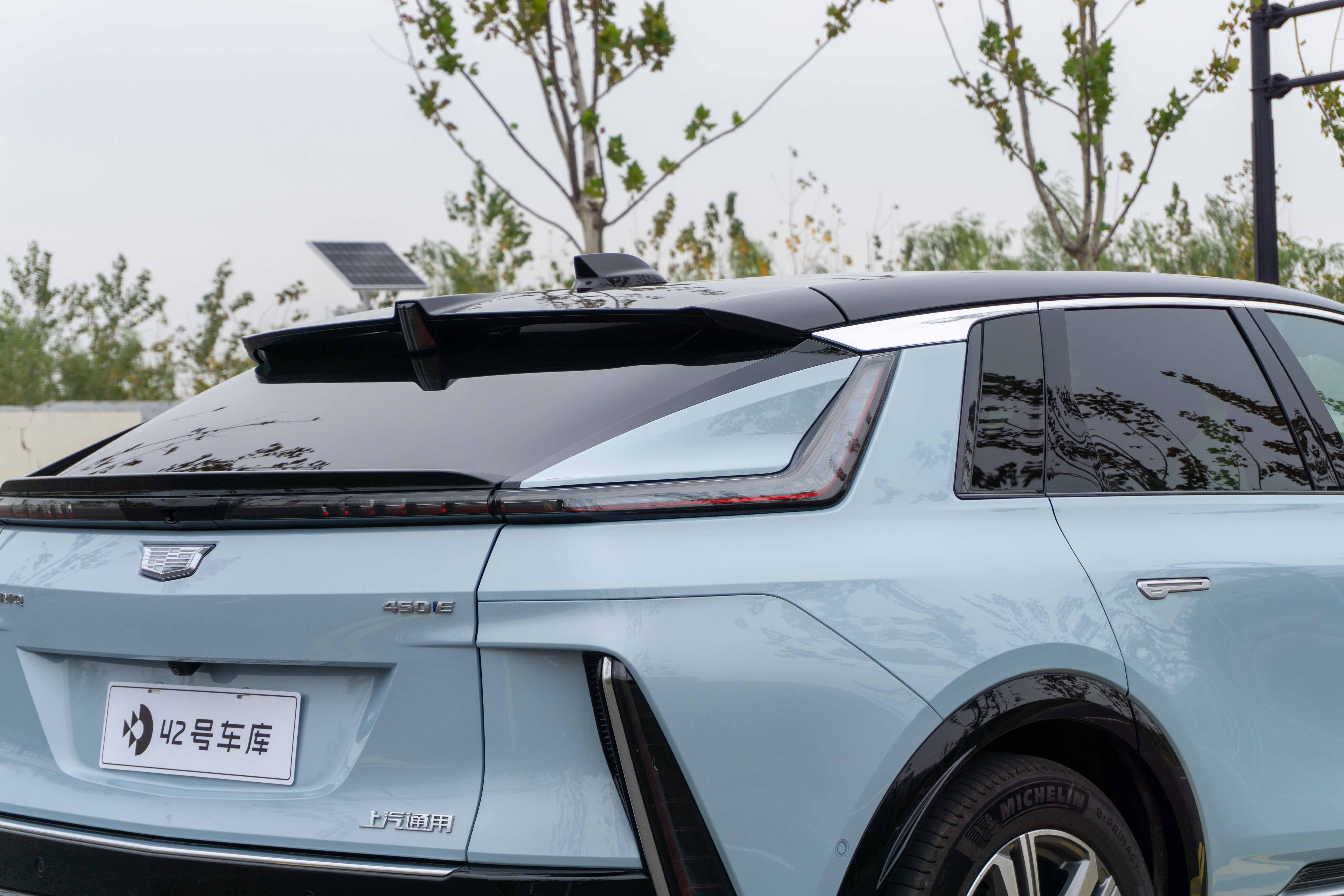
The remote trunk opening button of Cadillac LYRIQ is not normally located above the license plate frame, but integrated in the logo. Simply press the lower part of the logo to open the trunk, which may not be easy for first-time users to find.
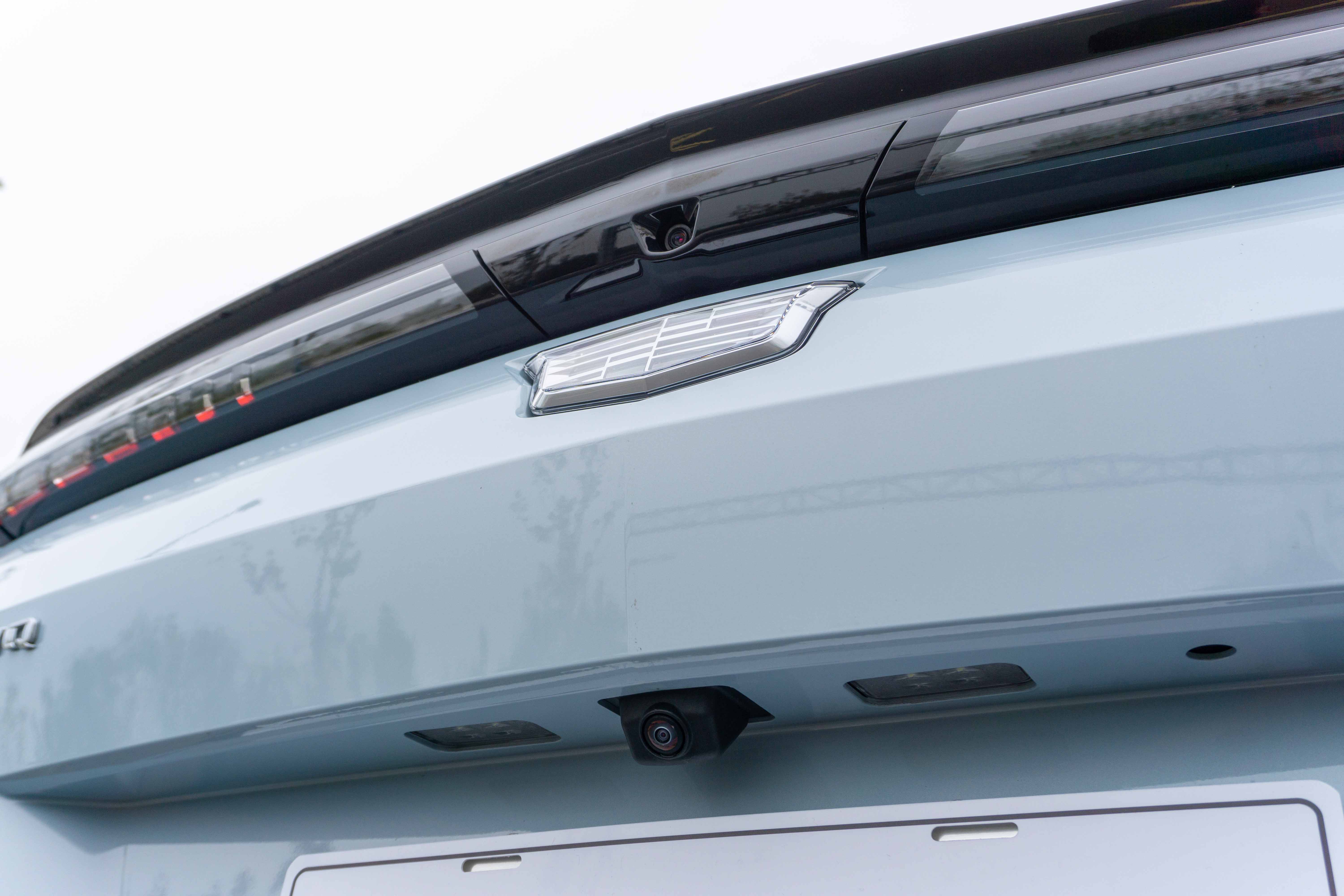
After the trunk is opened, a spacious volume can be obtained. The official claimed capacity of LYRIQ is 521 L. After measurement, the trunk space of LYRIQ is excellent in both longitudinal and lateral directions.
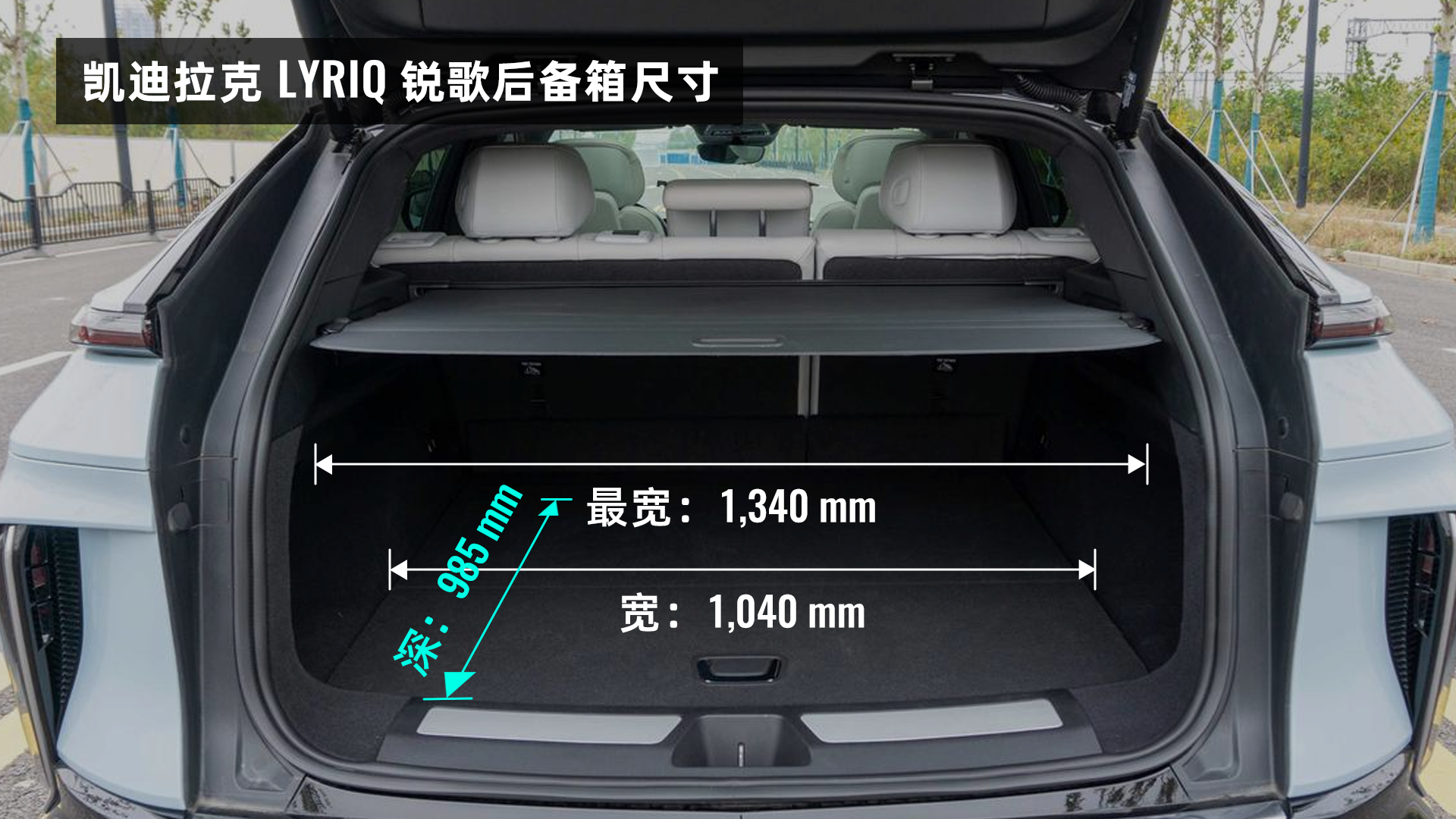
Overall, Cadillac LYRIQ still inherits the classic design elements of Cadillac’s 120-year history in appearance. These iconic elements can make people recognize that this is an SUV from Cadillac at a glance after getting on the car.
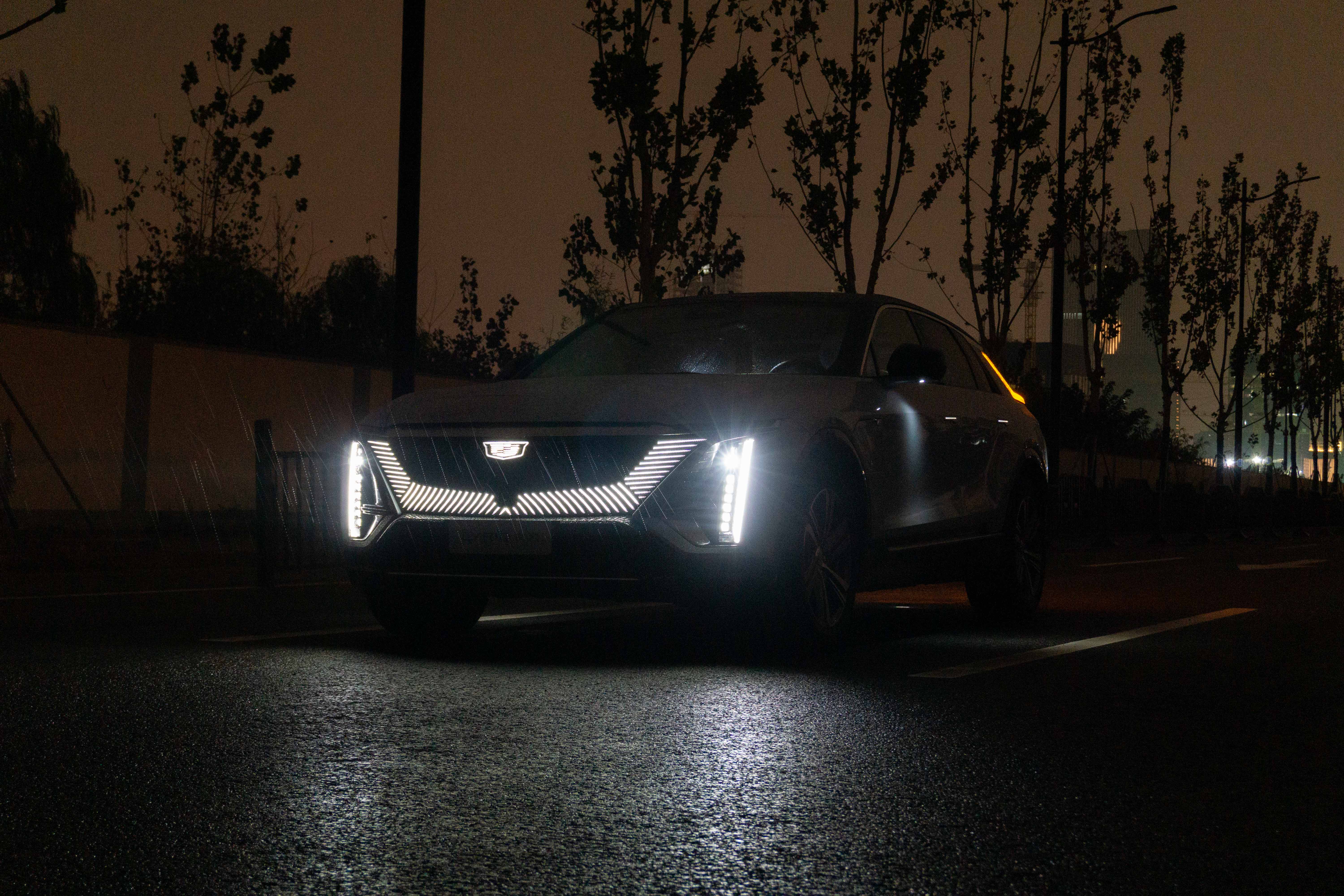
However, under the blessing of the classic elements, this new era of pure electric Cadillac also uses a lot of innovative elements. The illuminated grille design, the front and rear complementary lightning lamp group design, hidden door handles, and contouring turning lights to D-pillars, etc. Continuing the design of the concept car also makes Cadillac LYRIQ open up a brand new design language in the new era. We will also see similar innovative designs in the new CT6 and CELESTIQ.
Cabin: The Continuation of American Luxury
At the mention of American luxury, leather wrapping, large sofas, and wooden interiors come to mind. These three elements are still valid on LYRIQ. And in addition to this, modern technology is added.
In terms of color matching, the Cadillac LYRIQ we test drove this time is equipped with the space-time crystal gray interior color, which is a color that I personally prefer and can present an elegant atmosphere. The downside is that this one, which sounds like a gray interior, is actually a white one, and requires more effort in later leather maintenance.
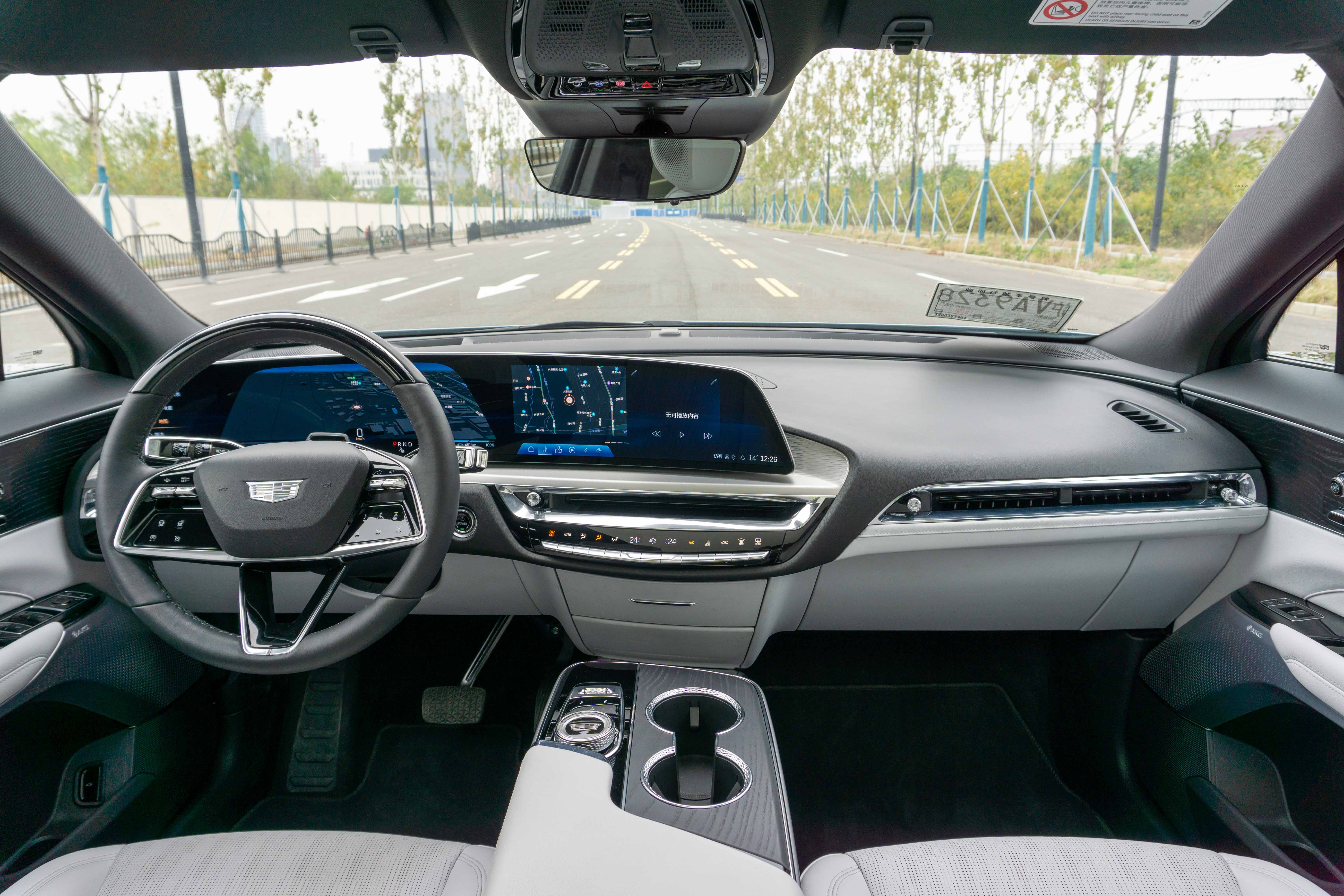
The most stunning part of LYRIQ’s interior is this 33-inch curved Ultra HD Retina display, with a resolution of 9K, a display accuracy of 271 PPI, and a dynamic contrast ratio of 100,000:1. This screen’s quality is not inferior to the current laptops and tablets on the market.
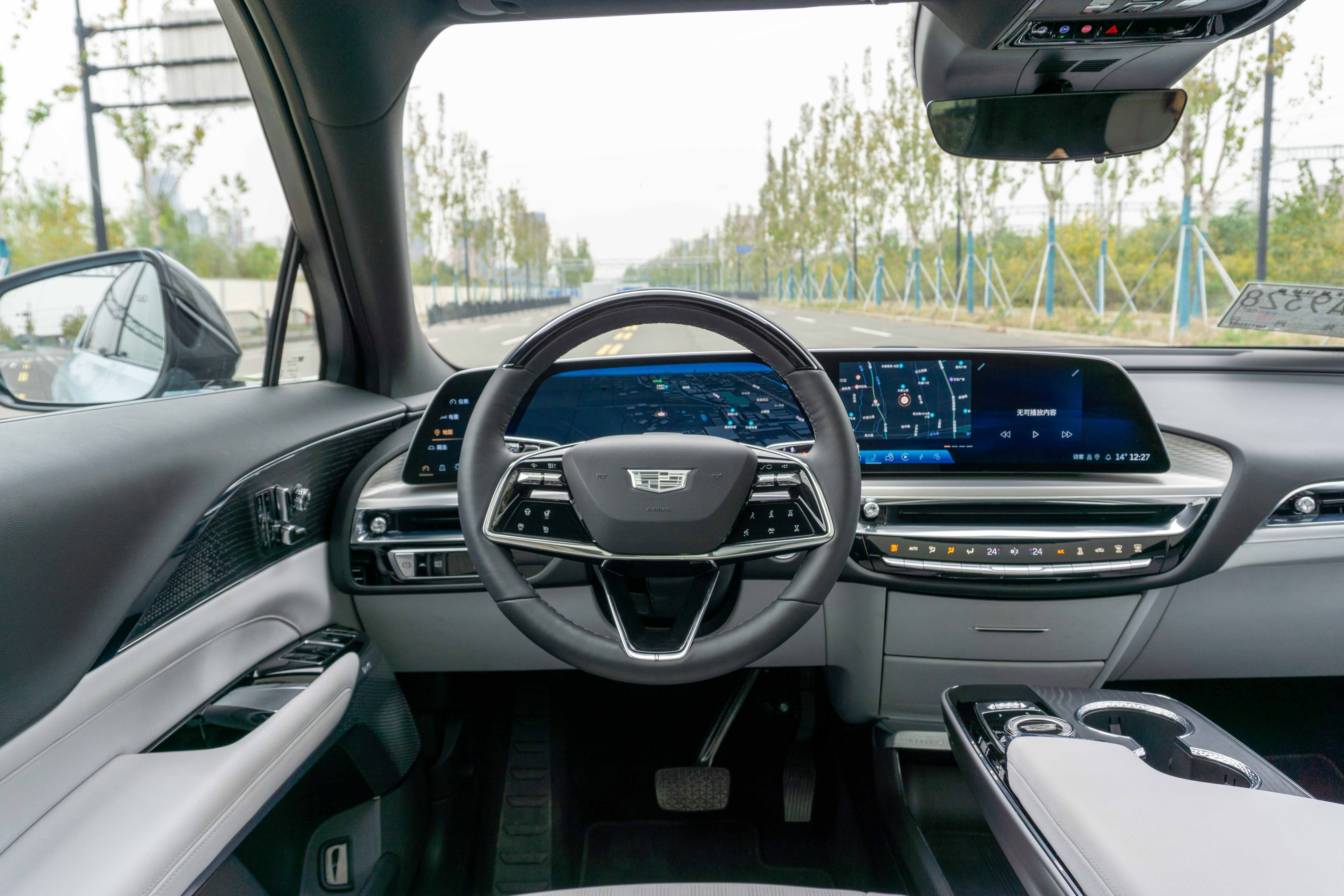 The Cadillac LYRIQ, as a traditional luxury brand, has a rare feature in the car’s infotainment system – it uses a Snapdragon 8155 chip with a combination of 12GB RAM and 64GB storage, which is in line with the new forces in the industry. According to official information from General Motors, future models will use Snapdragon 8195, 8295, and 8870, which is a very aggressive layout.
The Cadillac LYRIQ, as a traditional luxury brand, has a rare feature in the car’s infotainment system – it uses a Snapdragon 8155 chip with a combination of 12GB RAM and 64GB storage, which is in line with the new forces in the industry. According to official information from General Motors, future models will use Snapdragon 8195, 8295, and 8870, which is a very aggressive layout.
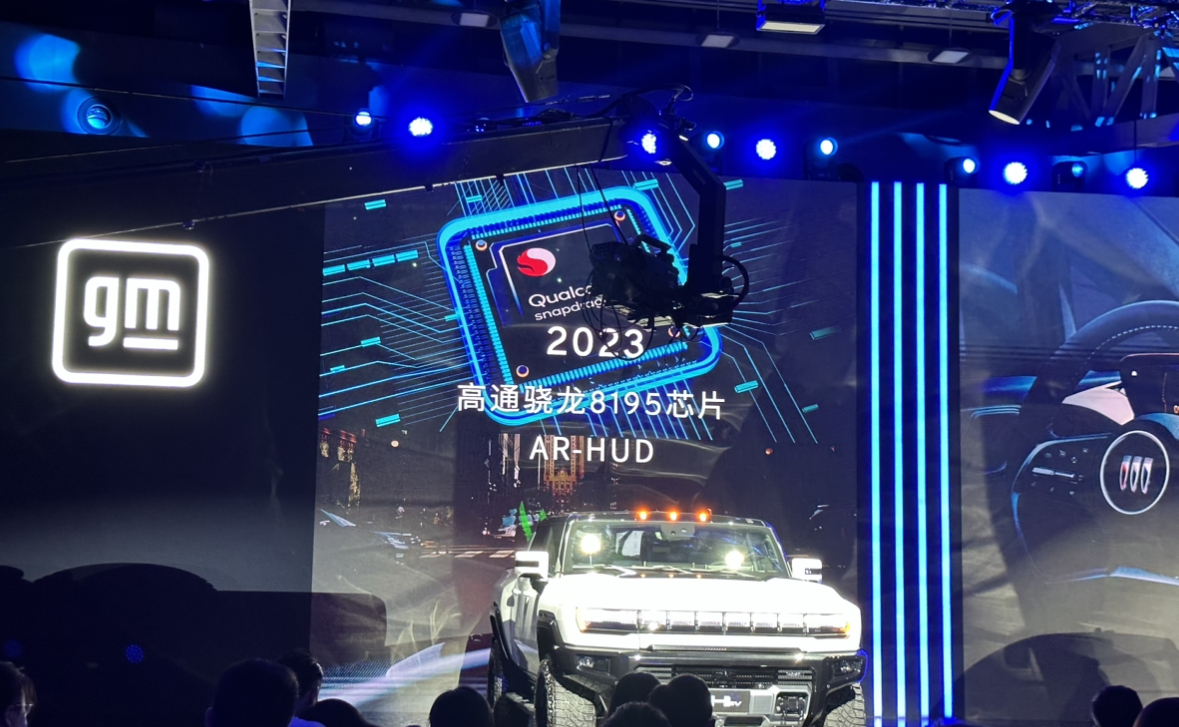
On the software side, the Cadillac LYRIQ’s infotainment system is built on the Android system, so there is not much learning curve, and the simple interface and smooth response speed make it easy to use. Frequently used functions such as maps, CarPlay, and music are integrated into the bottom of the dock.
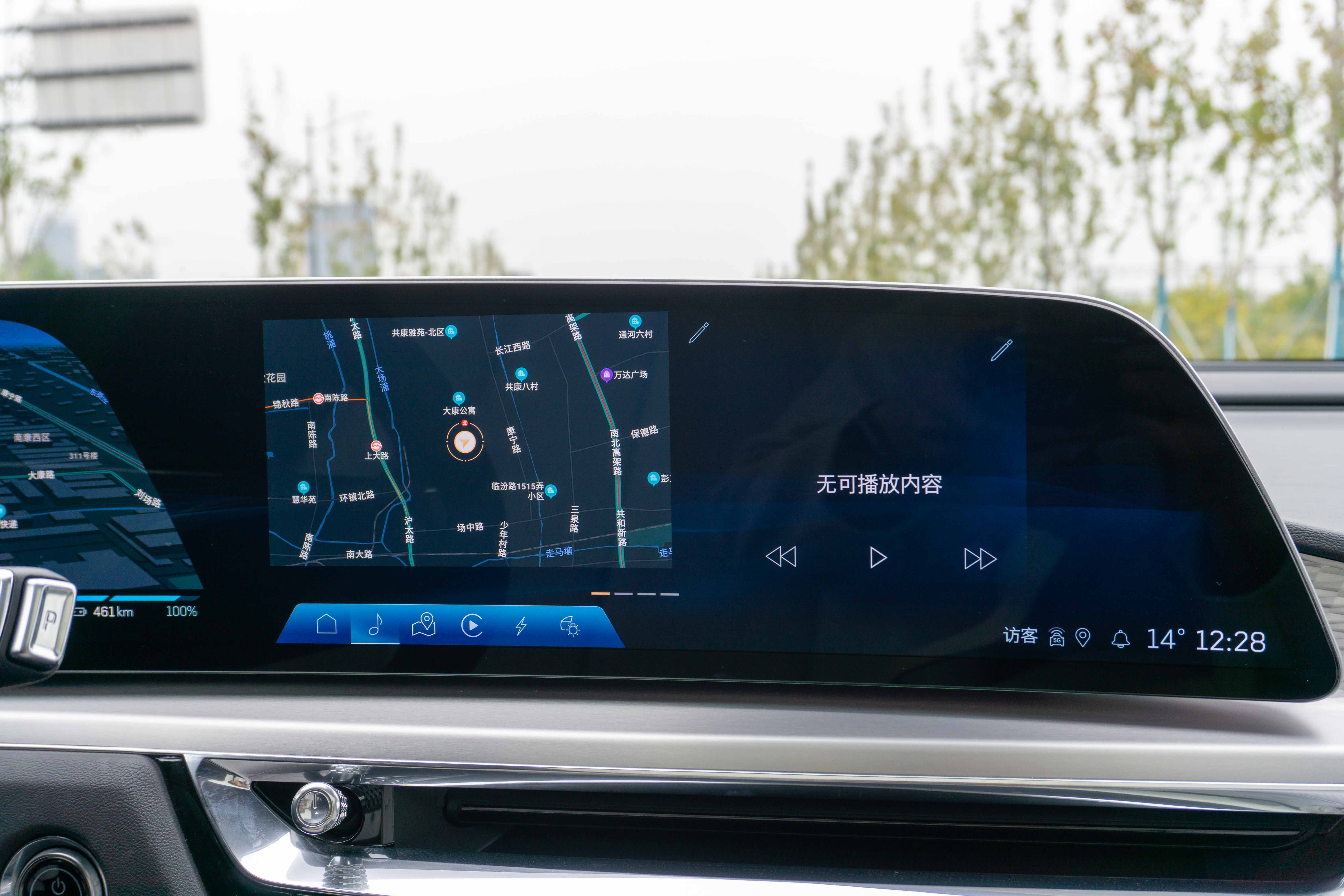
During use, the screen will heat up during the day due to the high screen brightness, which leads to heat accumulation. If you are a sensitive person like me, you will also find that the heat will cause the infotainment system to lag slightly. Fortunately, this issue will be improved in subsequent OTA plans.
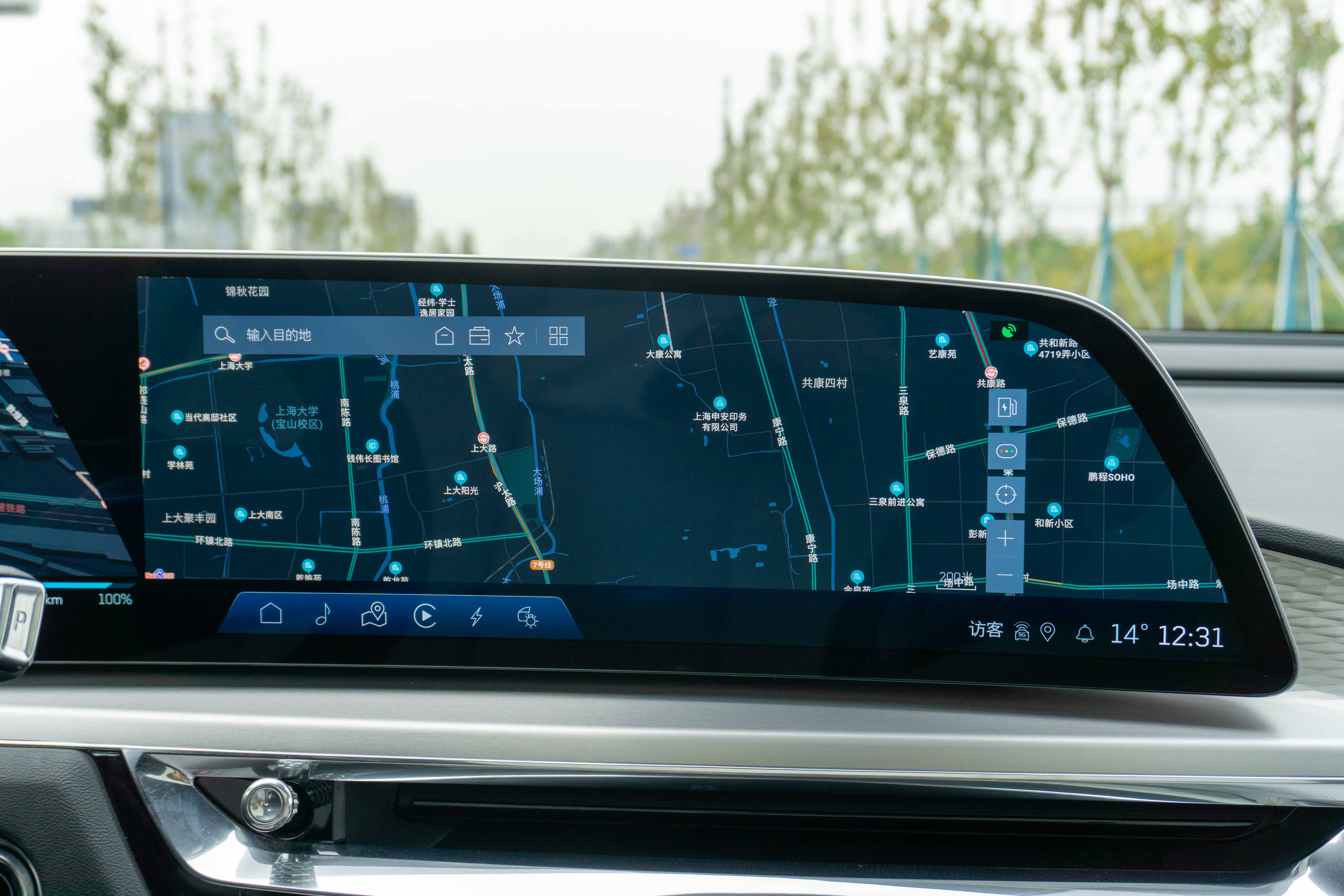
It is worth mentioning that the leftmost side of the screen also integrates lighting settings, trip mileage, and other convenient features. According to Cadillac engineers, this 33-inch screen is fully touch-sensitive, but there are software restrictions in the instrument cluster area.
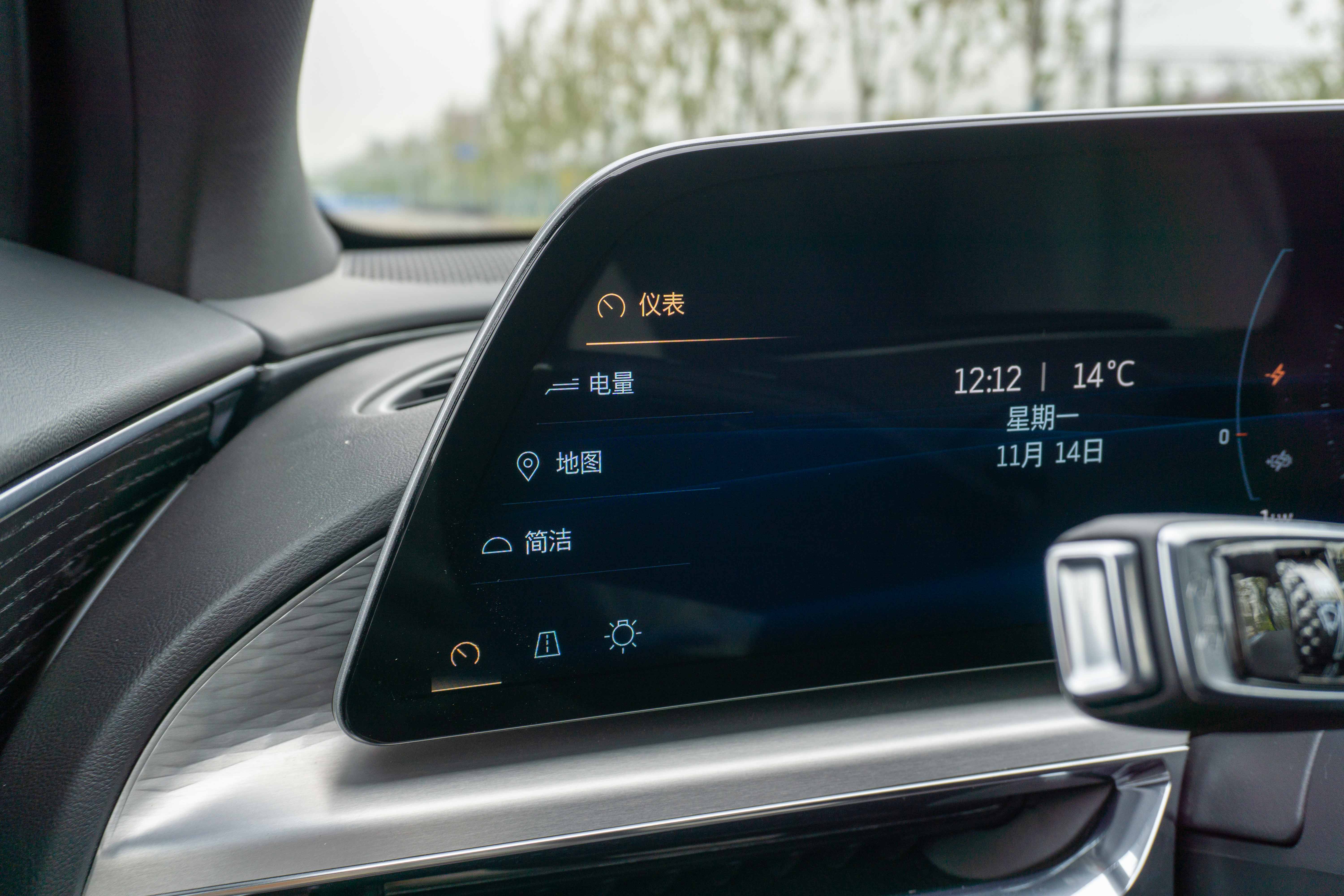
In terms of interior design, the LYRIQ continues Cadillac’s consistent design style, with a central console decorated with leather, wood, and metal panels to highlight the brand’s identity.
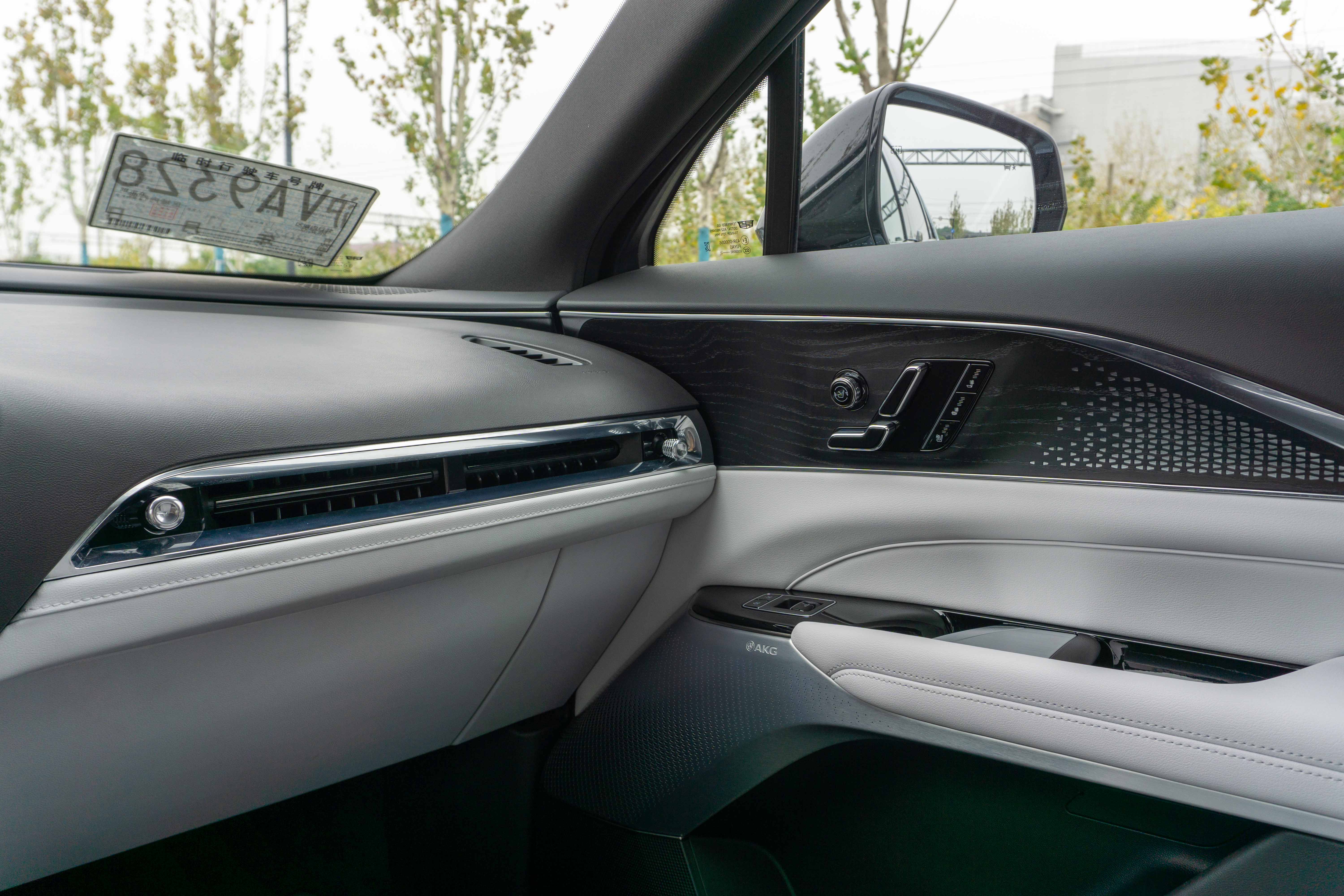 The air conditioning settings panel on the center console still retains physical buttons with clear feedback, and the animation on the small LCD screen is very smooth. Nowadays, vehicles with physical buttons are not commonly seen, and the physical buttons on the Cadillac LYRIQ can provide very convenient and fast operation while driving. Moreover, the commonly used temperature and air volume adjustments are concave on the buttons, which can be operated blindly. This feature is highly praised.
The air conditioning settings panel on the center console still retains physical buttons with clear feedback, and the animation on the small LCD screen is very smooth. Nowadays, vehicles with physical buttons are not commonly seen, and the physical buttons on the Cadillac LYRIQ can provide very convenient and fast operation while driving. Moreover, the commonly used temperature and air volume adjustments are concave on the buttons, which can be operated blindly. This feature is highly praised.
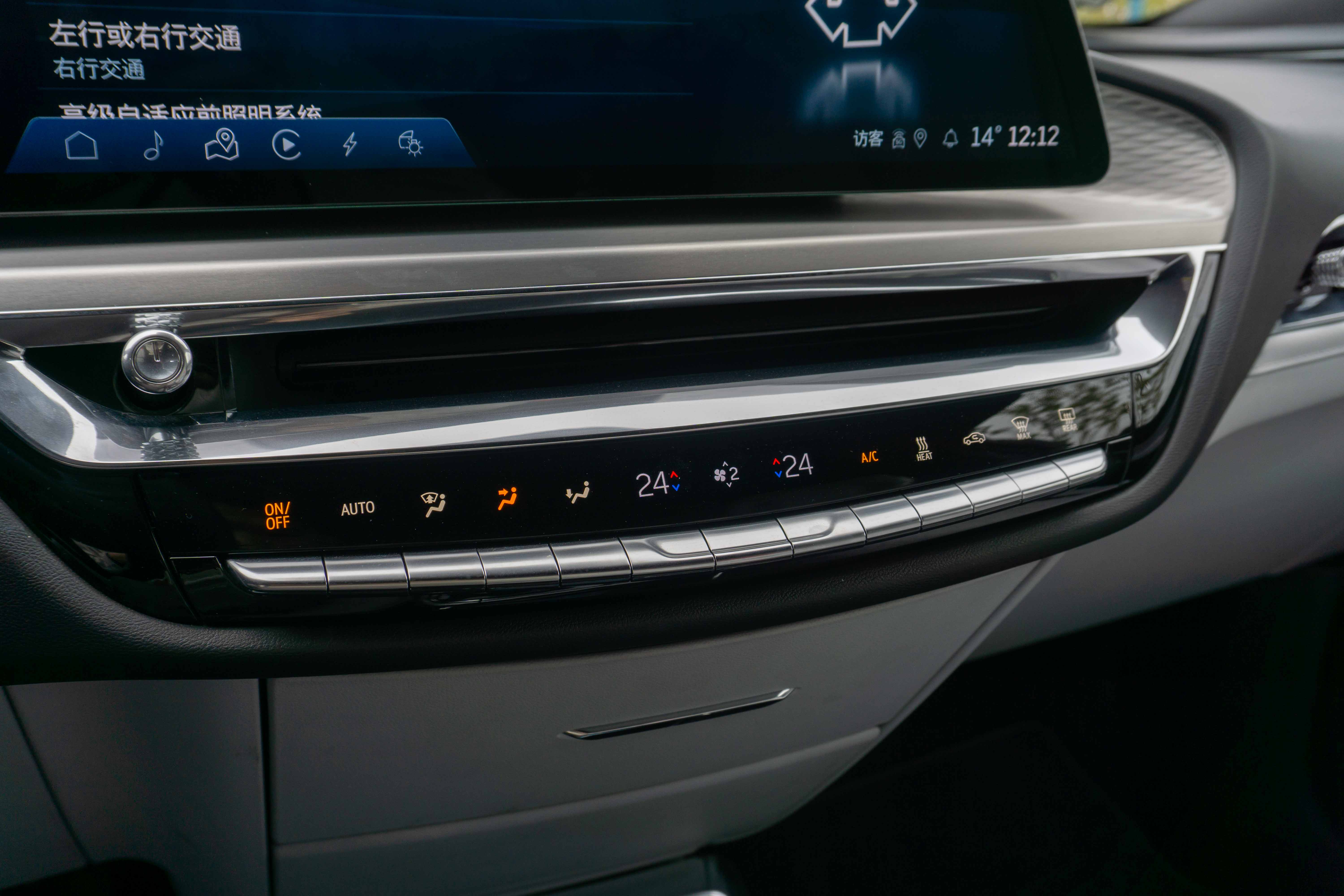
Below the air conditioning panel, LYRIQ has two small drawers with deep blue inner compartments, which look very stylish. The upper storage compartment has a large space, and an iPhone 14 Pro can be placed horizontally or vertically. It is very suitable for daily use to store sunglasses and other small items. The lower storage compartment has a slightly smaller space, and there is basically no more space left over for storing another iPhone 14 Pro horizontally. It is more suitable for storing some receipts or other small items.
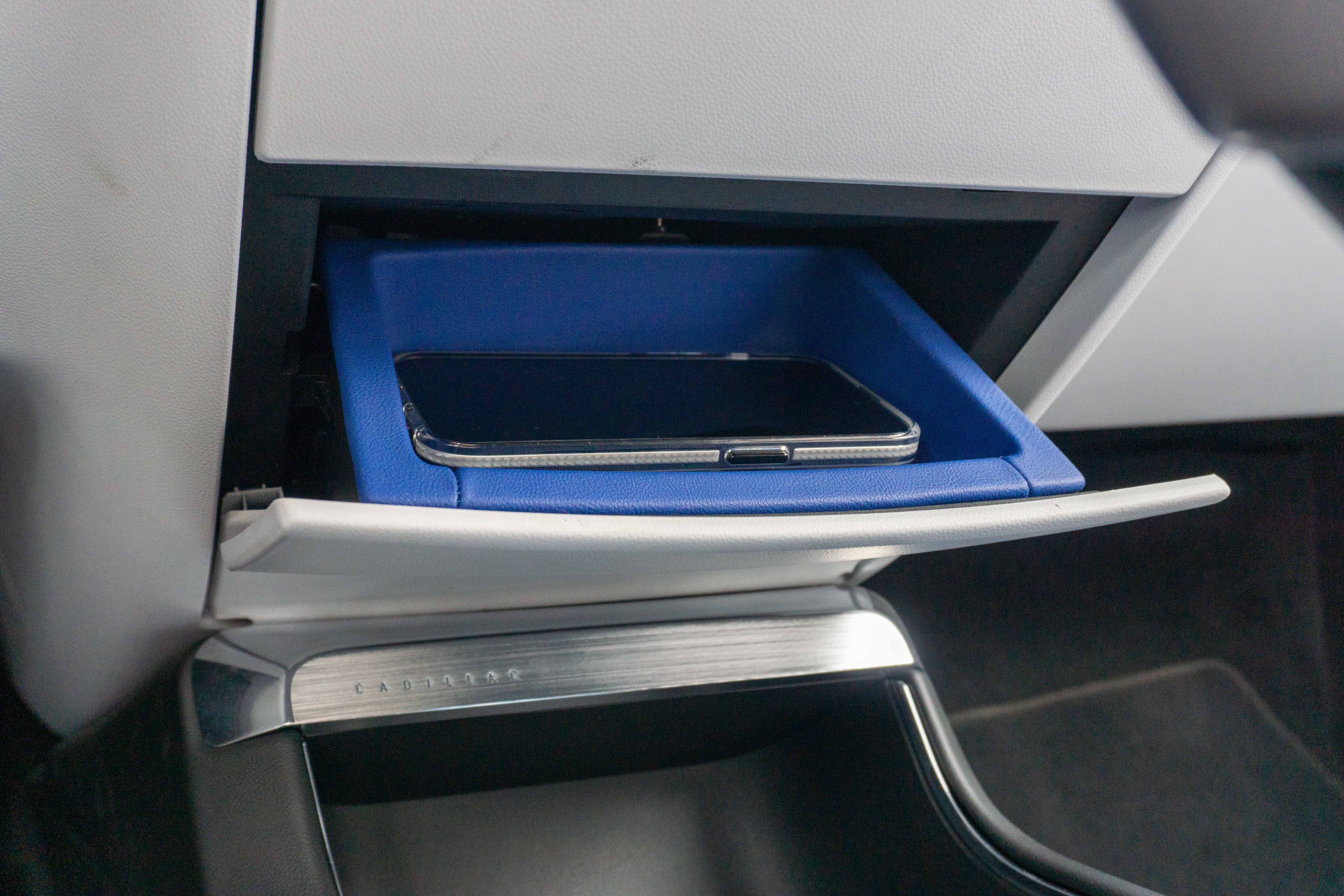

The central area of the console also retains the knob operation method, which can be used to operate the vehicle when it is inconvenient to use the touch screen. For users who are accustomed to using physical buttons, this is very practical.
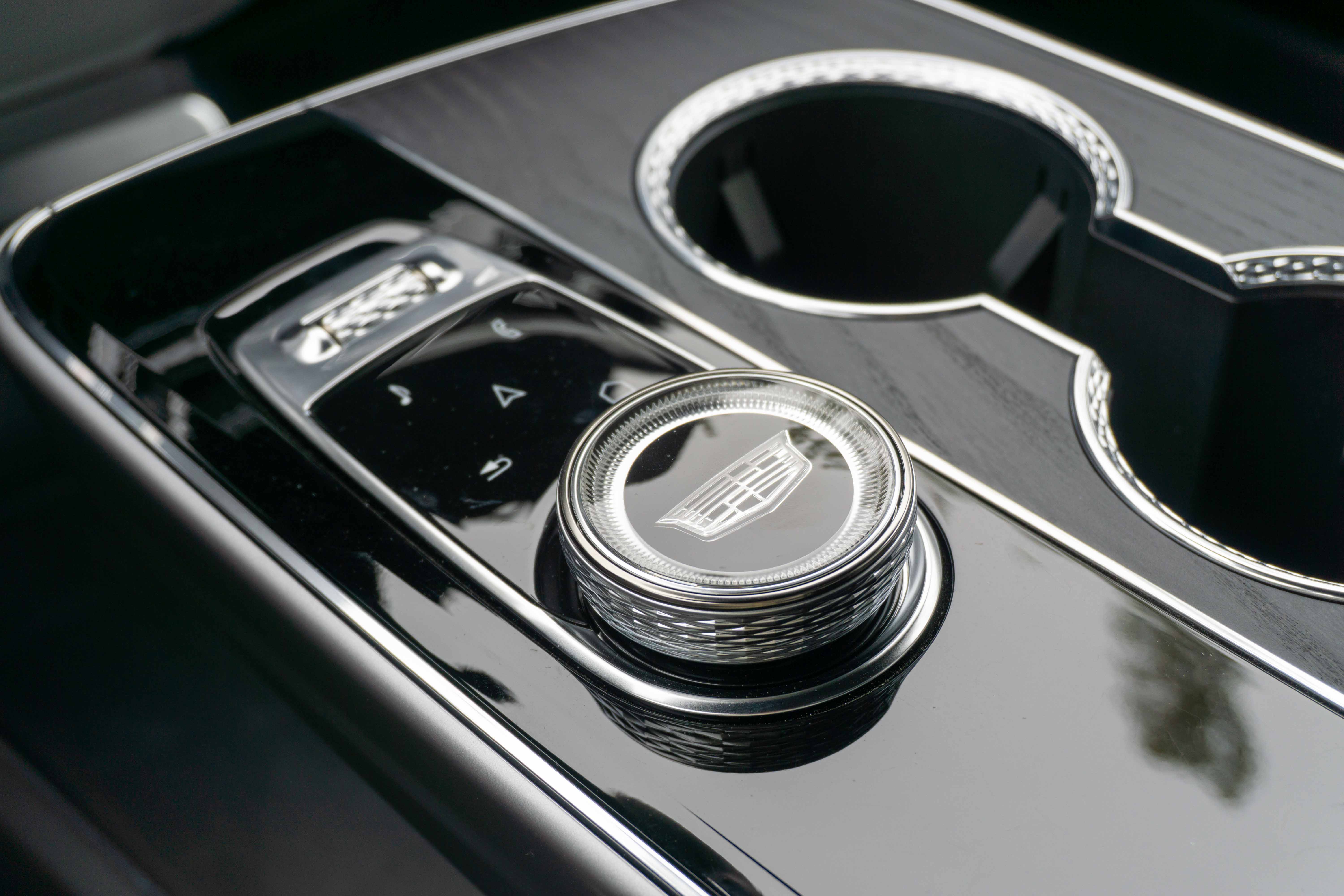
Behind the knob, there is a slot for placing a mobile phone. This slot has wireless charging function with a maximum power of 15 W.
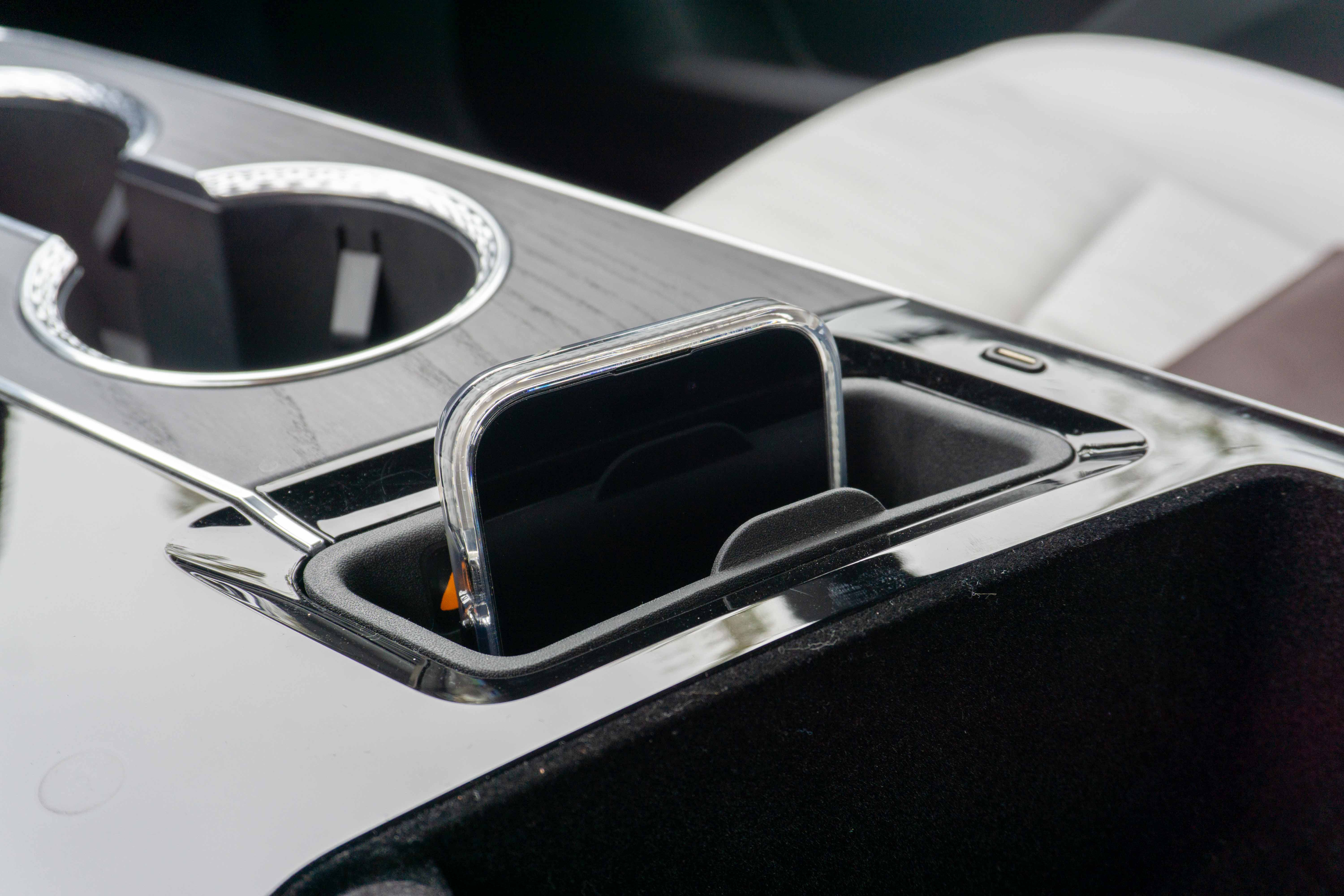
The interior of the slot is very considerately designed with a soft fixation for the mobile phone, which avoids the phone making noise during vehicle driving. The wireless charging on LYRIQ also has a vent design, but the effect is not as obvious as that of the CT5, and the phone will still slightly heat up. However, this may be due to the use of the heater.
Below the center console, there is a very large storage space since there is no engine or gearbox. Women can easily store a pair of driving shoes or a large handbag, while men can put down a briefcase or a laptop.
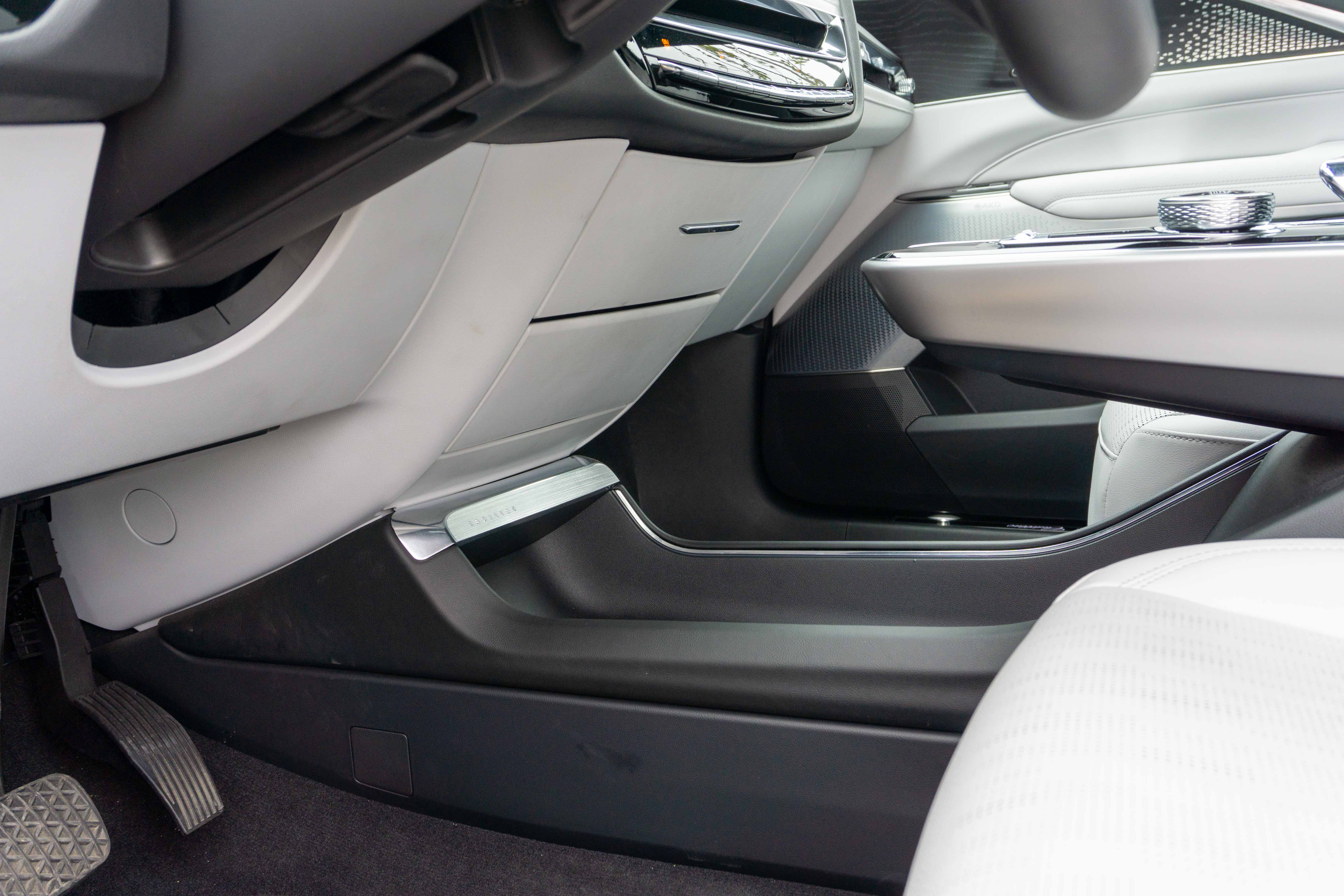
As for the audio system, the Cadillac LYRIQ doesn’t use the usual BOSE brand. Instead, it comes with a 19-speaker system from AKG with a maximum power of 1,400 W and a 7.1 channel immersive surround sound, which produces a stunning effect when playing lossless audio wirelessly through CarPlay. Although there aren’t many options for the equalizer, the basic settings have impressive performance, which is also an advantage of being a century-old luxury brand.

Among them, the perception of headrest speakers is not significant. The engineers say that the headrest speakers balance the stereo sound throughout the car, so they don’t easily catch people’s attention.
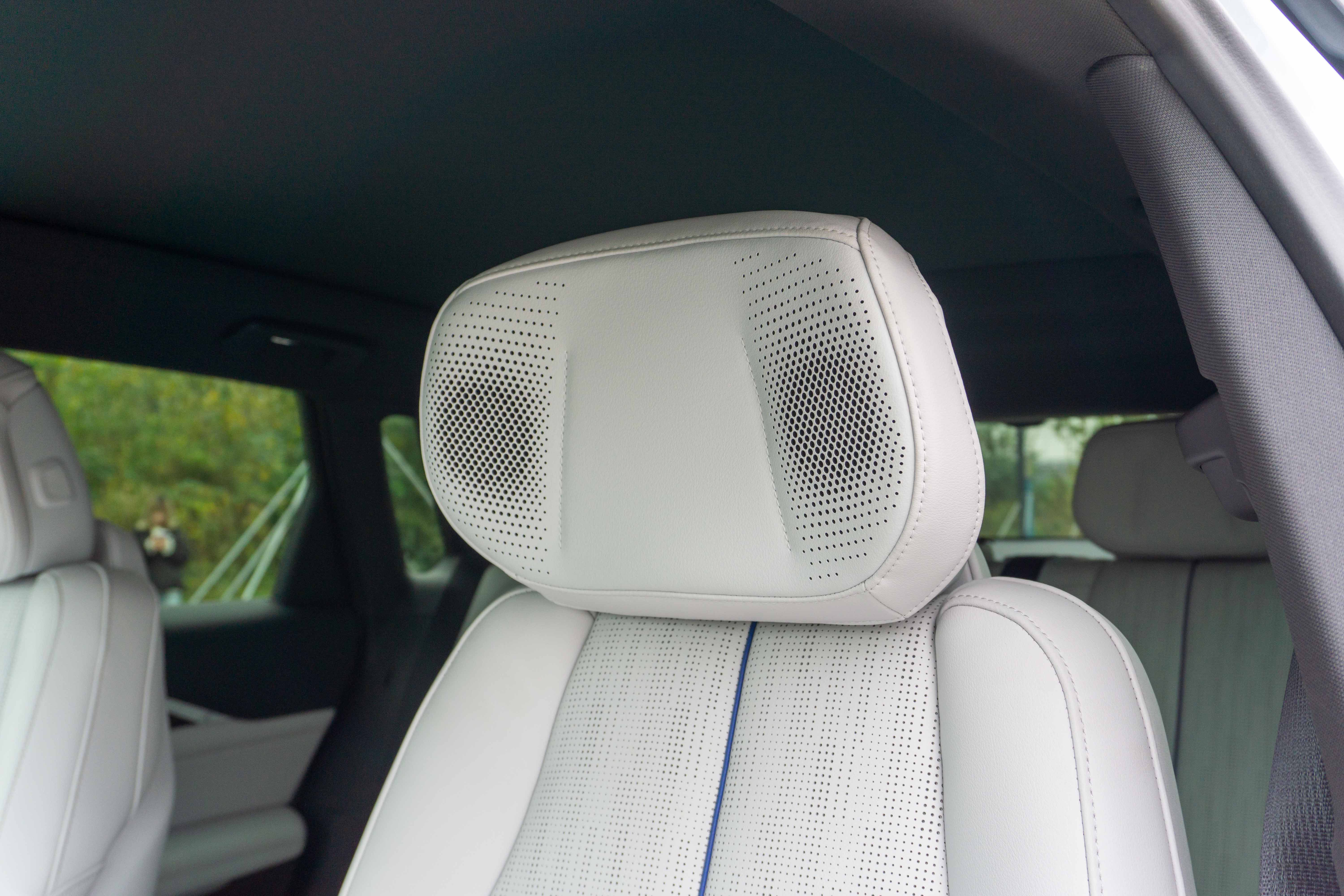
On the function keys of the steering wheel, the Cadillac LYRIQ uses haptic feedback similar to the home button on the iPhone 7, plus a lighting effect display, which is easy to use even while driving, without risking accidental operation.
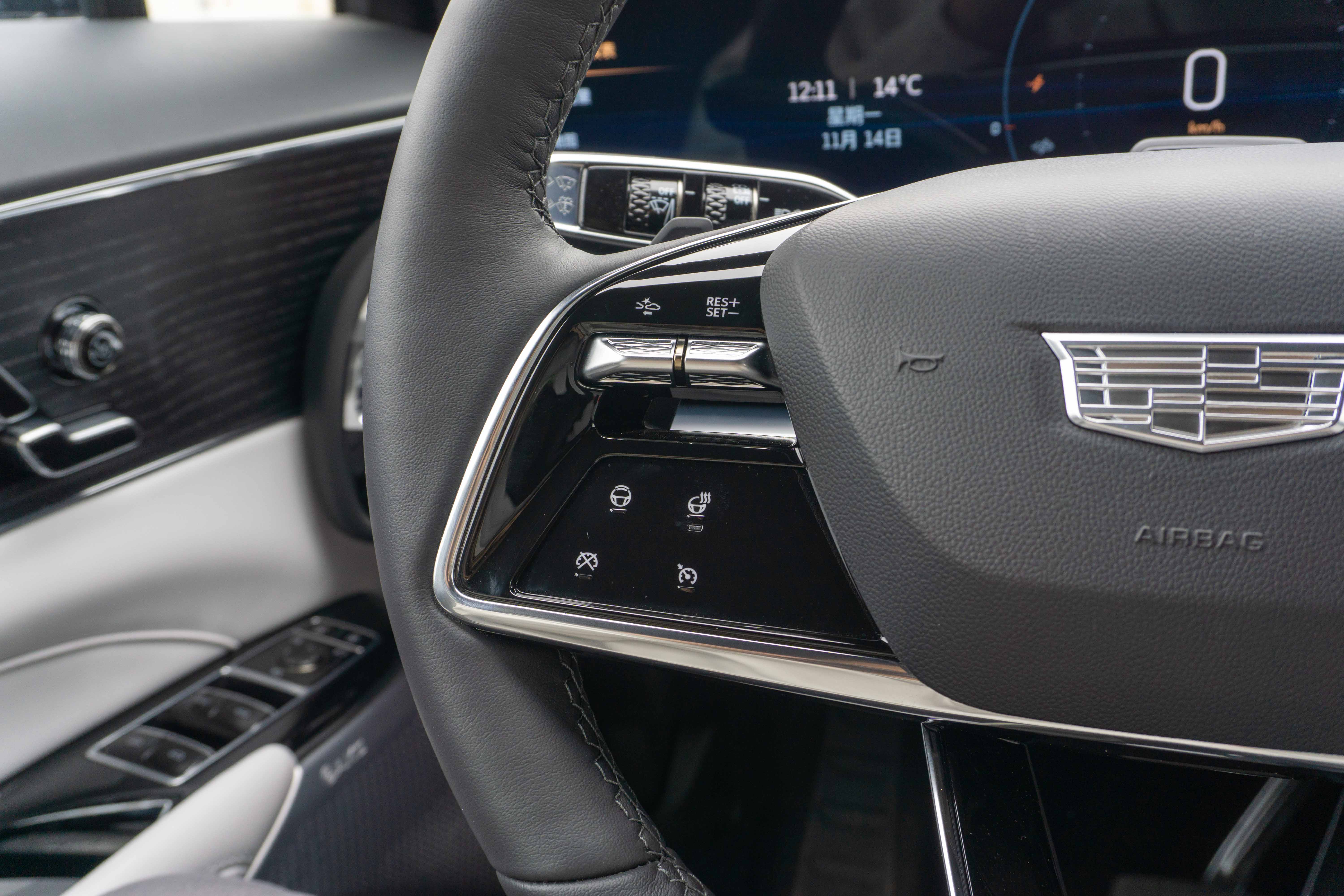
LYRIQ has a creative design for adjusting the air outlets, using a lever to control the wind direction, which evokes a retro aesthetic. After trying it out, the damping is excellent, and it can present a sense of luxury comparable to that of a luxury car. However, it may take some time to find the suitable air outlet direction when using it for the first time, which is not as handy as the screen adjustments of some new players when it comes to practicality.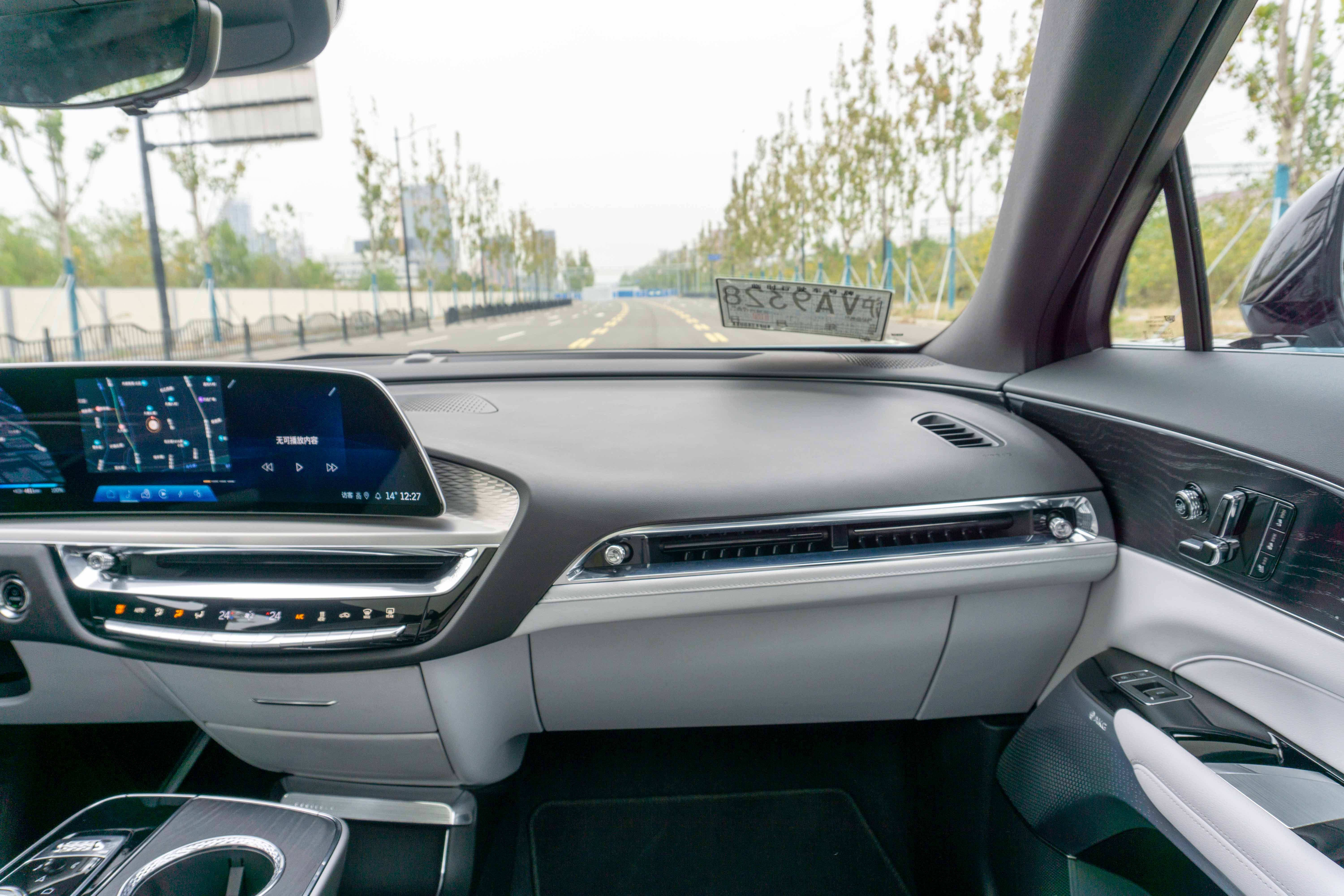
It’s nighttime and the Cadillac LYRIQ has a dual-tone atmosphere light that can be adjusted separately for the upper and lower areas. The atmosphere light directly placed on the door panel is complemented by an indirect one in the lower area. Although it’s not as exaggerated as the Mercedes-Benz series, the lighting effect and area are just right.
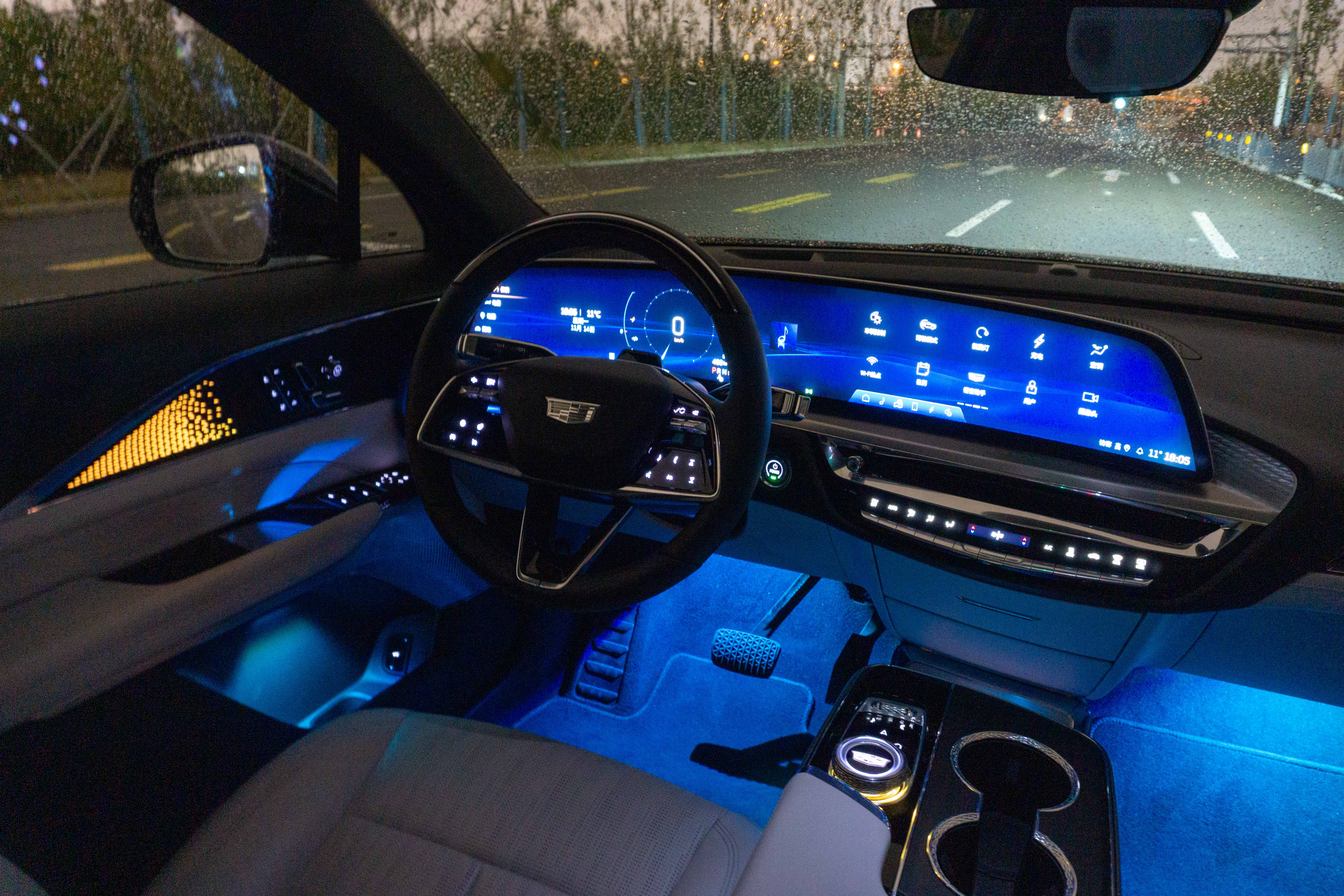
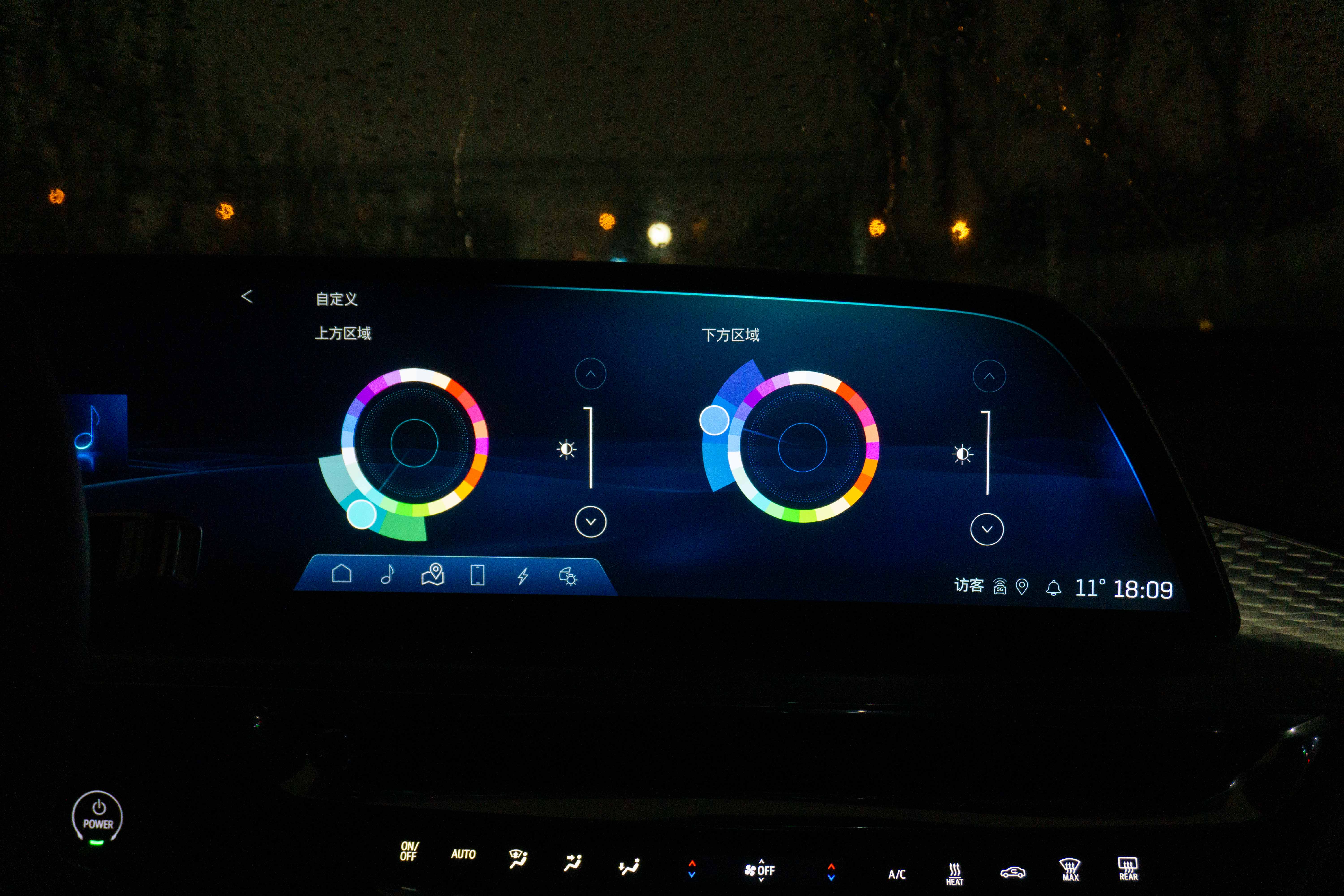
In terms of the cabin, the Cadillac LYRIQ has its own unique and innovative design points. The 33-inch screen, 8155 vehicle control unit, hidden handles inside and outside, and the new style of the steering wheel are all embracing technology. It does not forget about the classic heritage. The English logo of Cadillac, the classical central control design, and the materials used in the interior all reflect the collision of technology and classic elements. Among traditional automakers, LYRIQ is up to par with new forces in terms of vehicle control unit, but there is still some gap in terms of functionality.
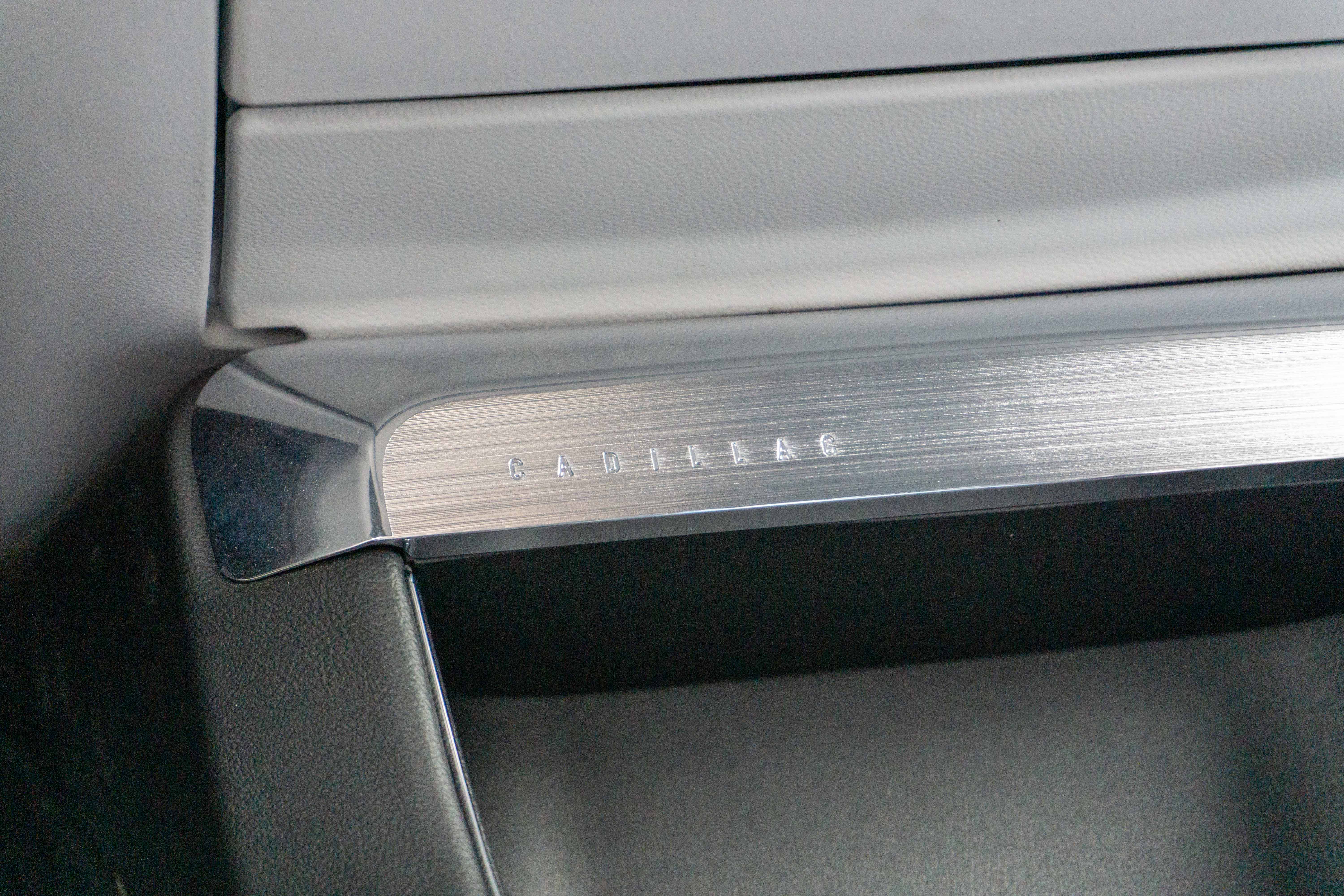
Space: Large 5-seat Design
LYRIQ is positioned as a medium-to-large-sized 5-seat pure electric SUV, with a length of 5,003 mm and a wheelbase of 3,094 mm. Compared with the benchmark of medium-to-large SUVs, the Brilliance BMW X5 with a long wheelbase has only an 11 mm difference in wheelbase, which is very close. Compared with the NIO ES7, the wheelbase is 134 mm longer and 96 mm longer than the Xpeng G9.
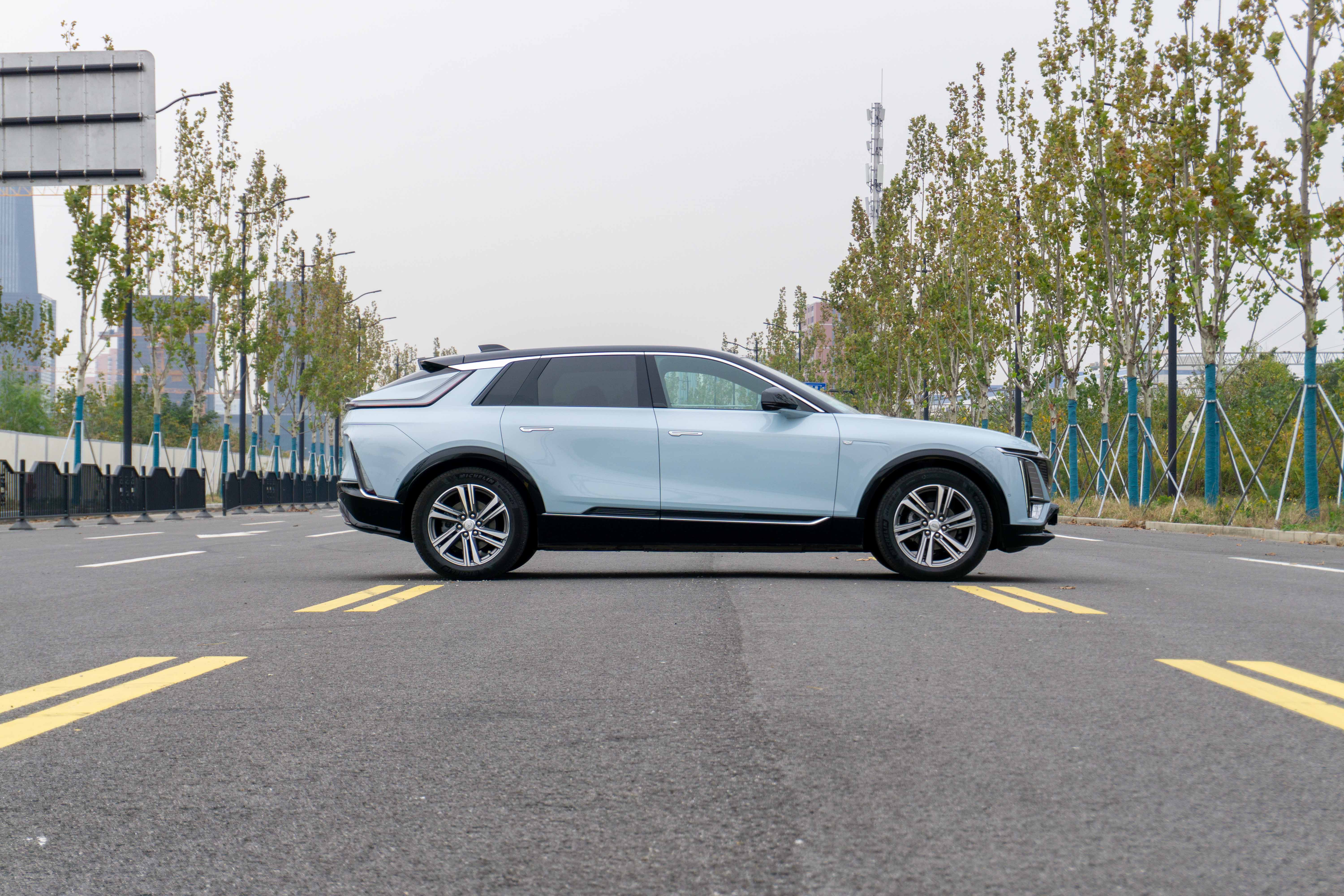
The front seats of the Cadillac LYRIQ are relatively spacious and the sponge padding is moderately soft and hard. Comfort and support are well balanced, which is a consistent setting for American luxury cars. Moreover, the height adjustment range of the front seats is very wide, starting from a minimum of 305 mm, which is particularly friendly for users with taller stature. Therefore, LYRIQ can provide a suitable driving position for drivers of different heights.
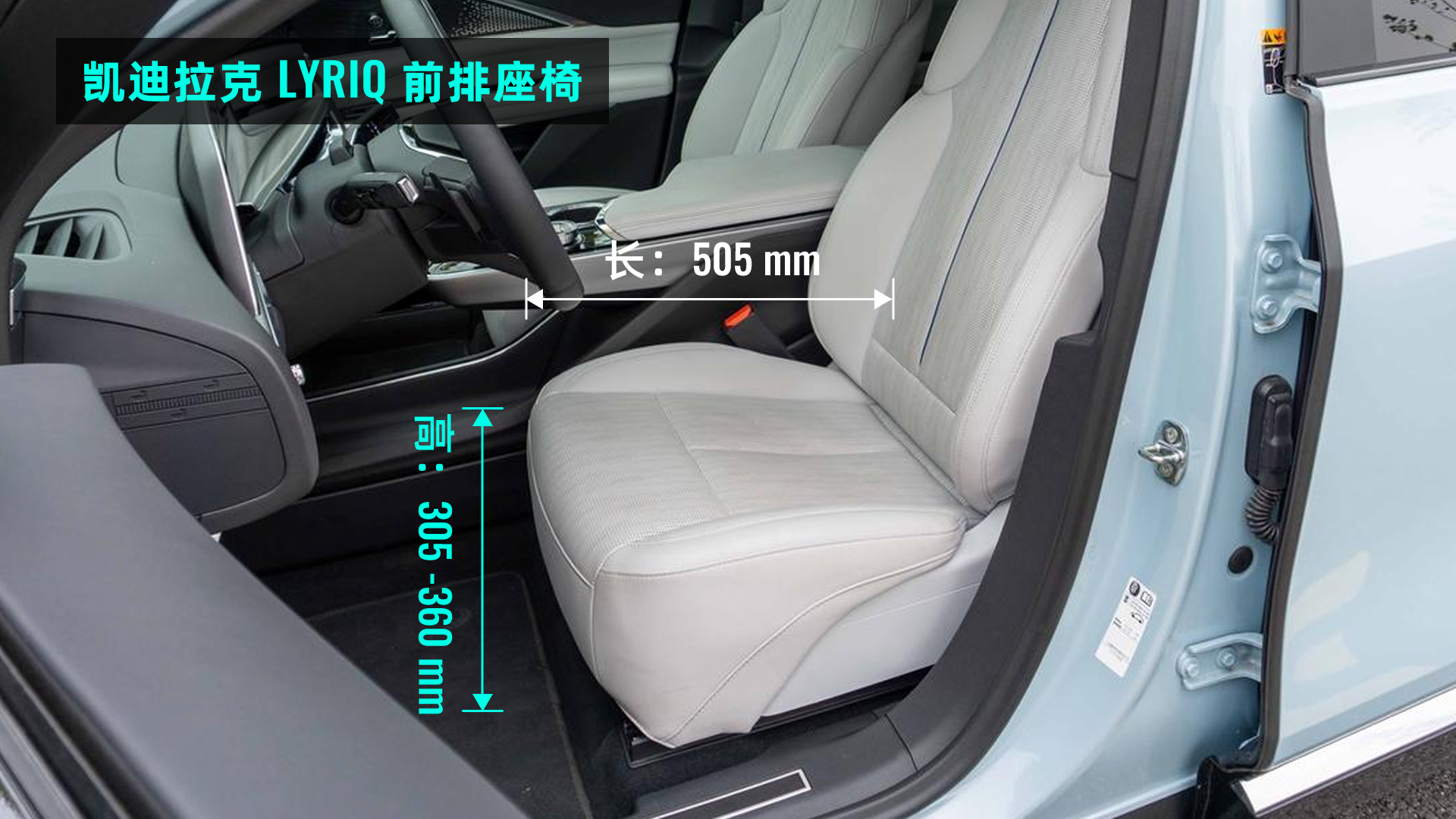
On the interior space, with a height of 175mm and a weight of 68kg, after the front seats have been adjusted to a suitable driving position, there is still enough legroom for a palm’s width in the rear seats and the headroom is also up to a fist’s length. For a mid-size SUV, this space is at a medium to high level within its class, but compared to the NIO ES7 and XPeng G9, the LYRIQ has certain advantages in rear space.
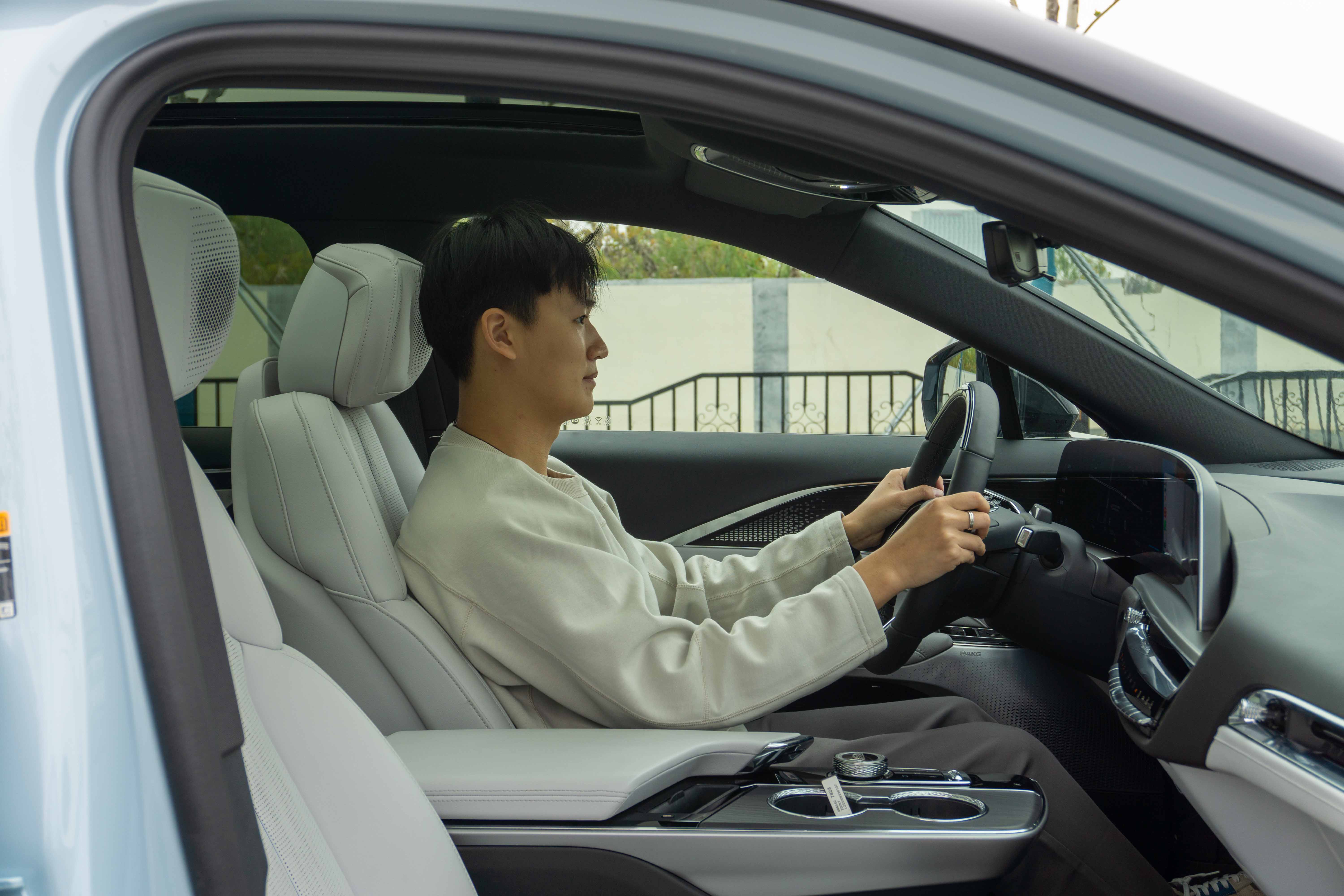


In addition, the length of the LYRIQ’s rear seat cushion is adequate for supporting the thighs. The length of the rear seat cushion is almost the same as that of the front seat cushion, and good support on long journeys can alleviate some sitting fatigue.
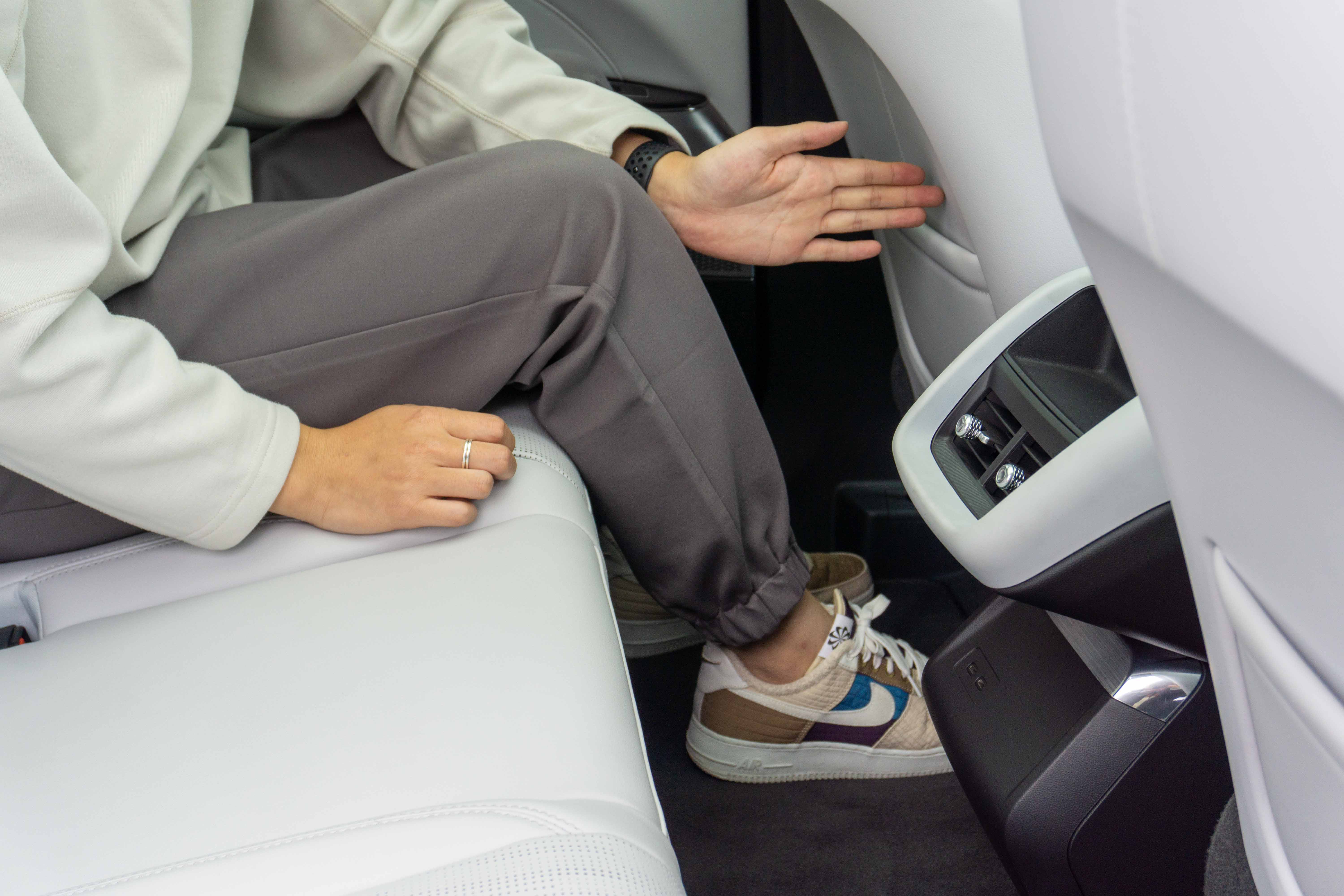
It is worth noting that the LYRIQ finally adds a headrest to the middle of the rear seat. In the past, many GM vehicles generally omitted the headrest in the middle of the rear seat to ensure a good view in the rearview mirror.
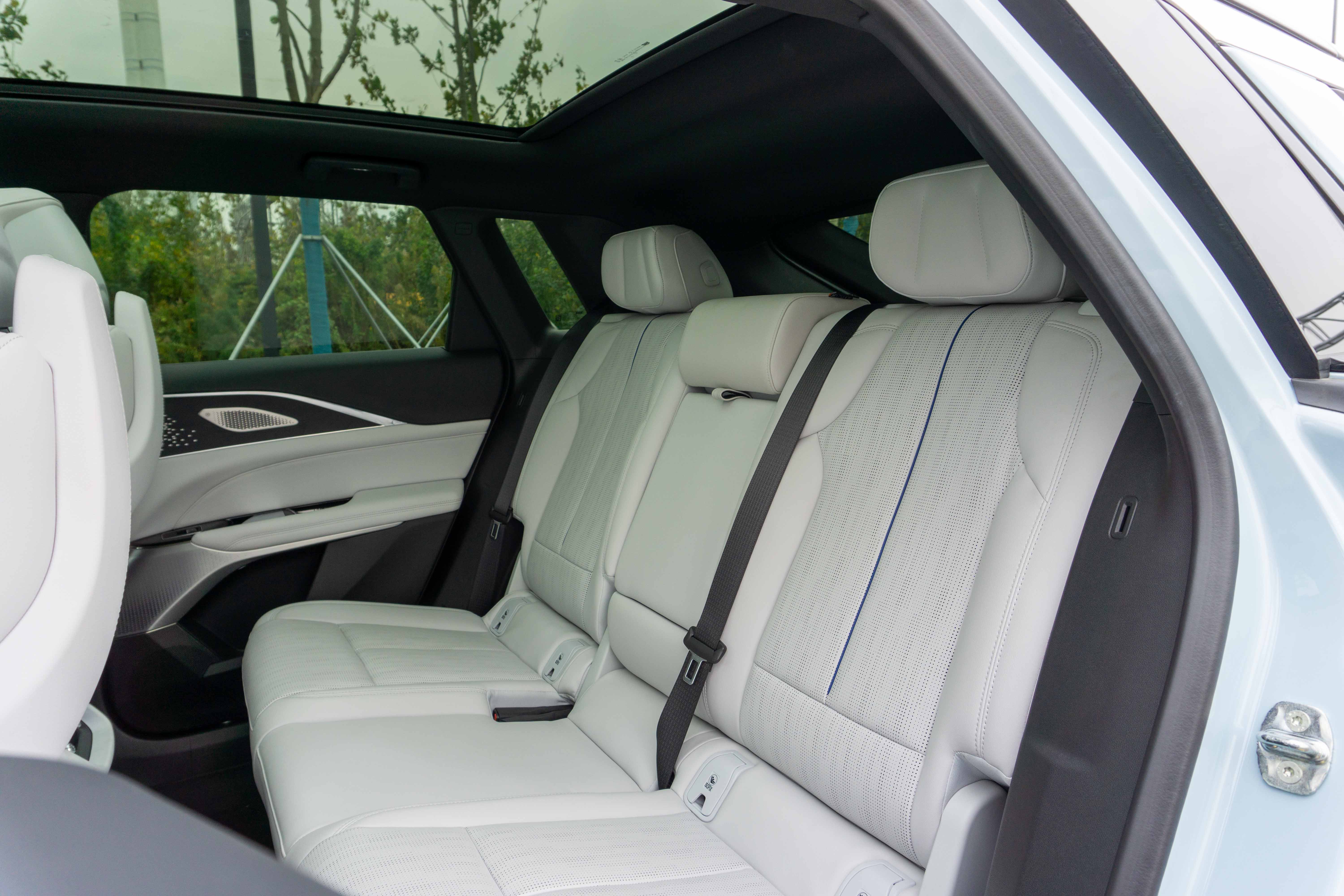
In fact, the headrest in the middle of the rear seat is not for comfort but for safety. Especially when a passenger is sitting in the middle, safety is more guaranteed. This improvement is worth acknowledging.
 The rear seats of the Cadillac LYRIQ can be folded 4/6 down, forming a nearly flat space with the trunk when fully flattened.
The rear seats of the Cadillac LYRIQ can be folded 4/6 down, forming a nearly flat space with the trunk when fully flattened.

In addition, the LYRIQ is already equipped with a power-folding function, but if you want to put the seats back up after folding them down, you can only do it manually by opening the rear doors and pushing the seats back up.
In terms of interior space, the Cadillac LYRIQ tries to keep up with the benchmarks in its class as much as possible. Although it doesn’t come with features such as electrically adjustable leg supports or rear backrest angles, etc., as far as basic experience is concerned, the LYRIQ still provides consumers with a very comfortable riding experience.
Range: A mid-sized pure electric SUV with a range of up to 480 km
As SAIC-GM’s first domestically manufactured Ultium-based model, the Cadillac LYRIQ uses a 95.7 kWh ternary lithium battery customized by CATL. The long-range luxury version we tested is a single-motor model with a maximum power of 255 kW, and its official CLTC test range is 653 km.
Our endurance test route remains the same as before, starting on the outer ring road and then turning onto the G60 Expressway heading southwest, driving non-stop until reaching a suitable point to return and recharge at the Fengjing Service Area, maintaining an average speed of 120 km/h throughout the journey.

The outdoor temperature on the day of the test was between 15-19 °C, and because of the clear weather, members in the closed cabin still felt stuffy and hot, so the air conditioning was set to A/C, with a temperature of 22 °C and the fan set to second gear, and the driving mode was set to travel (comfort).

The displayed range of the LYRIQ is also adjusted in real-time based on the user’s driving habits, and after the vehicle is fully charged, the displayed range is 522 km, which is measured according to the WLTC cycle. After 5 hours and 16 minutes of continuous driving, the range was depleted after covering 480 km (with an average speed of 90 km/h). The remaining battery level was only 1.5\%, and the displayed range was only 3 km, and the energy consumption during this 480 km journey was 19.3 kWh/100 km.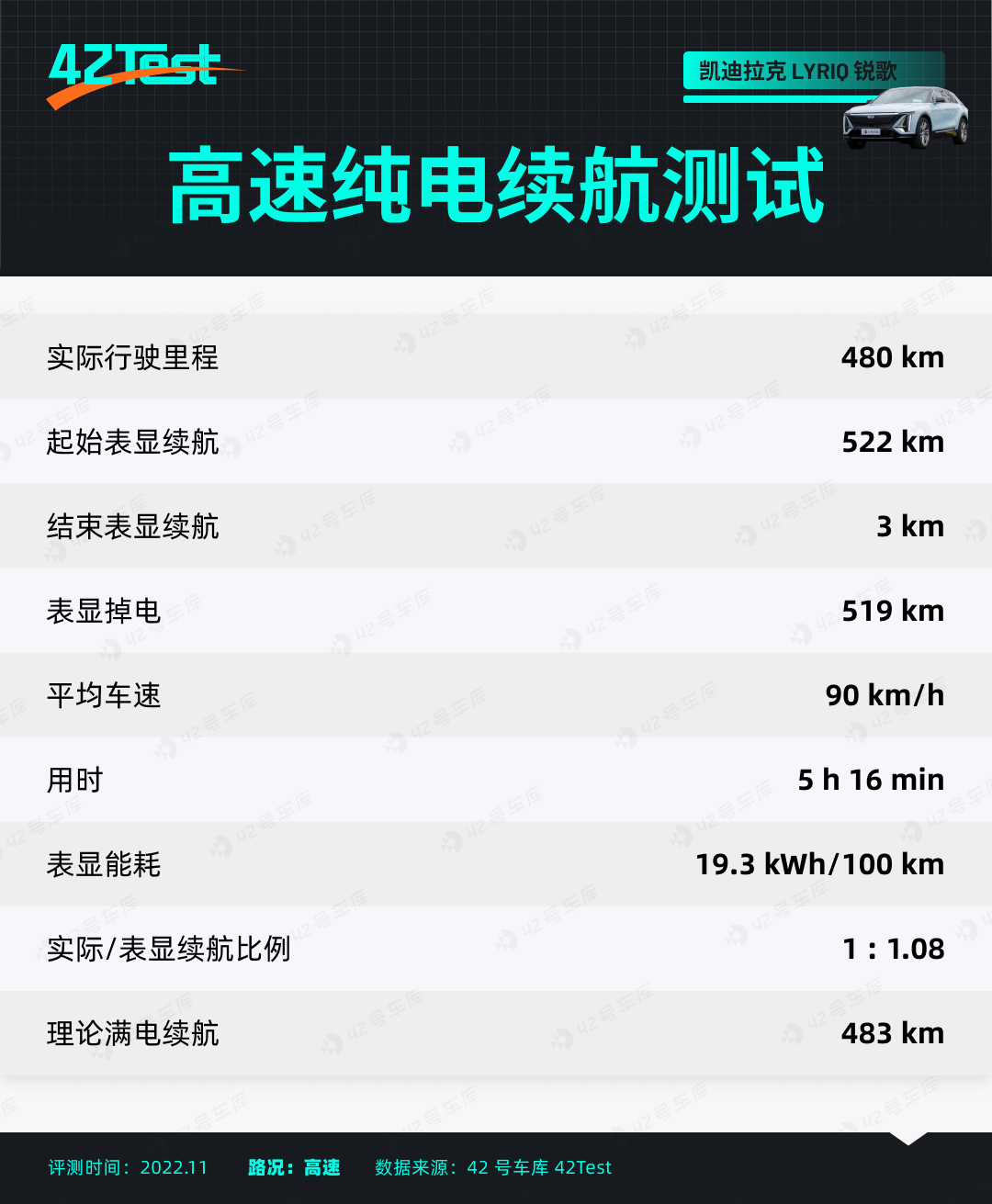
Therefore, the 480 km of high-speed maximum range is considered impressive for a 2.7 ton mid-large-sized electric SUV like LYRIQ. Within this 480 km, the displayed range of the vehicle decreased by 519 km, and the actual/displayed range ratio is 1:1.08. This displayed range is of high reference value in daily use.
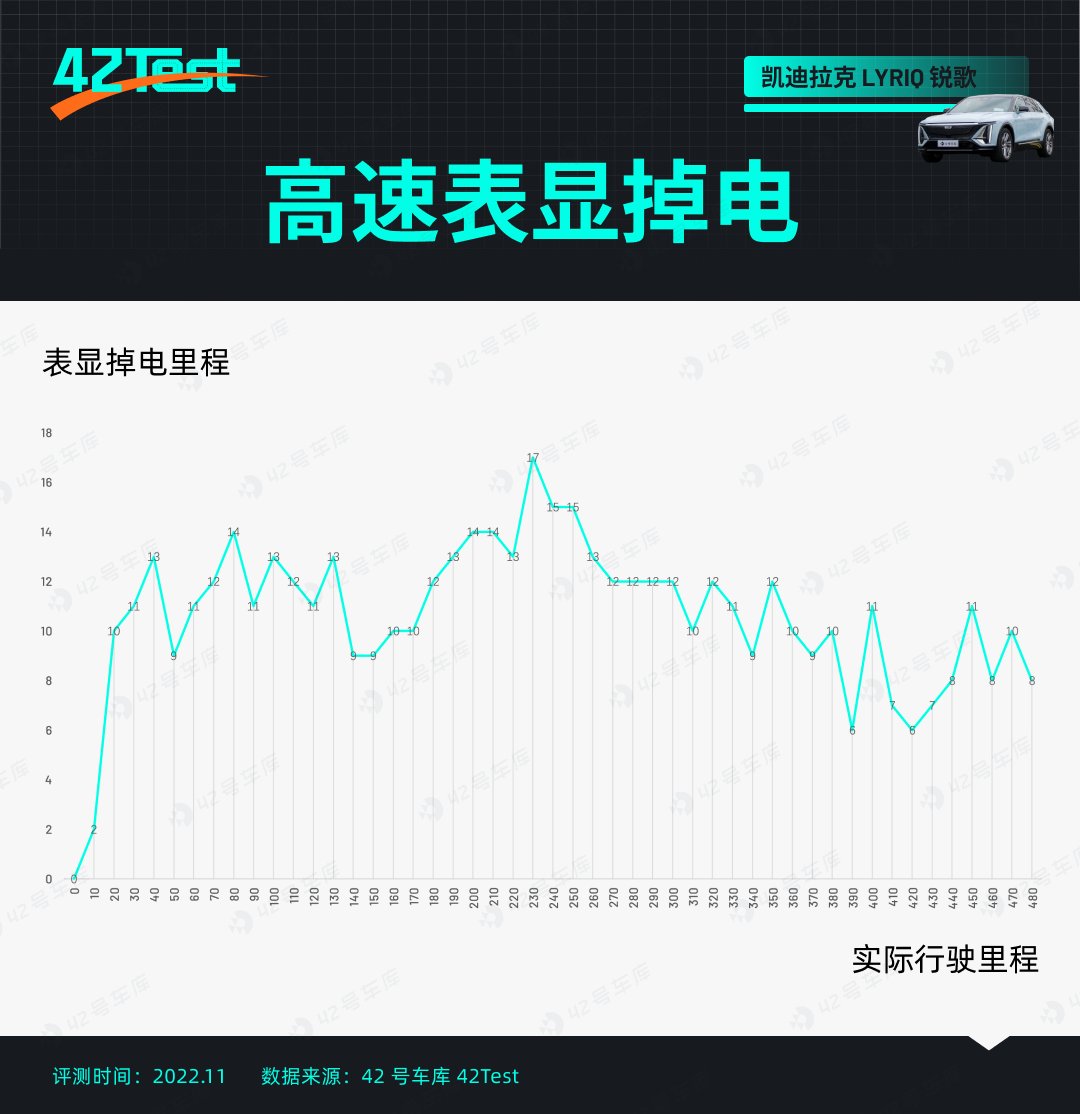
It is worth noting that LYRIQ reminds the driver to recharge when the battery level drops to only 11%, and limits the power when it reaches 8%. At this time, the vehicle can still maintain a speed of 120 km/h, but the acceleration will be restricted. When the battery level drops to 6%, low battery warnings will appear, and the displayed range will not be shown, and the vehicle will slow down to 100 km/h.
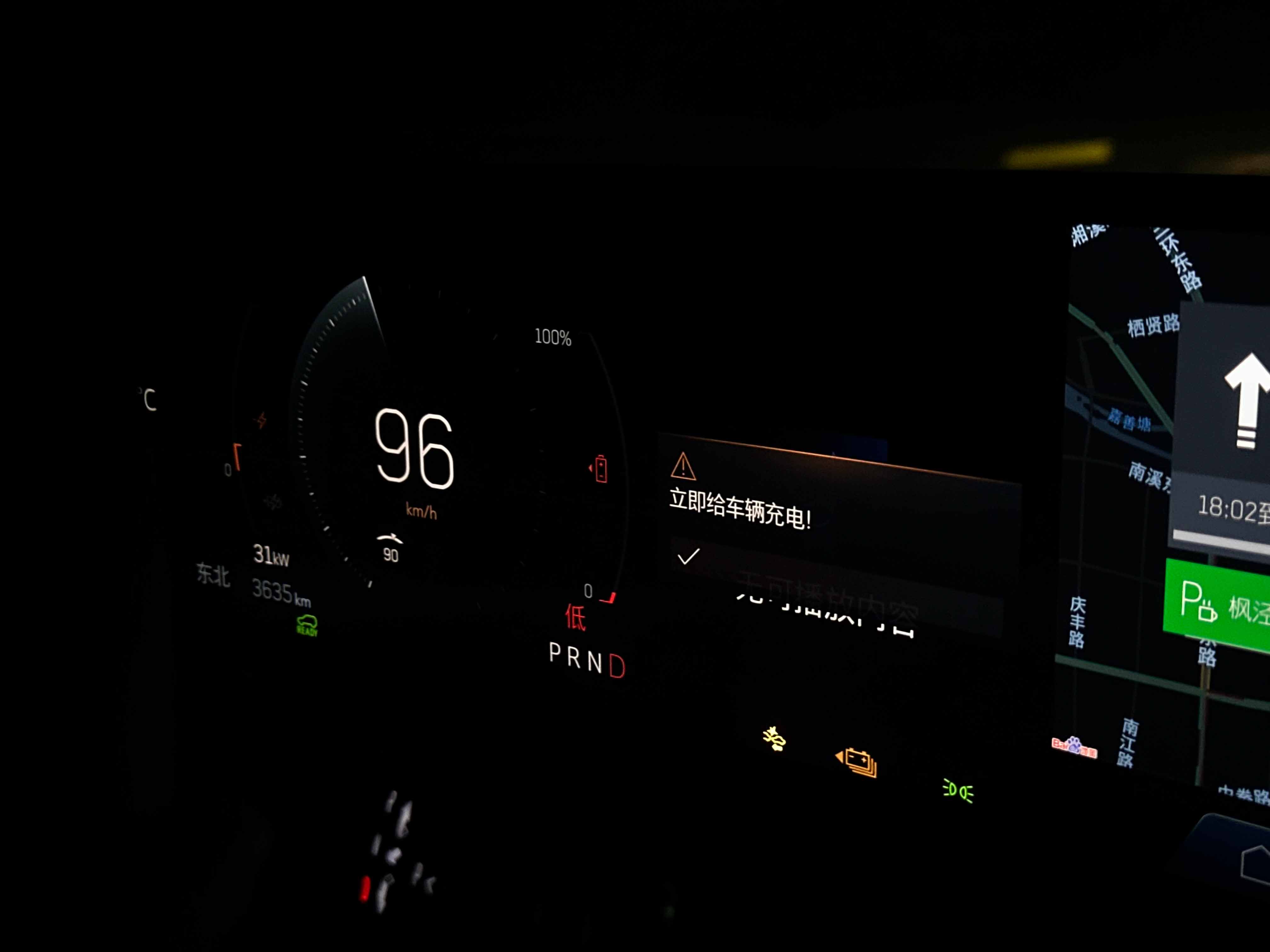
The step-by-step reminders allow the driver to clearly understand the current state of the vehicle. Drivers can quickly make adjustments according to driving conditions, knowing when the vehicle will limit its power or reduce its speed.
Although the displayed range will stop showing when the battery level drops to 6% and there are only roughly 30 km of displayed range left, you can still ask “Hello, Cadillac” to check the remaining battery level and actual range, even when the battery level is as low as 1.5%. This gave us confidence during the range testing, and allowed us to make it to the service area.
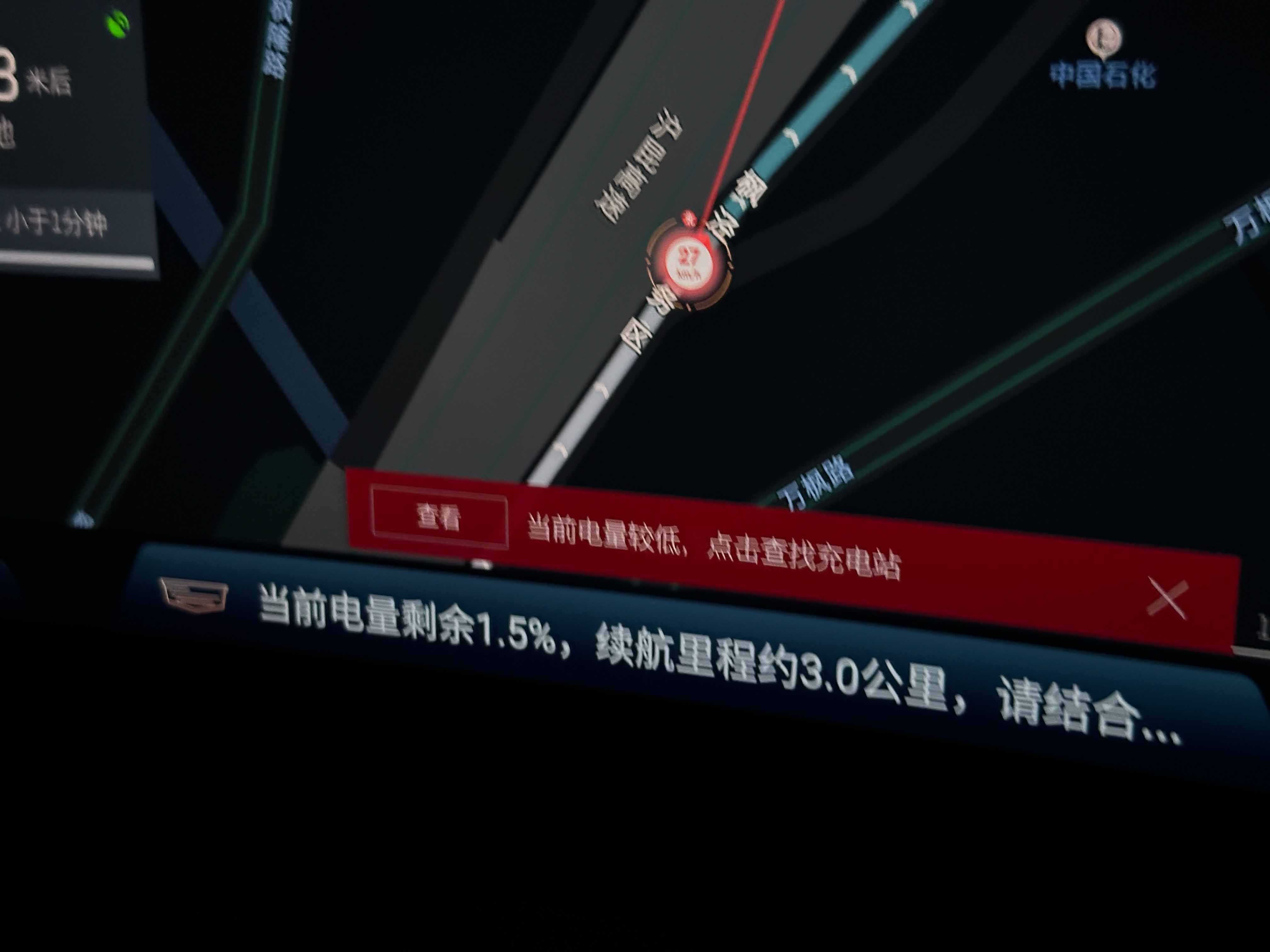
City energy consumption: 16.3 kWh/100 km
After testing the high-speed range, we also tested the city range. The test route consisted of 50 km of Shanghai city ground roads and 100 km of outer ring expressways, simulating the ratio of ground/elevated roads commonly used for daily commutes.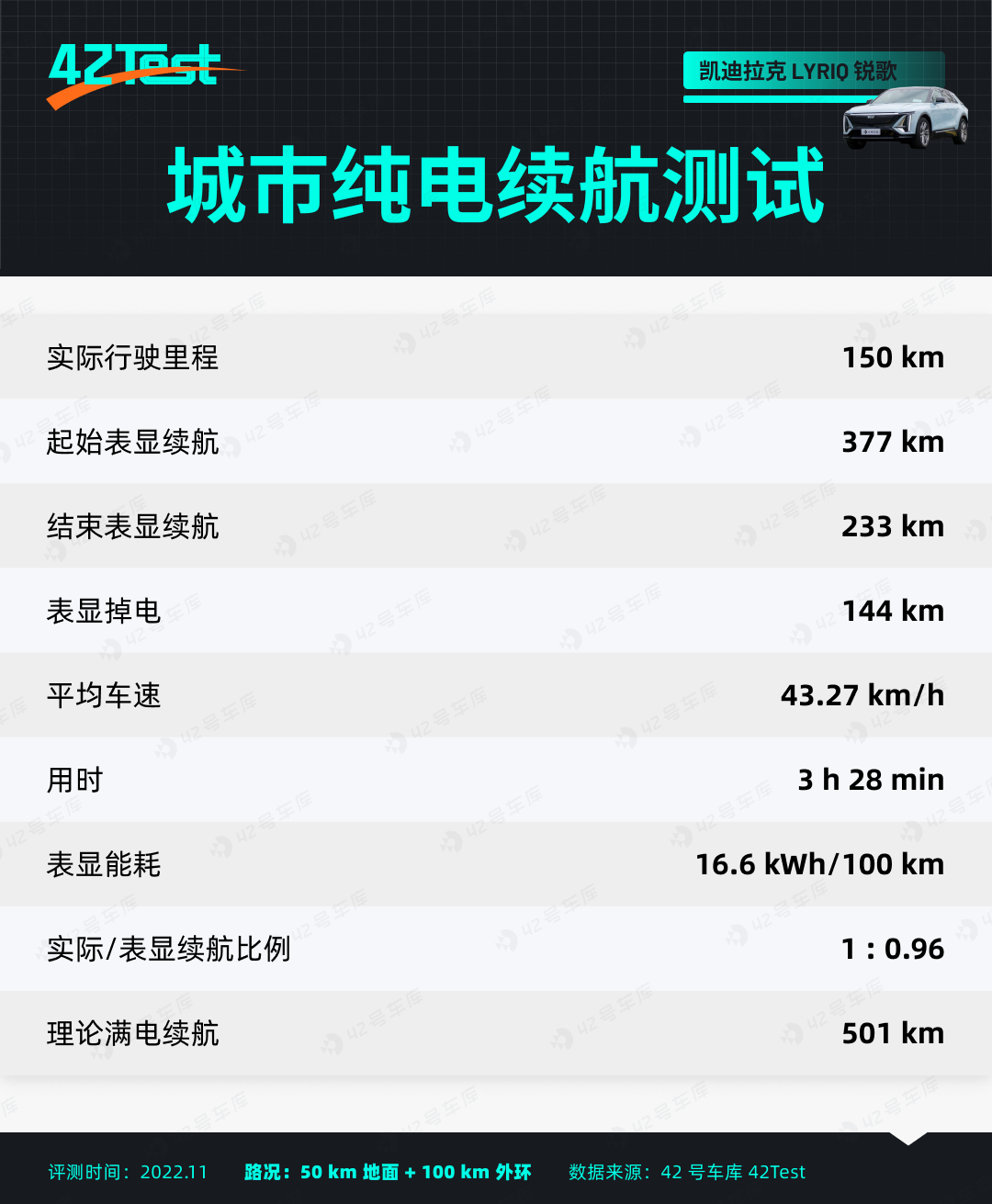
The dynamic average speed on ground roads within the first 50 km is 28.2 km/h. Due to frequent stops and starts along with traffic congestion, the displayed energy consumption remains at 17.7 kWh/100 km. In the latter 100 km, the average speed increases to 59 km/h, and energy consumption drops directly to 16.3 kWh/100 km.
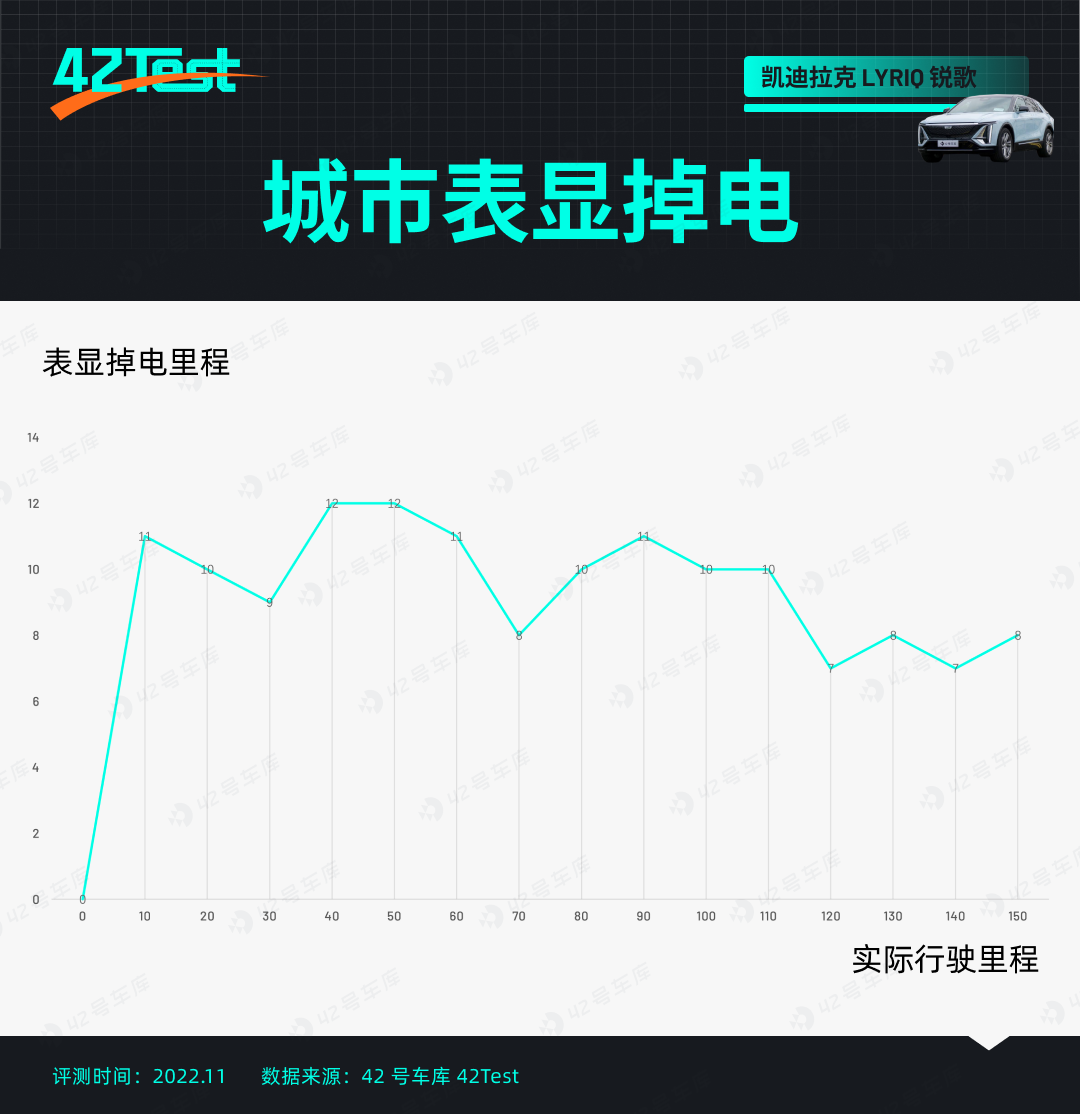
In these 150 km, the displayed range of the vehicle decreased by 144 km, even lower than the actual range. The actual/displayed range ratio is 1:0.96. Similarly, the rate of power loss is nearly 1:1. According to Cadillac engineers’ introduction, “before the displayed range drops below 30%, the vehicle will calculate the remaining range based on the user’s driving habits. However, after the remaining range drops below 30%, the proportion of instant power consumption will be increased.” Therefore, whether in the city or on the highway, LYRIQ’s range estimation can be trusted.
Charging: Persistent Peak Power
After fully depleting the LYRIQ’s battery, we conducted charging tests. According to SAIC-GM’s introduction, the Alt-n platform used in LYRIQ has been adapted to be compatible with most charging stations in China.
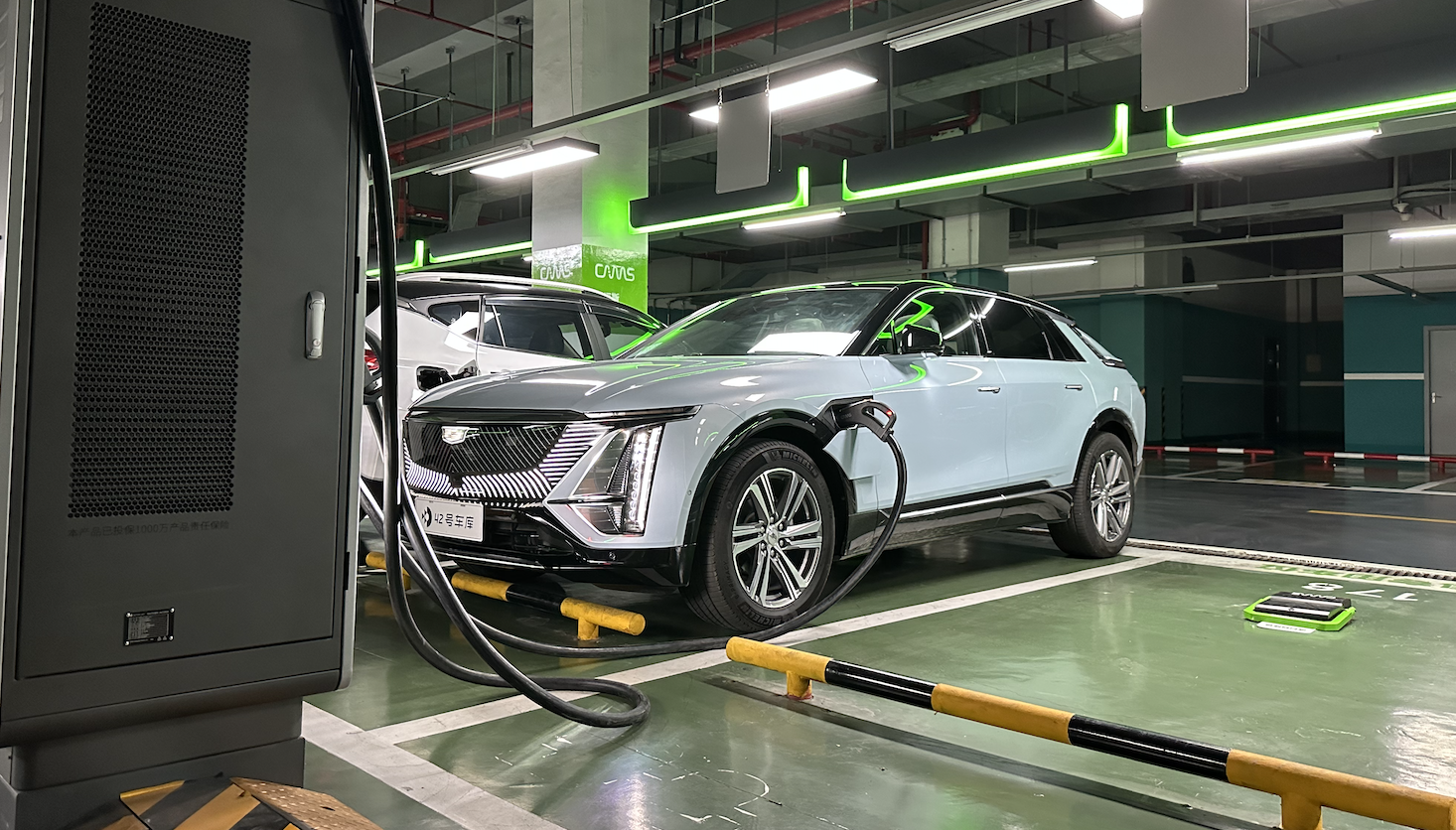
Therefore, we did not choose the official self-built supercharging station for testing. Instead, we chose Xiaojie’s 120 kW charging station, which has a maximum output current of 250 A.

Once the Cadillac LYRIQ was plugged in at 0%, the current directly went up to 249 A and the voltage was only 326 V due to the low state of charge (SOC). As the SOC increased, the power continued to climb along with the voltage until it reached the maximum power output of 93.7 kW during this charging cycle at 65%.When SOC reaches over 70%, the current starts to decrease, and the charging power gradually decreases too. The peak power can be sustained for a long time. Under the same charging station, the 100 kWh NIO ES7 cannot maintain maximum current and the power drops to 82 kW when SOC is at 40%.
During the entire charging process, LYRIQ did not experience a cliff-like drop, but always showed a gradual decline, with a power of 23.8 kW at SOC 95%. The 5% to 80% charging time was 50 minutes, and due to the large battery, it took 23 minutes from 80% to 95%.

Interestingly, we did not use the air conditioning or other accessories during the charging process, but the amount of electricity we obtained was 98.272 kWh, exceeding the official 95.7 kWh capacity. Under the same charging station, the 100 kWh NIO ES7 charged from 1% to 100% with only 89.98 kWh. This indirectly proves that LYRIQ has more available electricity. The excess charging is due to the loss that occurred during the charging process, which is a normal phenomenon.
It is worth mentioning that when LYRIQ’s battery is at 100%, the one-pedal driving mode can still be used normally, and the intensity of power recovery will not change. However, at this time, power recovery is not actually activated but simulated through the brake pedal.
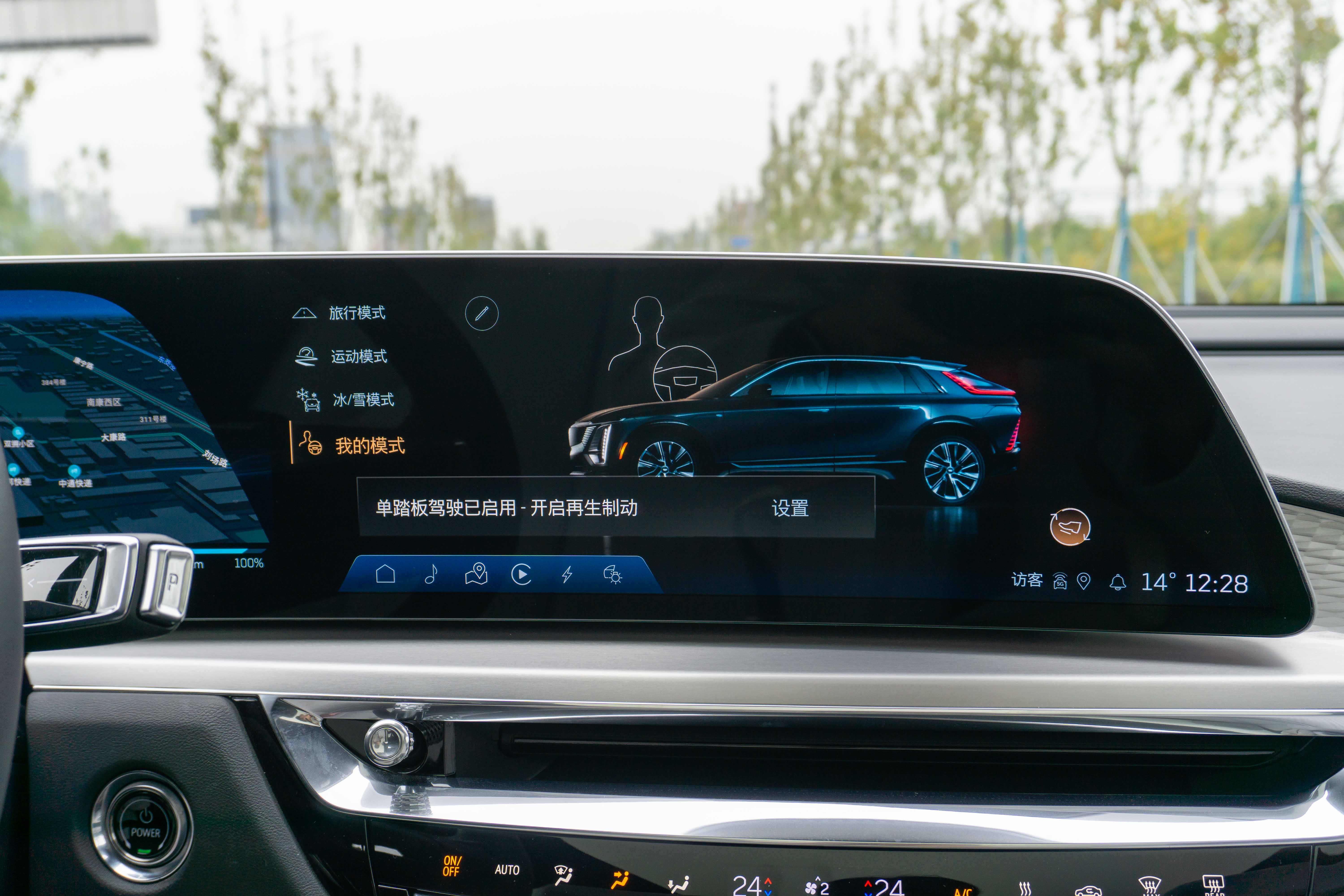
Interestingly, LYRIQ can also control the vehicle’s deceleration through the paddles on the left side of the steering wheel. In other words, you can use your hand to achieve “braking” and brake all the way to zero. The braking force depends on how hard you squeeze the paddle. It may be difficult to get used to at first, but it can be used safely after getting accustomed to it, although it cannot replace the brake in emergency situations. In terms of work principle, when the speed is high, deceleration is mainly achieved through regenerative braking, and the brake system is linked when the speed is low.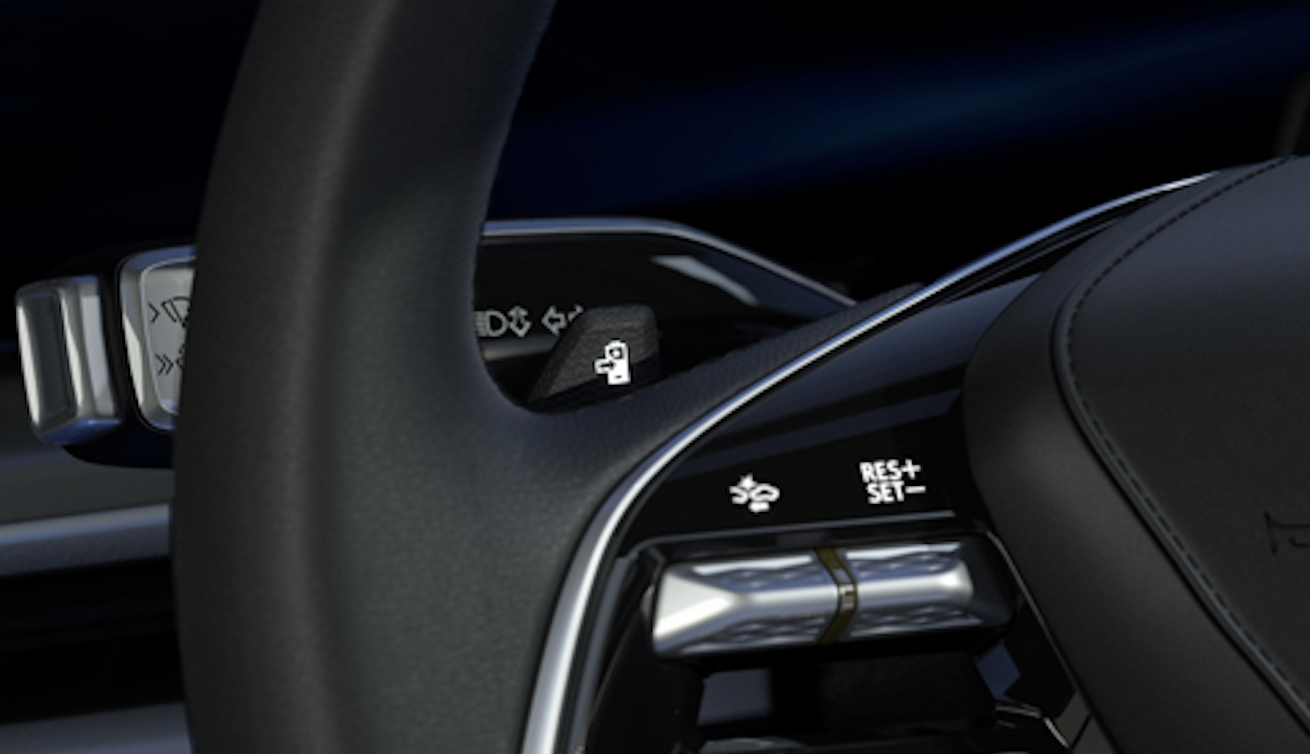
Driving: Steady and Stable
As a luxury brand with a history of 120 years, the Cadillac LYRIQ adheres to its consistent tuning style when it comes to driving experience.
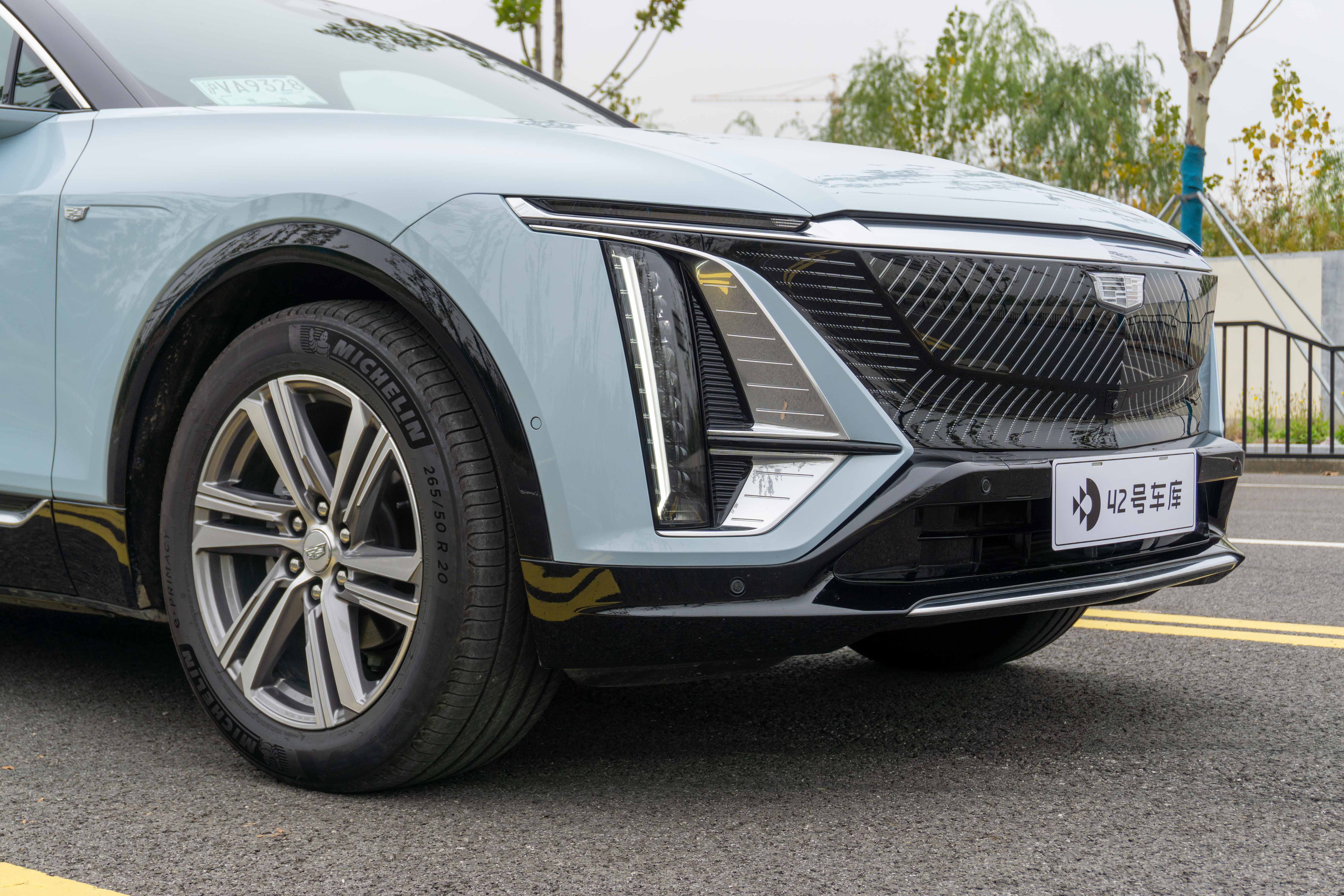
In terms of chassis, LYRIQ uses front/rear five-link independent suspension. Regardless of low-speed or high-speed scenarios, LYRIQ’s front and rear suspensions are perfectly coordinated. At low speeds, the steel spring support is robust and when the vehicle goes over speed bumps, there is a certain amount of bounce. However, the front and rear suspensions handle the vibrations consistently, and the rear axle won’t have a more obvious bouncing feeling.

In high-speed scenarios, the vehicle can isolate more road information and driving becomes noticeably comfortable. When going over bumpy roads, the vehicle’s handling is very tough and crisp, and this suspension system can dissipate most of the impact on the road, providing a premium chassis performance.

In terms of steering feel, although LYRIQ uses electronic power steering, it can still show a similar feel to hydraulic power steering while driving. For small partners who love driving, this kind of steering feel can win their hearts. Compared to its own XT5, LYRIQ’s steering is more precise and has a smaller dead zone in the central area of the steering wheel.
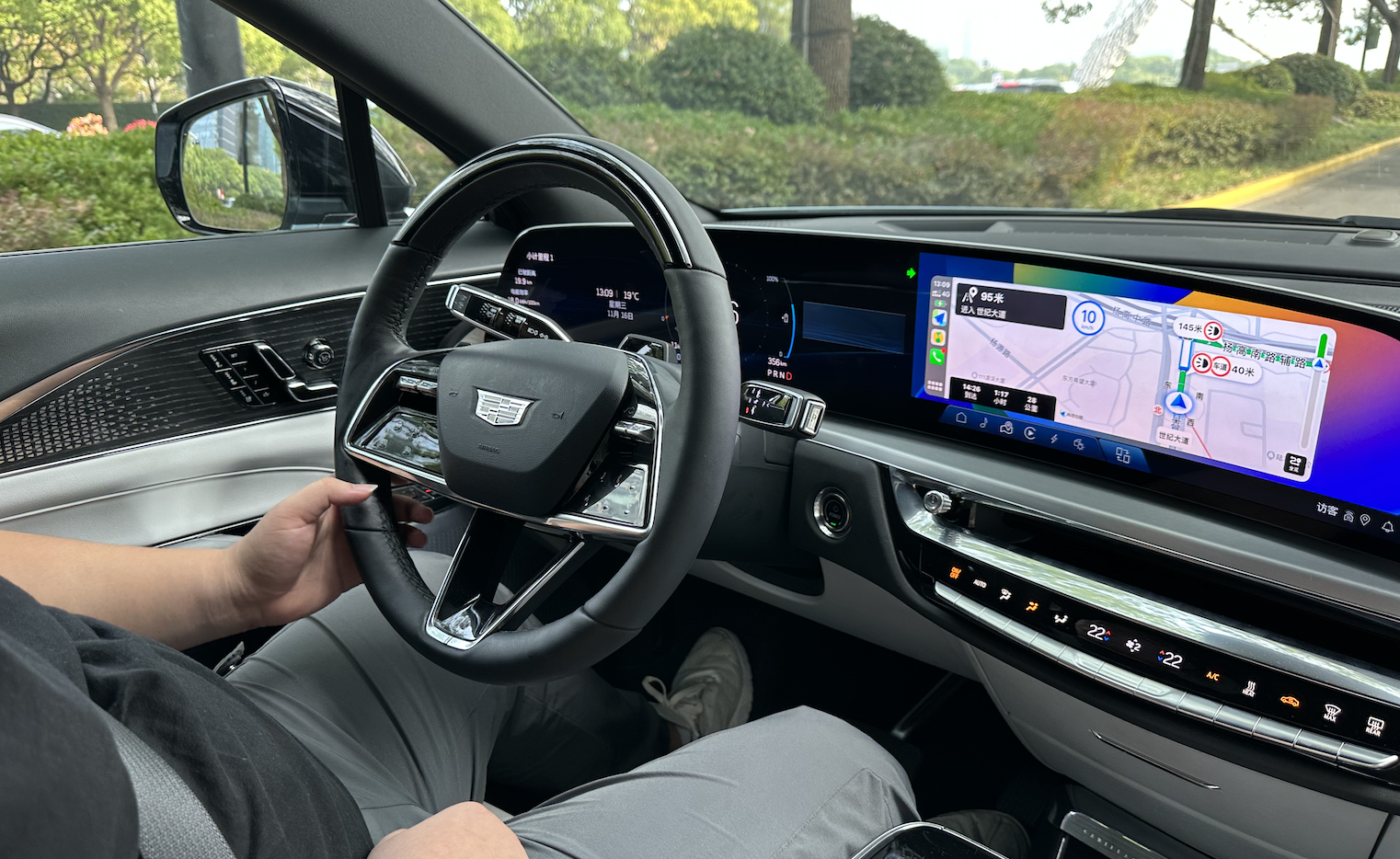
LYRIQ’s accelerator pedal tuning is also very much like a gasoline car. The power output in touring mode (comfort mode) is progressive. In sport mode, the response of the accelerator pedal is obviously faster and there is a simulated sound wave effect during acceleration. This simulated sound wave is denser and more dynamic than other brands, but compared to the tuning of BMW’s Hans Zimmer, it lacks some emotions and tension.
The fastest acceleration of Cadillac LYRIQ above SOC 80% is 6.30 seconds, and the average of ten times acceleration from zero to one hundred is 6.352 seconds, which is consistent with the official 6.35 seconds. Under daily driving, this acceleration result is enough to let you be the first to rush out of every intersection.
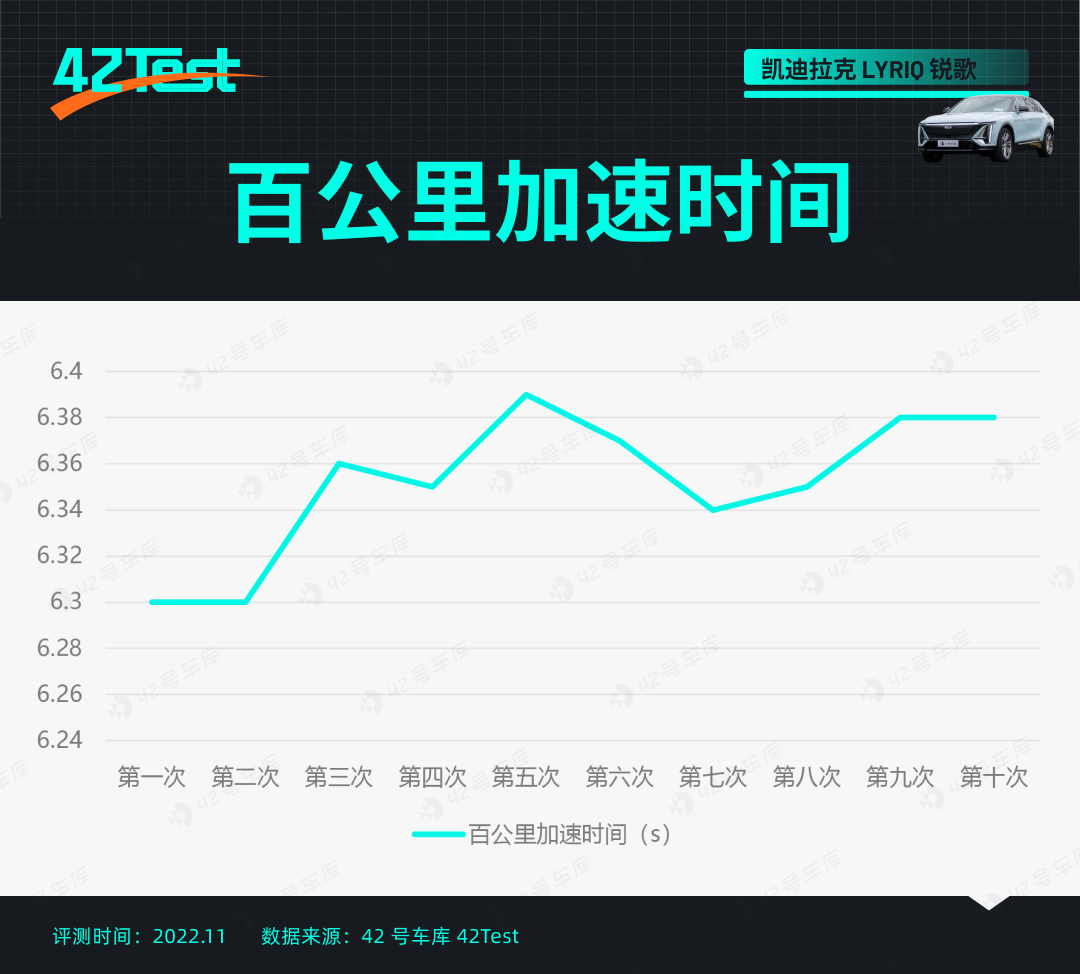
If you don’t think that 6.3 seconds to break one hundred is exciting enough, LYRIQ also offers a four-wheel-drive high-performance luxurious version that can break one hundred in 4.9 seconds.
Running fast also requires quick braking. It is a considerable challenge for the tires and brake system of this nearly 2.6-ton large vehicle to stop. After ten tests, the shortest 100-0 braking distance of LYRIQ is 36.09 meters, the longest is 37.46 meters, and the average of ten times braking result is 36.57 meters. For such a large vehicle, the braking force and durability can withstand the test.
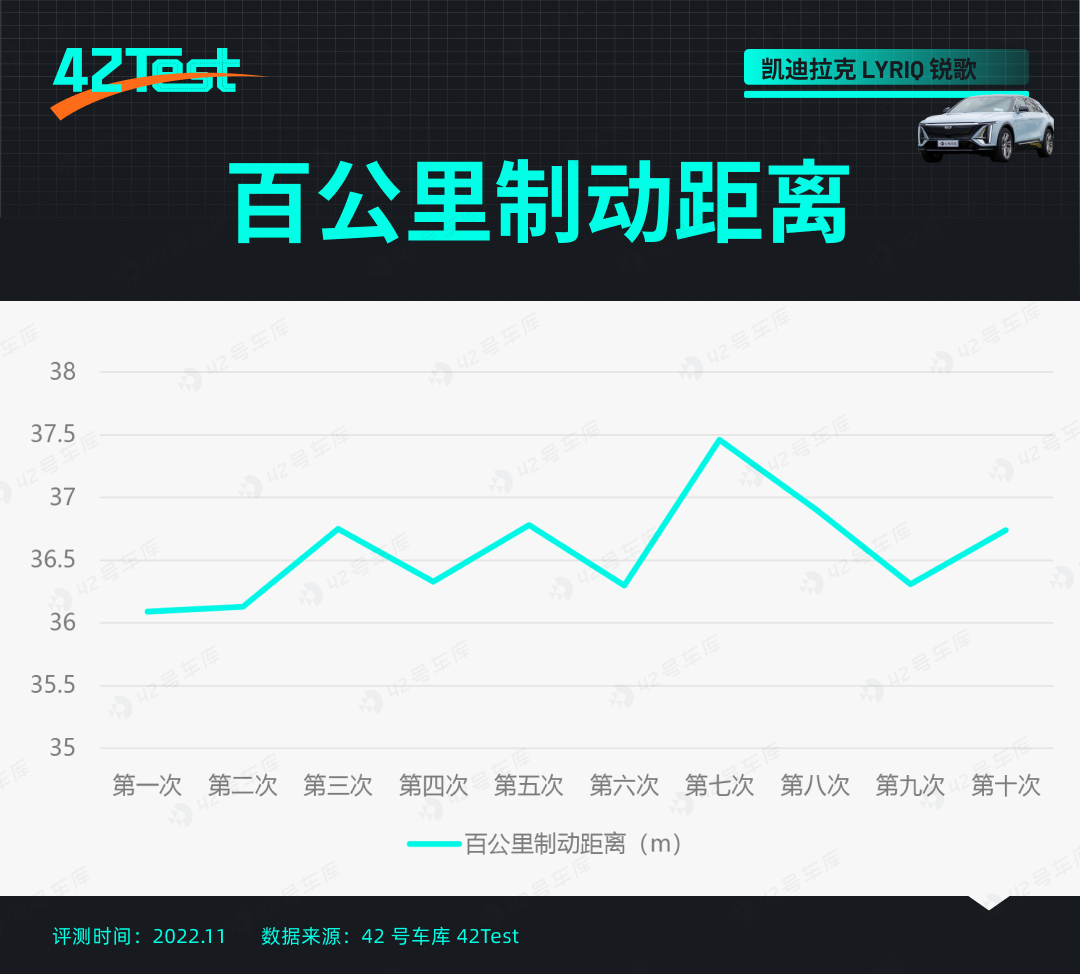
NVH: Quiet Performance
I still remember the first time I drove the Cadillac LYRIQ trial car, the quiet performance inside the car gave me a good first impression. After these days of in-depth experience, it once again confirmed my previous impression. It is difficult to express how good the NVH is in words, so I tested the noise performance in four different speeds using a decibel meter.
For each speed, we recorded three sections in the center of the car. The average decibel levels are 50.6 dB at 60 km/h, 52.5 dB at 80 km/h, 56.7 dB at 100 km/h, and 58.9 dB at 120 km/h. Whether compared with NIO ES7, Li Xiang L8, or executive car EQS, the interior noise of LYRIQ has a significant advantage.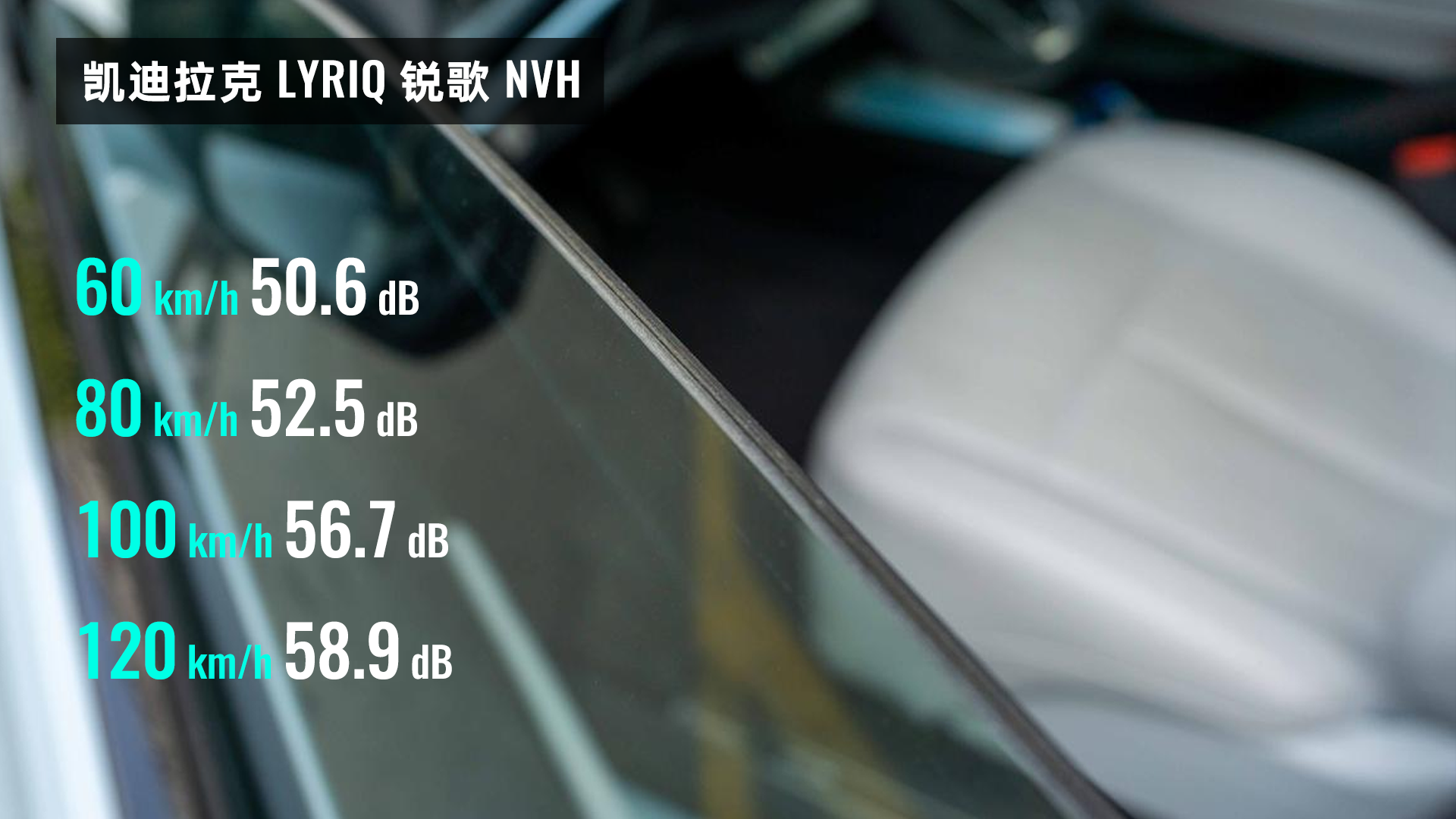
The main reason for this is not only the use of double-layer laminated glass in the front row, but also the active road noise control technology that Cadillac has always used. Without the engine, the road noise in the vehicle during driving will be particularly noticeable. LYRIQ uses Cadillac’s new generation of active noise reduction technology.
Four three-axis acceleration sensors are respectively placed at the four corners of the vehicle to monitor wheel vibration and shock. This set of signals will be transmitted to the noise reduction algorithm system to calculate a set of noise-cancelling waves, which are emitted through the speakers to cancel noise.

In addition, LYRIQ’s suppression of motor noise in the vehicle is also good. Under rapid acceleration and strong power recovery, it is not easy to be noticeable. In the process of daily use, members in the vehicle do not need to deliberately raise their voices when communicating, and even communication between the front and rear rows on high-speed roads is relatively calm.
ADAS: Waiting for OTA updates
Just during the General Motors Technology Outlook Day in 2022, SAIC-GM announced that it will push a new generation of Super Cruise advanced driving assistance system (ADAS) for LYRIQ before the Spring Festival next year, and adjust and optimize it for Chinese road scenes and driving habits.
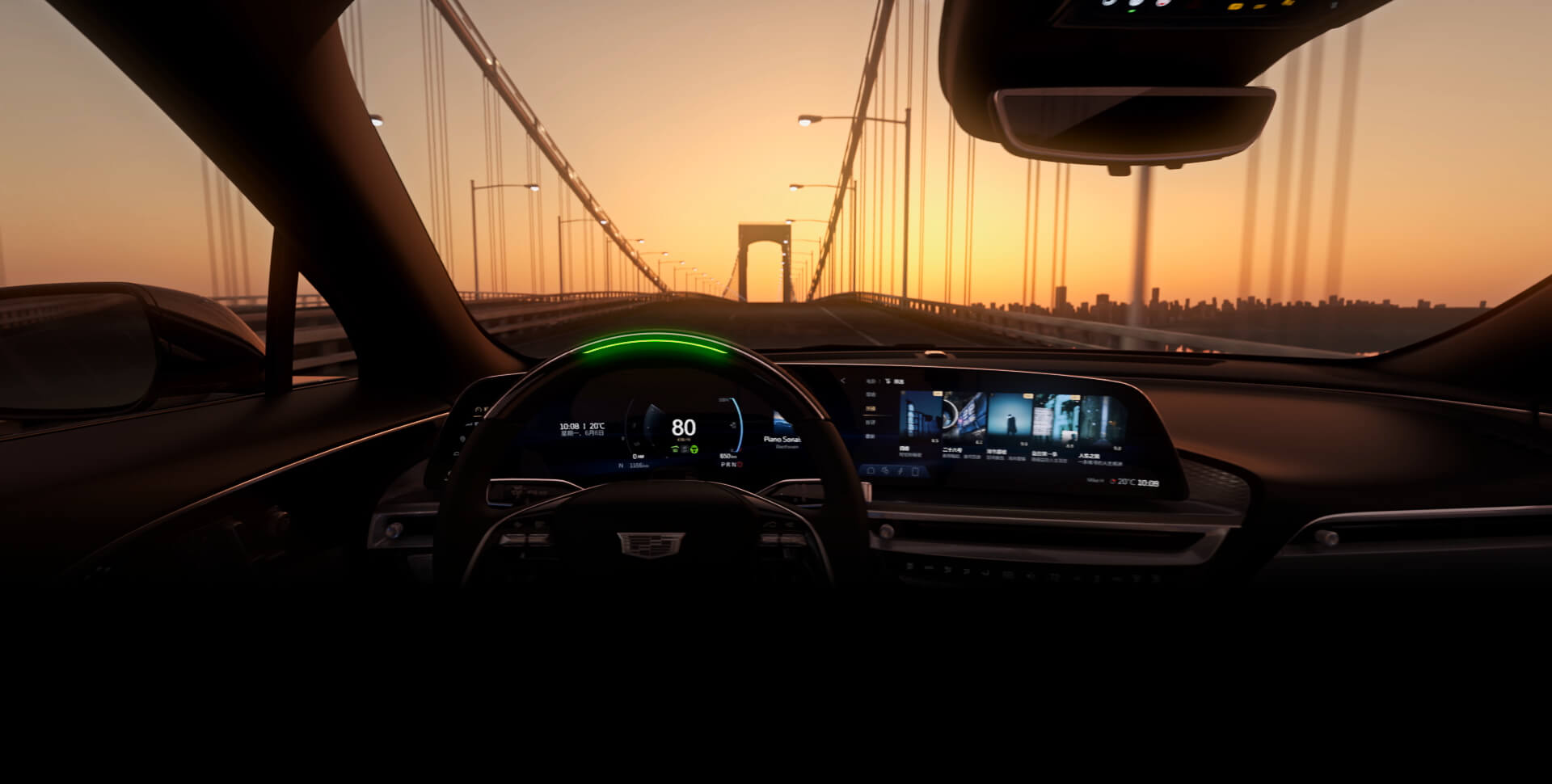
Therefore, at present, Super Cruise on the Cadillac LYRIQ cannot be activated, and the Super Cruise status indicator on the steering wheel cannot be lit. However, LYRIQ currently has the HoLCA (Hands on Lane Centering Assist) intelligent lane centering function, which is different from the speed range of Super Cruise from 0-147 km/h. HoLCA is only available within the range of 0-80 km/h.
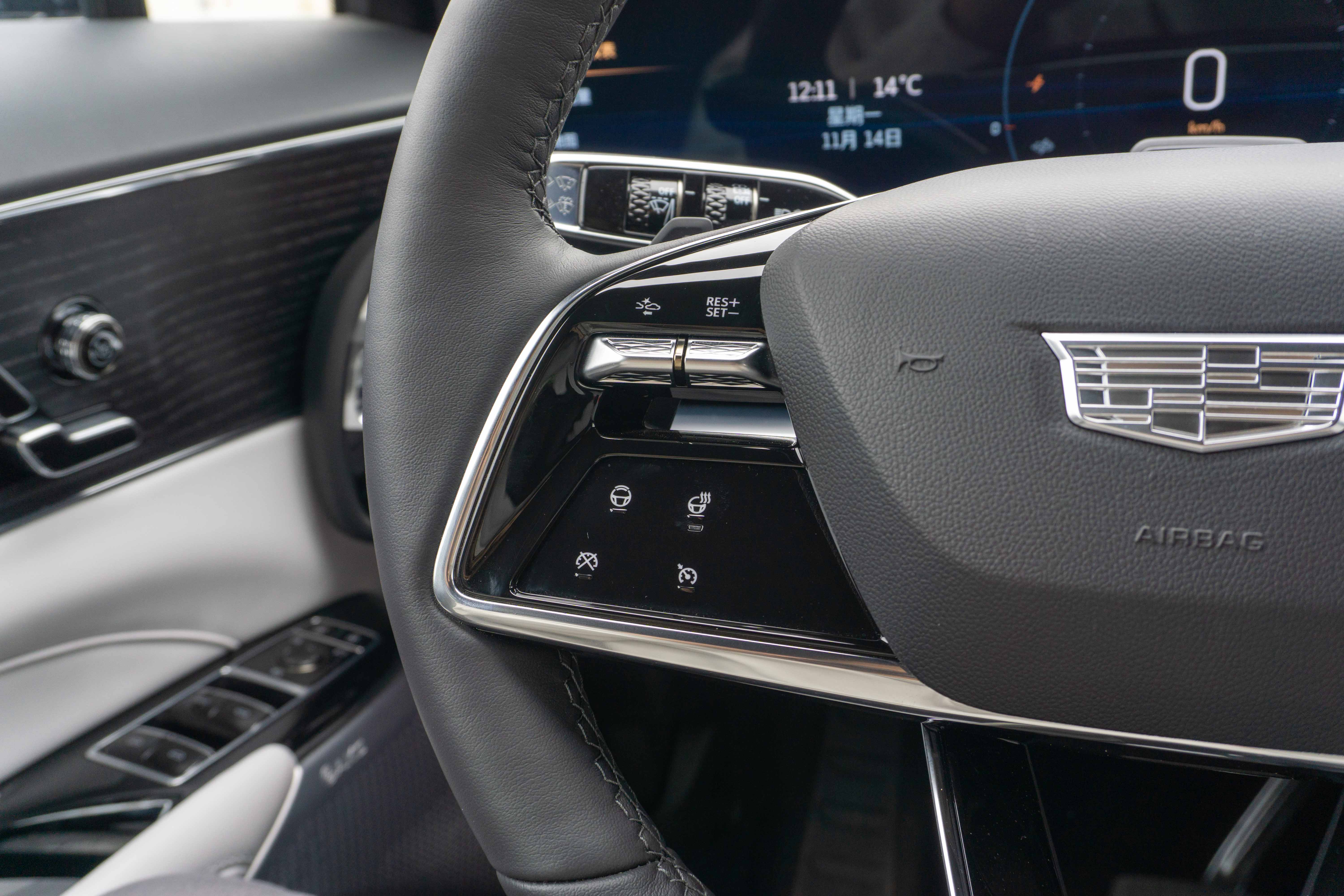 In terms of hardware, LYRIQ adopts the 1V6R scheme. It is equipped with a monocular vision camera and a Mobileye EyeQ4 visual processor in the front, as well as a long-range millimeter-wave radar on the front of the vehicle and a short-range millimeter-wave radar at each corner and at the center of the rear.
In terms of hardware, LYRIQ adopts the 1V6R scheme. It is equipped with a monocular vision camera and a Mobileye EyeQ4 visual processor in the front, as well as a long-range millimeter-wave radar on the front of the vehicle and a short-range millimeter-wave radar at each corner and at the center of the rear.
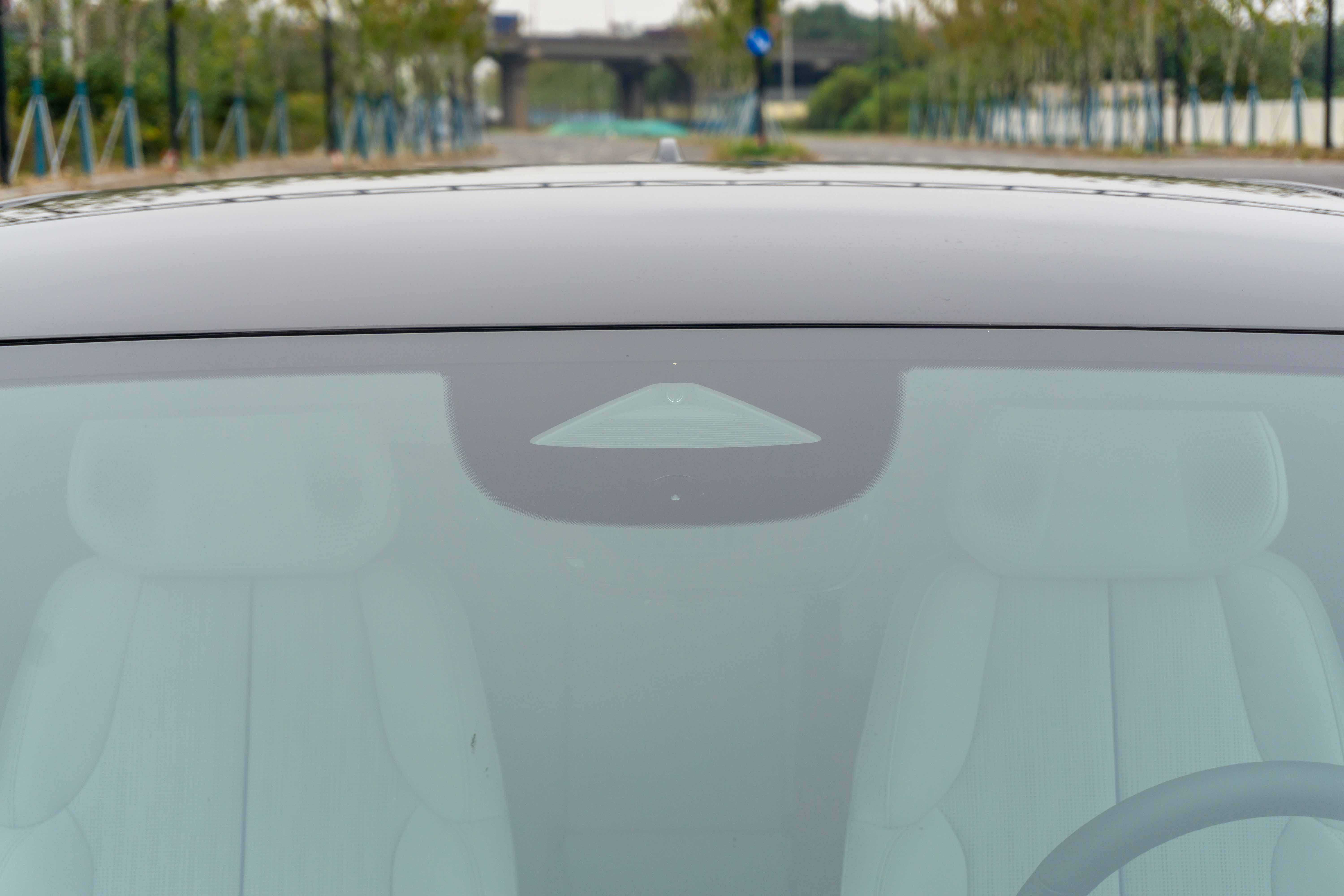
After enabling ACC+LCC, HoLCA will automatically activate this function if conditions are suitable. When HoLCA is activated, a green icon of a vehicle with a hand-held steering wheel will appear below the meter, and the ACC has three adjustable gears. To be frank, the closest gear has a relatively close distance to the vehicle in front, and the medium distance is the most appropriate for normal use.

HoLCA performs well in lateral control and stability at high speeds, but the maximum speed is only 80 km/h, so we cannot experience more challenging scenarios. In addition, there is no visual interface when HoLCA is activated, and the driver may take over when facing complex driving situations.
Therefore, we can look forward to the performance of the Super Cruise’s assisted driving capability of LYRIQ Reige OTA before the Spring Festival next year. If there is an opportunity, we will also try out the Super Cruise to see where the new generation differs and innovates.
In addition to the assisted driving function, LYRIQ’s active safety features are very sensitive. Especially during the parking process, AEB can brake in advance to avoid accidents. For experienced drivers, this may be a bit conservative, but it is crucial for new drivers.
When the vehicle detects an object that may collide in the rear blind spot, LYRIQ not only has sound and visual reminders like conventional vehicles, but the seat also vibrates. When there is danger on the left rear, only the left half of your butt will vibrate, and vice versa for the right side. This allows the driver to quickly determine where the danger is coming from.
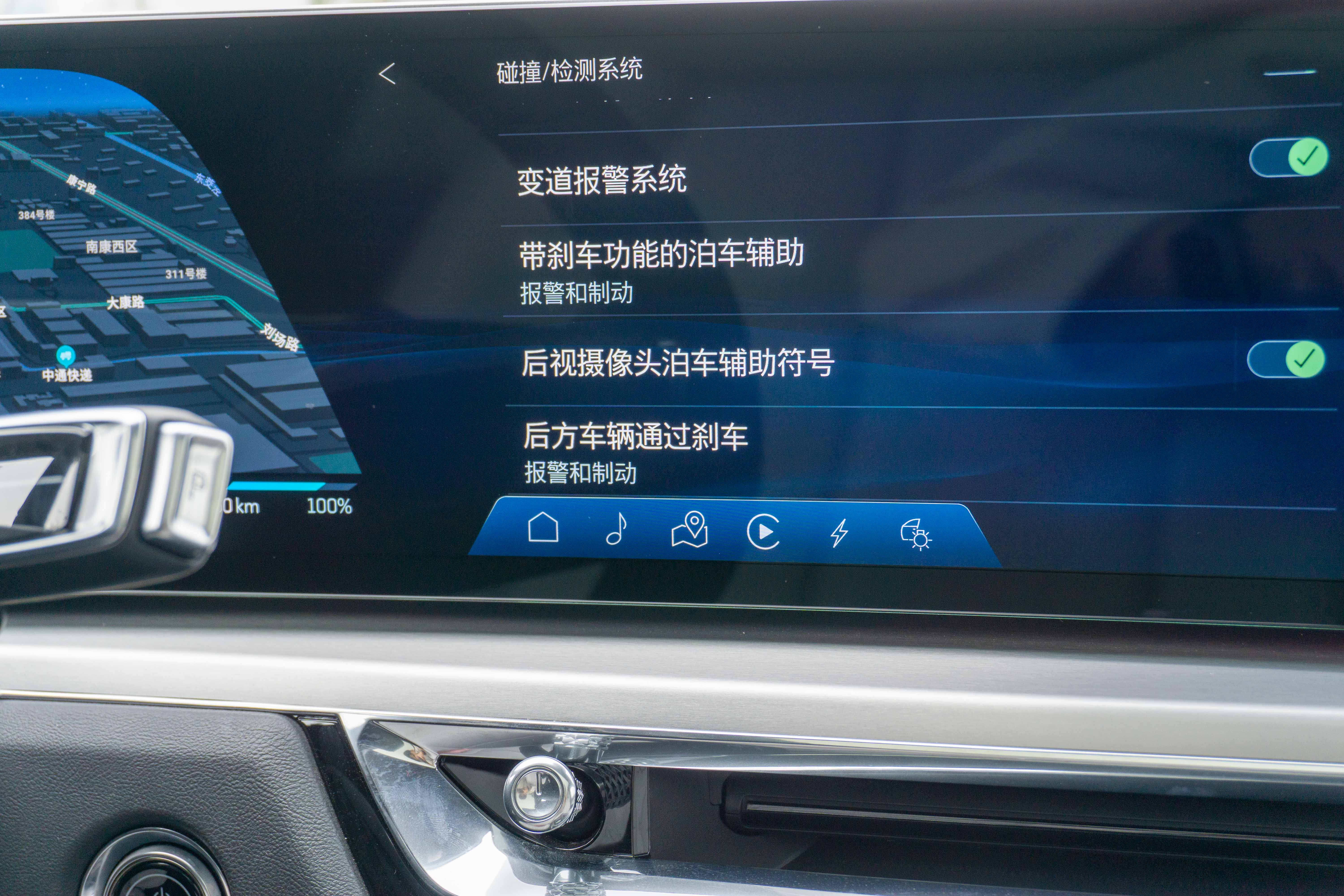
The sensitive AEB setting is also evidence of General Motors’ pursuit of zero accidents. In real-world scenarios, it can indeed provide an additional guarantee during driving.
Conclusion
Cadillac LYRIQ, as a luxury American brand with a 120-year history, maintains its original brand tone in terms of driving feel, basic performance, luxury design, and cabin quietness. Therefore, LYRIQ fully embodies the luxury sensation in places where users can feel it.
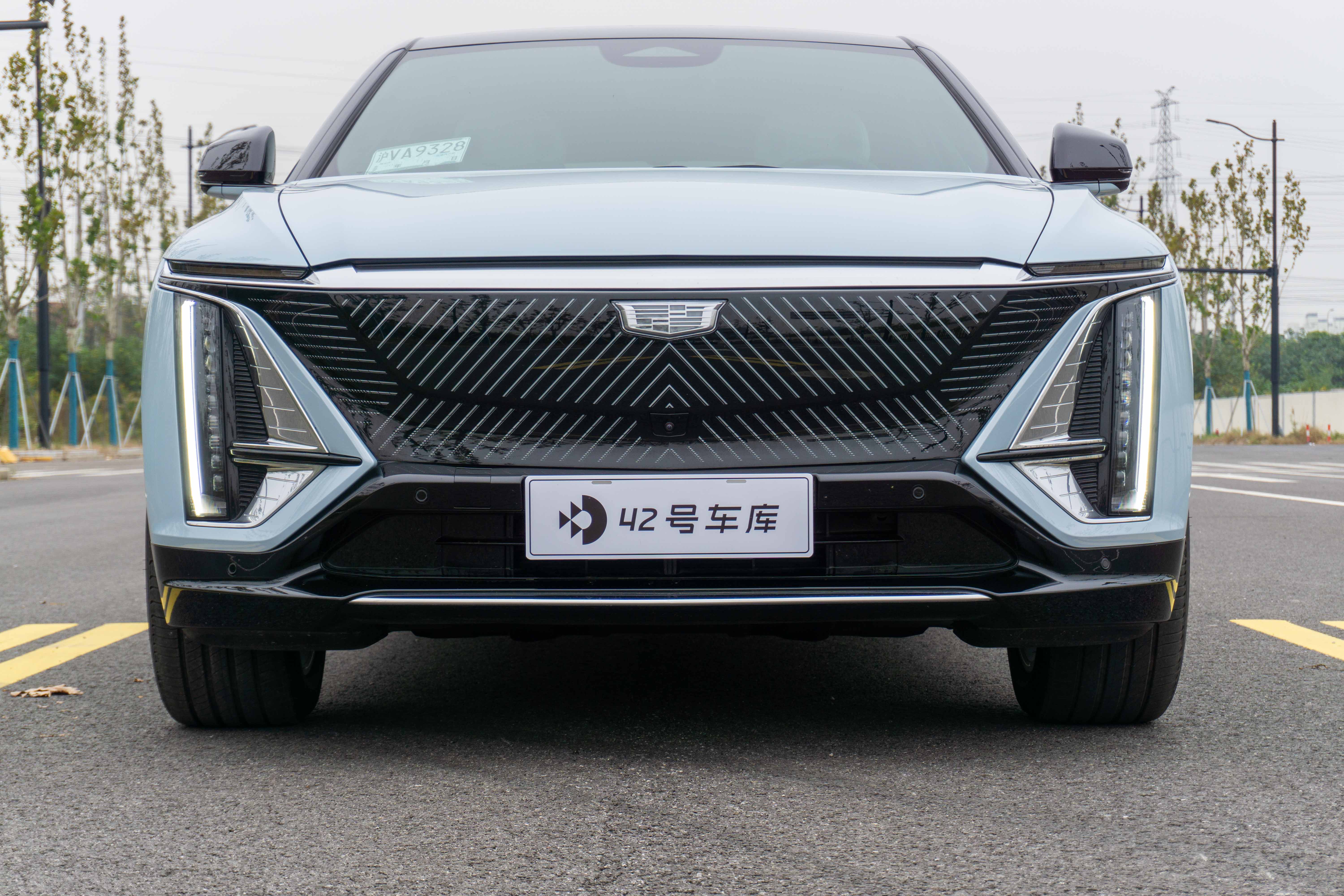
At the same time, in order to cater to the new era, LYRIQ has made innovative designs in appearance and interior, cleverly balancing both a sense of technology and Cadillac’s classic design. This allows users who previously liked Cadillac’s design and were used to the existing design to switch to the new model without too much learning cost.
Users who have the economic ability to spend 400,000 RMB on a medium-sized pure electric SUV are generally 30 or 40 years old and above, have families, and have certain economic capabilities. LYRIQ’s stability is consistent with this group of users.
However, as the spending power of young people increases, LYRIQ’s characteristics can also attract younger people. Recently, there have been more LYRIQs on the streets of Shanghai, and I have been intentionally or unintentionally looking at what kind of people are sitting inside the car. As a result, there are quite a few young people among the car owners I have seen.

Compared to new players in the market, Cadillac LYRIQ can meet consumers’ needs in terms of brand, quality, and basic vehicle quality. Compared to traditional automakers, LYRIQ has already used General Motors’ third-generation pure electric platform and has richer experience compared to automakers that are transitioning from gasoline to electric or trying pure electric models for the first time. In addition, with the wBMS technology, a tested high-speed endurance of 480 km, and a more expandable Ultium platform, it is clear that General Motors is putting more effort into pure electric vehicles.If you are looking for a luxury brand pure electric SUV with requirements for endurance, quality and appearance, and can compromise on intelligence at this stage, the Cadillac LYRIQ will be a good choice.
Fortunately, at the GM Tech Day in November, SAIC-GM decided to invest 70 billion yuan in the field of pure electric and intelligent network connection. The subsequent improvements on the Altium platform and intelligence will become the key to increasing sales. Because these technologies are also what young car buyers care about, and SAIC-GM also has determination in this regard.
This article is a translation by ChatGPT of a Chinese report from 42HOW. If you have any questions about it, please email bd@42how.com.
